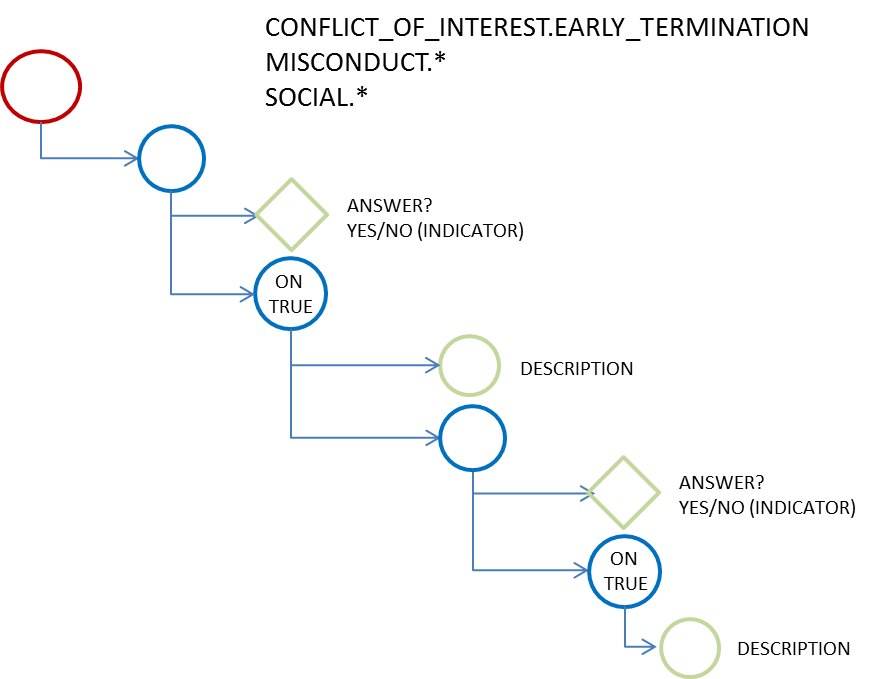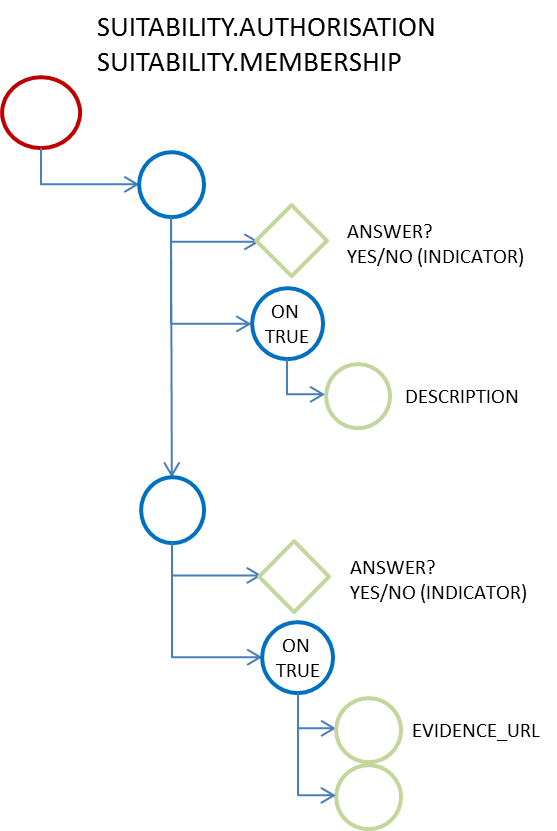I. Introduction
Context
The Directive 2014/24/EU and the ESPD
Article 59 of the new Public Procurement Directive 2014/24/EC (henceforth ''the Directive'') introduced a new concept, the European Single Procurement Document (ESPD) which is a self-declaration document intended for preliminary evidence in a public procurement procedure. By mapping out equivalent certificates between MS, the ESPD replaces certificates issued by public authorities or a third party involved in a procedure. It is thus a valuable facilitator for cross-border participation of a greater number of potential operators in public procurement procedures and a valuable tool for integrating the European Single Market.
The ESPD Service
In order to make full use of the ESPD concept, the European Commission has established an on-line service available for both suppliers and buyers. The main objective of the ESPD is to reduce the administrative burden and lead to considerable simplification of participation in public procurement procedures for buyers and suppliers. The service will reduce that burden by removing the need to produce a substantial number of certificates and documentation related to exclusion and selection criteria. This will answer to obstacles reported by many suppliers and especially SMEs.
The ESPD Service is currently in version 1.0 and can be accessed at this URL: https://ec.europa.eu/growth/tools-databases/espd/.
The electronic and structured ESPD XML documents
The ESPD Service was designed to provide the ESPD in a machine-readable structured format that will help solutions all over Europe to be interoperable. Aiming at this objective, DG GROW has developed a data model and artefacts.[1] for the exchange of the ESPD between any Procurement stakeholder’s system. This document illustrates in detail how to use these artefacts in compliance with the Directive.
The ESPD Service allows the Contracting Authorities (CA) and the Economic Operators (EO) to edit, import or export (and share) two types of electronic documents:
-
The ESPDRequest, a document that is sent by the Contracting Authorities to the Economic Operators;
-
The ESPDResponse, the document that is filled-in by the Economic Operators stating whether they fulfil or not the criteria required in the ESPDRequest, and providing the sources where evidences can be obtained to prove that the criteria are met by this EO.
As shown in the use case diagram below, the ESPD Documents are at the very core of the ESPD Service:
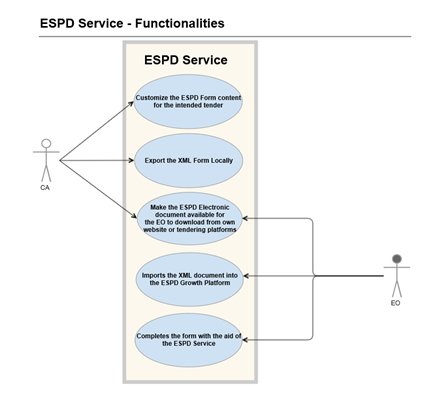
Objectives and target audience
The European Commission (COM) has defined a Data Model and XML vocabularies to express the ESPD documents that the ESPD Service exports and imports. However, these Data Models and XML Vocabularies are also intended to be used by any other systems that will use and/or exchange ESPD documents with other systems or in need to render its content into other formats or process them otherwise. This document explains and illustrates how to implement XML documents based on the Data Model and XSD Schema. We name this model "ESPD Exchange Data Model" (ESPD-EDM). The model is quite flexible and should cater for future different situations. That the model is flexible is to be considered good news, as it may be easily used for unforeseen needs. However the development of software applications and the interoperability between systems require concrete explicit directives and rules that guide the actual implementation of the ESPD XML documents as well as the interpretation of their content. This was the case for the implementation of the ESPD Request and ESPD Response XML documents that are currently used by the ESPD Service.
To sum up, this document is intended to facilitate the understanding of the model underlying the implementation of ESPD Response XML documents. With that objective in mind the reader is provided with examples and rules relating to how the content of an ESPD Response XML document SHOULD look like and be interpreted.
The content of this document is mainly addressed to the development teams from the Member States, Economic Operators, Information Providers or any other party interested in understanding how the ESPD Exchange Data Model works and how to use it to produce XML instances of the ESPD Request document.
Scope of this document
Contracts above the threshold and below the threshold
The Directive (namely Article 4) regulates in detail those public procurement procedures which values of contract exceed certain amounts. These amounts, also known as ''thresholds'', vary depending on the type of the contract and of the administration level of the contracting authority.
Those contracts that fall under this article 4 of the Directive are called contracts ''above the threshold'', and the rest are known as contracts ''below the threshold''.[2].
The ESPD-EDM is rich and flexible enough so as to allow ESPD instances for contracts above and below the threshold. However this document is oriented exclusively to illustrate how to create ESPD electronic documents for contracts above the threshold.
In-Scope
-
This document provides commented examples only on ESPD relating to contracts above the threshold
-
The explanations, examples, rules, recommendations, etc. only apply to the XML documents that intend to be compatible with the import and export features of the ESPD Service
Out-of-Scope
Many of the requirements and recommendations expressed in this document MAY NOT be valid for contracts below the threshold. However, from a purely technical point of view, the examples commented MAY be used to understand how the ESPD-EDM works and to create, in a normalized way, XML instances containing criteria for contracts below the threshold.
II. The ESPD Exchange Data Model
Design approach
The ESPD Exchange Data Model (ESPD-EDM) was designed to implement the data requirements expressed in the Annex 2 of the COMMISSION IMPLEMENTING REGULATION (EU) 2016/7 of 5 January 2016 (from now on "the Annex to the Regulation 2016/7"), establishing the standard form for the European Single Document. Additionally to these requirements, the model took also into account the Information Requirements Model specified by the CEN/BII-Workshops.[3] (namely Workshop 3), and the latest developments relating to the Virtual Company Dossier (VCD) in e-Sens.[4].
One premise that has ruled the design and implementation life-cycle of the ESPD-EDM has been ''not to reinvent the wheel''. Thus some very early key decisions were: (1) select a mature business language for the naming, design and implementation of the ESPD-EDM; (2) reuse as much as possible existing information components and libraries ''as-they-are''; (3) for those entities that are not defined in any standard specification, design new components in such a way that they can be reused in other situations and domains, both in e-Procurement and beyond e-Procurement.
OASIS UBL-2.1 standard was chosen as the best candidate to base the ESPD-EDM upon. The main reasons for this decisions were: (1) The European Commission is already using (and recommending) UBL-2.1 for e-Documents.[5] ; (2) Most of the concepts and components necessary for the ESPD documents were already defined by UBL specifically for e-Procurement; (3) Methodology and tools are available for the development of new documents, the extension of the existing UBL libraries, the semantic validation of XML instances, etc.
Data architecture overview
The ESPD Exchange Data Model re-uses three other models, that were defined in parallel to the ESPD, the Core Criterion Data Model, the Core Evidence Data Model, and the OASIS UBL-2.1 common information components.

This approach ended up in the development of a ''data architecture''; i.e. different layers of data components. The figure below presents a high-level view of this data architecture for the entire ESPD-EDM. The blocks coloured in green represent libraries of components defined by the UBL-2.1 Technical Committee (TC), whilst the rest have been defined from scratch by COM’s ESPD development team.
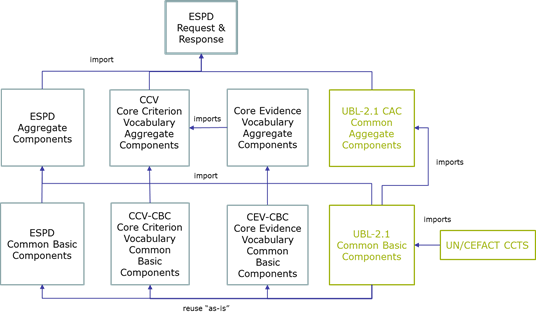
The blocks represented in the figure above represents either a document (e.g. ESPDRequest and ESPDResponse) or a library (the rest of the blocks). Per each document or library one XSD Schema has been implemented. Each Schema has been assigned its own namespace and a specific prefix representing the namespace.
The table below lists the file names corresponding to each block, schema, namespace and namespace-prefix.
| Data Package | XSD file names | Namespace | Prefix |
|---|---|---|---|
ESPDResponse |
/xsd/maindoc/ESPDResponse-1.0.xsd |
urn:grow:names:specification:ubl:schema:xsd:ESPDResponse-1 |
espd |
ESPD Aggregate Components |
/xsd/common/ESPD-CommonAggregateComponents-1.0.xsd |
urn:grow:names:specification:ubl:schema:xsd:ESPD-CommonAggregateComponents-1 |
espd-cac |
Core Criterion Vocabulary Aggregate Components |
/xsd/common/ESPD-CommonAggregateComponents-1.0.xsd |
urn:isa:names:specification:ubl:schema:xsd:CCV-CommonAggregateComponents-1 |
ccv-cac |
Core Evidence Vocabulary Aggregate Components |
/xsd/common/CEV-CommonAggregateComponents-1.0.xsd |
urn:isa:names:specification:ubl:schema:xsd:CEV-CommonAggregateComponents-1 |
cev-cac |
UBL-2.1 CAC Common Aggregate Components |
/xsd/common/UBL-CommonAggregateComponents-2.1.xsd |
urn:oasis:names:specification:ubl:schema:xsd:CommonAggregateComponents-2 |
cac: |
ESPD Common Basic Components |
/xsd/common/ESPD-CommonBasicComponents-1.0.xsd |
urn:grow:names:specification:ubl:schema:xsd:ESPD-CommonBasicComponents-1 |
espd-cbc: |
CCV-CBC Core Criterion Vocabulary Common Basic Components |
/xsd/common/CCV-CommonBasicComponents-1.0.xsd |
urn:isa:names:specification:ubl:schema:xsd:CCV-CommonBasicComponents-1 |
ccv-cbc: |
CEV-CBC Core Evidence Vocabulary Common Basic Components |
/xsd/common/CEV-CommonBasicComponents-1.0.xsd |
urn:isa:names:specification:ubl:schema:xsd:CEV-CommonBasicComponents-1 |
cev-cbc: |
UBL-2.1 Common Basic Components |
/xsd/common/UBL-CommonBasicComponents-2.1.xsd |
urn:oasis:names:specification:ubl:schema:xsd:CommonBasicComponents-2 |
cbc: |
The example below shows how these namespaces and prefixes are specified schemas of the in the ESPDResponse XSD Schema, as well as how the different layers of schemas specified in the ESPD-EDM data architecture are imported (see line 2 in ESPDResponse-1.0.xsd):
<xsd:schema xmlns="urn:grow:names:specification:ubl:schema:xsd:ESPDResponse-1" xmlns:espd="urn:grow:names:specification:ubl:schema:xsd:ESPDResponse-1" (1)
xmlns:espd-cac="urn:grow:names:specification:ubl:schema:xsd:ESPD-CommonAggregateComponents-1" (2)
xmlns:espd-cbc="urn:grow:names:specification:ubl:schema:xsd:ESPD-CommonBasicComponents-1" (3)
xmlns:ccv="urn:isa:names:specification:ubl:schema:xsd:CCV-CommonAggregateComponents-1" (4)
xmlns:cac="urn:oasis:names:specification:ubl:schema:xsd:CommonAggregateComponents-2" (5)
xmlns:cbc="urn:oasis:names:specification:ubl:schema:xsd:CommonBasicComponents-2" (6)
xmlns:ext="urn:oasis:names:specification:ubl:schema:xsd:CommonExtensionComponents-2" (7)
xmlns:xsd="http://www.w3.org/2001/XMLSchema"
targetNamespace="urn:grow:names:specification:ubl:schema:xsd:ESPDResponse-1" (8)
elementFormDefault="qualified" attributeFormDefault="unqualified" version="1.0"> (9)
<xsd:import namespace="urn:grow:names:specification:ubl:schema:xsd:ESPD-CommonAggregateComponents-1" schemaLocation="../common/ESPD-CommonAggregateComponents-1.0.xsd"/>
<xsd:import namespace="urn:grow:names:specification:ubl:schema:xsd:ESPD-CommonBasicComponents-1" schemaLocation="../common/ESPD-CommonBasicComponents-1.0.xsd"/>
<xsd:import namespace="urn:isa:names:specification:ubl:schema:xsd:CCV-CommonAggregateComponents-1" schemaLocation="../common/CCV-CommonAggregateComponents-1.0.xsd"/>
<xsd:import namespace="urn:oasis:names:specification:ubl:schema:xsd:CommonAggregateComponents-2" schemaLocation="../common/UBL-CommonAggregateComponents-2.1.xsd"/>
<xsd:import namespace="urn:oasis:names:specification:ubl:schema:xsd:CommonBasicComponents-2" schemaLocation="../common/UBL-CommonBasicComponents-2.1.xsd"/>
<xsd:import namespace="urn:oasis:names:specification:ubl:schema:xsd:CommonExtensionComponents-2" schemaLocation="../common/UBL-CommonExtensionComponents-2.1.xsd"/>
<xsd:element name="ESPDResponse" type="ESPDResponseType"/>
<xsd:complexType name="ESPDResponseType">
<xsd:sequence>
<xsd:element ref="ext:UBLExtensions" minOccurs="0"/>| 1 | "espd", default prefix representing the document ESPDResponse |
| 2 | "espd-cac", prefix for the Common Aggregate Components defined by COM for the ESPD, e.g. "espd-cac:EconomicOperatorParty" |
| 3 | "espd-cbc", prefix for the Common Basic Components defined by COM for the ESPD, e.g. "espd-cbc:SMEIndicator" |
| 4 | "ccv", prefix for the Core Criterion Vocabulary elements, e.g. "ccv:Criterion" (elements belonging to the Core Evidence Vocabulary are used by |
| 5 | "cac", prefix for the Common Aggregate Components defined in UBL-2.1, e.g. "cac:ContractingParty" |
| 6 | "cbc", prefix for the Common Basic Component defined in UBL-2.1, e.g. "cbc:TypeCode" |
| 7 | "ext", default prefix defined in UBL-2.1 for non-standard extensions of the schema (see OASIS UBL-TC documentation) |
| 8 | targetNamespace matching to the default schema namespace, aligned to UBL practice |
| 9 | use of "qualified", "unqualified" and "version" defaults aligned to the best practices, as in UBL |
This other example below illustrates the header of an ESPD Response XML document instance that implements the namespaces of the above schema:
<espd:ESPDResponse
xmlns:espd="urn:grow:names:specification:ubl:schema:xsd:ESPDResponse-1"
xmlns:espd-cac="urn:grow:names:specification:ubl:schema:xsd:ESPD-CommonAggregateComponents-1">
xmlns:espd-cbc="urn:grow:names:specification:ubl:schema:xsd:ESPD-CommonBasicComponents-1"
xmlns:ccv="urn:isa:names:specification:ubl:schema:xsd:CCV-CommonAggregateComponents-1"
xmlns:ccv-cbc="urn:isa:names:specification:ubl:schema:xsd:CCV-CommonBasicComponents-1"
xmlns:cev-cbc="urn:isa:names:specification:ubl:schema:xsd:CEV-CommonBasicComponents-1"
xmlns:cev="urn:isa:names:specification:ubl:schema:xsd:CEV-CommonAggregateComponents-1" (1)
xmlns:cac="urn:oasis:names:specification:ubl:schema:xsd:CommonAggregateComponents-2"
xmlns:cbc="urn:oasis:names:specification:ubl:schema:xsd:CommonBasicComponents-2"
xmlns:ext="urn:oasis:names:specification:ubl:schema:xsd:CommonExtensionComponents-2">
<cac:ContractingParty>
<cac:Party>
<cac:PartyName>
<cbc:Name>Executive Agency ...
<ccv:Requirement responseDataType="EVIDENCE_URL">
<cbc:ID schemeID="CriterionRelatedIDs" schemeAgencyID="EU-COM-GROW" schemeVersionID="1.0">03bb1954-13ae-47d8-8ef8-b7fe0f22d700</cbc:ID>
<cbc:Description>URL</cbc:Description>
<ccv:Response>
<cev:Evidence> (1)
<cev:EvidenceDocumentReference>
<cbc:ID>6e9aa856-836e-4c9e-a74b-b7c63cba91b8</cbc:ID>
<cac:Attachment>
<cac:ExternalReference>
<cbc:URI>http://kbopub.economie.fgov.be/kbopub/zoeknummerform.html?lang=en&nummer=0825+811+478&actionLu=Zoek</cbc:URI>
</cac:ExternalReference>
</cac:Attachment>
</cev:EvidenceDocumentReference>
</cev:Evidence>
</ccv:Response>
</ccv:Requirement>| 1 | Notice that in the XML instance namespaces that are not referred to in the XSD schema of the ESPDResponse document are needed as they instantiate elements from other inner schemata of the data architecture, e.g. "cev:Evidence" |
The Core Criterion and Core Evidence Data Models and Vocabularies
When creating a new ESPD Request XML document, the Contracting Authority (CA) [6] specifies the series of exclusion and selection ''criteria'' that the Economic Operator (EO) has to satisfy for a specific Procurement Project. In the ESPD Response, the EO MAY provide where to get evidences that prove it satisfies the criteria required by the CA.
Two new data models were defined from scratch by the European Commission (COM), the Core Criterion Data Model and the Core Evidence Data Model. Once implemented as XSD schemata these Data Models are named ''Core Criterion Vocabulary'' and ''Core Evidence Vocabulary''. Both Data Models (and therefore the vocabularies too) are interrelated. The figure below shows a (high-level) simplified overview of these two data models and how they interrelate.
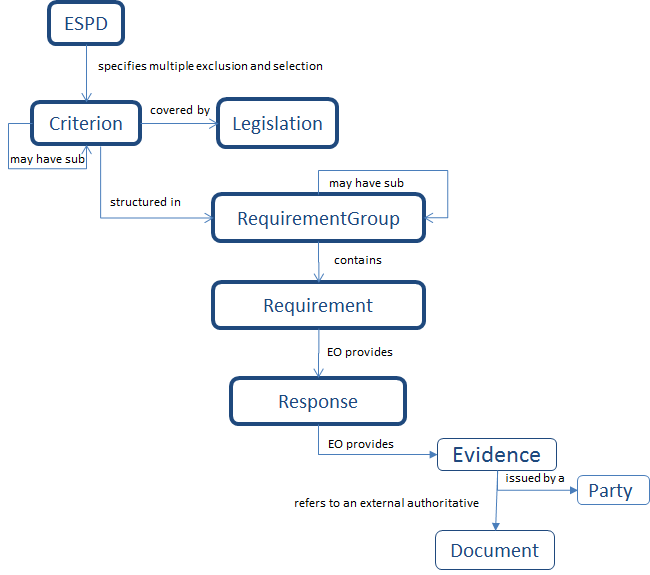
The Core Criterion and Core Evidence Data Models were designed to be reused in cross-border and cross-sector interoperability. In other words, they are ''business agnostic''. Two domains where the concepts Criterion and Evidence are relevant are the e-Certis and ESPD Services. Therefore these two domains (and systems) have been originally used as Study/Business Cases for the development and testing of the Core and Evidence Data Models and Vocabularies. During the development other cases in other business domains were identified as potential re-users of the Core Vocabularies (e.g. CAMSS, Common Assessment Method for Standards and Specifications or the Grants Assessment System, both developed by COM; amongst other).
The ESPDResponse uses the complete set of elements defined in the CCV and the CEV (i.e. the ones depicted in the high-level diagram above).
From the modelling perspective the main difference between the ESPDRequest and the ESPDResponse is that the ESPDRequest does not use the Response element, and therefore neither the XML Core Evidence Vocabulary. Thus, for the ESPDRequest, the model represented above in Figure above is reduced into this other one below:

III. The ESPDResponse XML document
Data Model overview
The UML Diagram below provides a simplified view of the ESPDResponse document. Notice that the classes herein represented belong to different data-packages. Hence each class name is preceded by different prefixes representing their corresponding namespaces: "espd::", "ccv::", "cev::", "cac::" (see '' Table 1. Schemas, namespaces and prefixes used by the ESPDResponse''). [7]

As you can see in the diagram more than 50% of the classes were already defined in UBL-2.1 (cac-prefixed classes). Moreover, many of the "root" elements in the espd:ESPDRequest class reuse UBL-2.1 Common Basic Components. This document does not represent nor describe in its entirety the entities modelled in UBL that are re-used in the ESPD. Any detail on the model, schemata, and any other artefact relating to UBL-2.1 can be freely downloaded here: http://docs.oasis-open.org/ubl/os-UBL-2.1/UBL-2.1.html. Nonetheless those parts of the UBL components that are commonly used in the ESPD documents are herein sufficiently identified and commented.
This other figure below shows a graphical view of the XSD Schema implementation corresponding to the above UML diagram.

According to the UML Diagram an ESPDResponse XML document is represented by the class espd:ESPDResponse.
This ''root'' class aggregates other classes (which in turn aggregate sub-classes).
The list below summarises the use of each of these classes. Further on, in this document,
each class is analysed and illustrated in more detail:
-
The
cac:ContractingParty, defined in UBL-2.1, is used to specify data relating the Contracting Authority, Body or Entity. All ESPD Requests MUST provide some basic data about the Contracting Body. -
The
espd:EconomicOperatorclass is defined by COM as a placeholder for all the data related to the Economic Operator. This class aggregates an espd:RepresentativeNaturalPerson class intended to gather the data of the legal representatives of the EO. It also reuses the UBL-2.1 cac:Party class. -
The
cac:ProcurementProjectLotclass was also defined in UBL-2.1 to hold data about the Lots in which a Procurement Project has been divided. The ESPD Request XML documents MUST use this class to specify whether the Procurement Project has lots or not and to identify them. Although the ESPD-EDM model was designed to support multiple lots, the current version of the ESPDService, however, still does not fully uses this feature and permits only to describe them. -
The
ccv:Criterionclass belongs to the Core Criterion Vocabulary data-package, thus the ccv: prefix.[8] . It is a compulsory element of multiple cardinality allowing for the specification of both the exclusion and selection criteria in an ESPD Request. -
cac:ServiceProviderPartyis a specialisation of the cac:Party class, both defined in UBL-2.1. It is used to inform about the party responsible of the system that provided the data included in the document; e.g. a pre-qualification system, a procurement platform, etc. The absence of this element indicates that the data has been provided by the Economic Operator itself. -
cac:Signatureclass is used to include an electronic signature in the document. In general, the presence of an electronic signature aims at ensuring authenticity, integrity and non-repudiation. Different methods of signing an electronic document exist, and some of them do not need embedding the signature in the document. The cardinality 0..1 of this class in theespd:ESPDRequestdocument allows the use of other electronic signature methods that do not imply the use of this class in an ESPD Request XML document. Therefore, the absence implies that authentic, integrity, etc. are solved by other means. -
cac:AdditionalDocumentReferenceis used to include external references to information that can be accessed from a URL. In contracts above the threshold this element is used by the CA in the ESPDRequest to refer to the Contract Notice published in TeD. Other documents or information accessible through a URL that might be considered relevant MAY be specified by the Contracting Authority (in the ESPDRequest) or by the EO (in the ESPDResponse) through the use of multiple instances of this element.
The next sections deal with the specific details of each one of these classes and provide guidelines, rules and examples on how to produce XML documents that are conformant with the ESPD Service ESPDResponse XML document and for contracts above the threshold.
|
All the reference data artefacts in a bunch file
The text and tables below (about the classes, properties and attributes of the ESPD-EDM model) make reference to code lists, which use is compulsory in many cases. These references provide links to the specific code lists therein referred to. The links allow for the downloading of a PDF file with the metadata about the list and the values and descriptions of each code. Click on the links to download and examine the code list you are interested in. The ESPD Service uses Schematron and the OASIS Genericode 1.0 specification for the validation of externalised codes. If you need the Genericode files you can download them altogether, jointly with the code lists PDF files, from this zip volume. |
Root properties
The ESPDResponse main class represents the entire ESPDResponse documents. All the data (root properties) of the document "hang" directly from the class or are other classes associated to it.
As for all documents designed upon the UBL-2.1 Naming and Design Rules (NDR), this main class uses several UBL-2.1 common basic components. Although most of them are optional the ESPD Service expects the following ones:
| Property | Description | Example | Mandatory? | Rules & comments |
|---|---|---|---|---|
cbc:UBLVersionID |
Identifies the earliest version of the UBL 2 schema for this document type that defines all of the elements that might be encountered in the current instance |
|
OPTIONAL (0..1) |
|
cbc:CustomizationID |
Identifies a user-defined customization of UBL for a specific use. |
|
OPTIONAL (0..1) |
|
cbc:CopyIndicator |
Indicates whether this document is a copy (true) or not (false) |
|
OPTIONAL (0..1) |
|
cbc:VersionID |
Indicates the current version of this ESPDResponse XSD Schema |
|
OPTIONAL (0..1) |
|
cbc:IssueDate |
The date, assigned by the sender, on which this document was issued |
|
MANDATORY (1..1) |
|
cbc:IssueTime |
The time, assigned by the sender, at which this document was issued |
|
OPTIONAL (0..1) |
|
cbc:ID |
An identifier for this document, assigned by the sender |
|
MANDATORY (1..1) |
|
cbc:ContractFolderID |
An identifier, assigned by the sender, for the process file (i.e., record) to which this document belongs |
|
MANDATORY (1..1) |
|
Associated classes |
||||
ext:UBLExtensions |
A container for all ad-hoc (non standard) extensions present in the document. |
OPTIONAL (0..1) |
|
|
cac:ContractingParty |
The contracting authority or contracting entity who is buying supplies, services or public works using a tendering procedure as described in the applicable directive (Directives 2014/24/EU, 2014/25/EU). |
MANDATORY (1..1) |
|
|
espd-cac: EconomicOperatorParty |
Any natural or legal person or public entity or group of such persons and/or entities, including any temporary association of undertakings, which offers the execution of works and/or a work, the supply of products or the provision of services on the market. Information about the party submitting the qualification. |
MANDATORY (1..1) |
|
|
cac:ProcurementProjectLot |
One of the parts of a procurement project that is being subdivided to allow the contracting party to award different lots to different economic operators under different contracts |
MANDATORY (1..n) |
|
|
ccv:Criterion |
A condition that the economic has to meet in order to not be excluded and be selected as a candidate for awarding in a procurement procedure. |
MANDATORY (1..n) |
|
|
cac: ServiceProviderParty |
The organisation that provided the data about the procurement project, the Contracting Authority and/or the Economic Operator |
OPTIONAL (0..1) |
|
|
cac:Signature |
The signature of the Economic Operator or of its representative |
OPTIONAL (0..n) |
|
|
cac: AdditionalDocumentReference |
A reference to an additional document |
OPTIONAL (0..n) |
|
|
Additionally to the above properties, the ESPDResponse XSD Schema defines other root properties that the class ESPDResponse does not uses currently. If you use them in your own XML documents the ESPD Service will skip them (i.e. no exception would be thrown).
| Property | Description | Example | Mandatory? | Rules & comments |
|---|---|---|---|---|
espd-cbc: Economic Operator GroupName |
The name of the Consortium or group to which the Economic Operator belongs for a specific procurement project |
|
OPTIONAL (0..1) |
Comments: This property is not used (yet) by the ESPD Service. Future releases will take it into account |
cbc:PreviousVersionID |
Indicates the version immediately previous to the earliest version of this ESPDResponse XSD Schema |
|
OPTIONAL (0..1) |
|
cbc:ProfileID |
Identifies a user-defined profile of the customization of UBL being used |
|
OPTIONAL (0..1) |
Comment: Example source http://www.datypic.com/sc/ubl21/e-cbc_ProfileID.html |
cbc:ProfileExecutionID |
Identifies an instance of executing a profile, to associate all transactions in a collaboration |
|
OPTIONAL (0..1) |
Comment: Example source http://www.datypic.com/sc/ubl21/e-cbc_ProfileExecutionID.html |
cbc:UUID |
A universally unique identifier for an instance of this document |
|
OPTIONAL (0..1) |
Comment: Example source http://www.datypic.com/sc/ubl21/e-cbc_UUID.html |
UBLExtensions element
The UBL 2 Naming and Design Rules (NDR) establish that the first element of a
UBL-conformant XML document should be ext:UBLExtensions element. If used the
UBLExtensions MUST instantiate one or more UBLExtension sub-elements.
The current version of the ESPDResponse documents does not UBLExtensions, but you could use it for your own internal purposes. If specified in an XML document the ESPD Service would skip it.
According to the UBL 2 Guidelines for Customization the UBLExtension element found at the beginning of all UBL documents allows communities of interest to specify additional information entities as part of a UBL standard document. The UBLExtension element is not one of UBL’s information entities. It is a structural device that allows arbitrary extensions to a UBL document type without affecting UBL conformance.
There are two situations where UBLExtension may be considered appropriate:
-
Where the requirement is to incorporate alien content in a standard UBL document type that cannot be contained as an Attachment.
-
Where a customizing organization wishes to extend information entities in a standard UBL document type and still have their documents be validated by the standard UBL schema.
Contracting Party
The class cac:ContractingParty was defined in UBL-2.1 (hence the prefix cac:).
This UBL class is a specialisation of the very rich UBL-2.1 aggregate component cac:Party.
The ESPDResponse only uses a reduced subset of its data, although the XSD Schema imports it in
all of its richness (so you could use it for your own purposes beyond the ones expected by the
ESPD Service). See the UBL-2.1 specification for all
the details about the cac:Party Common Aggregate Component.
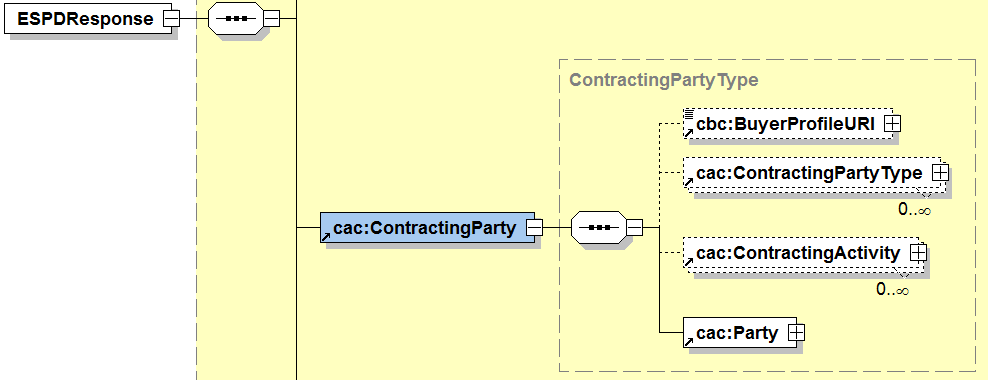
Class cac:ContractingParty
The table below lists the attributes and associated classes expected in an XML conformant to the ESPD Service.
"A class representing the contracting authority or contracting entity who is buying supplies, services or public works using a tendering procedure as described in the applicable directive (Directives 2014/24/EU, 2014/25/EU)" [9] |
||||
Elements |
Description |
Example |
Mandatory? |
Rules & comments |
cac:PartyName |
The name of the contracting body |
|
MANDATORY |
|
cac:Country |
The country of the contracting body |
|
MANDATORY - (Although in the XSD Schema the cardinality is 0..n) |
|
| 1 | The name of the Contracting Body is mandatory but has been removed from this example to simplify the example |
| 2 | the country of Contracting Body is mandatory but has been removed from this example to simplify the example |
A complete example about the cac:Party elements of the cac:ContractingParty expected by the ESPD
Service follows:
cac:Party to identify the contracting body<cac:ContractingParty>
<cac:Party>
<cac:PartyName>
<cbc:Name>Executive Agency for Small and Medium-sized Enterprises (EASME)</cbc:Name>
</cac:PartyName>
<cac:PostalAddress>
<cac:Country>
<cbc:IdentificationCode listID="CountryCodeIdentifier" listAgencyID="EU-COM-GROW" listName="CountryCodeIdentifier" listVersionID="1.0.2">BE</cbc:IdentificationCode>
</cac:Country>
</cac:PostalAddress>
<cac:Contact/>
</cac:Party>
</cac:ContractingParty>Economic Operator
The ESPDResponse was explicitly designed to hold data about one single Economic Operator.
Thus, the ESPDResponse Exchange Data Model associates a class EconomicOperatorParty as
a placeholder for the data related to only one Economic Operator (EO) that
tenders solely to a procurement project, to one of the EOs that tender as part of a group
(e.g. a Consortium), or to one possible sub-contractor of the EO.
Consortia grouping more than one EO need to draft and submit as many ESPDResponses as Economic Operators and sub-contractors participate in the tender. Revisit the "Figure 7: espd::ESPDRequest UML class diagram" and check that its association to the epsd::EconomicOperatorParty class is restricted to 1. This element is therefore mandatory.
The UML diagram below shows the details about the class EconomicOperatorParty:
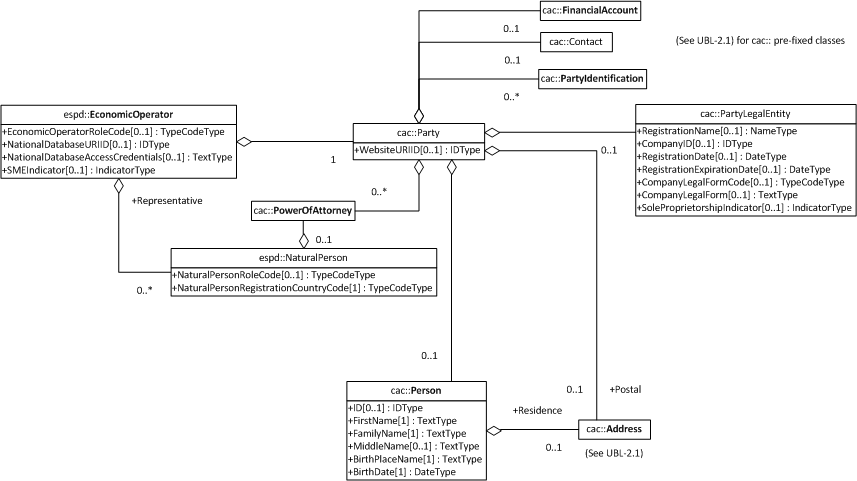
This other figure below shows the equivalent (abbreviated) XSD schema:

EconomicOperatorParty
The table below lists the attributes and associated classes expected in an XML conformant to the ESPD Service.
Beware that this class associates the very rich UBL-2.1 aggregate component cac:Party.
Similarly to what happens with the cac:ContractingParty, the ESPDResponse espd:EconomicOperatorParty
only uses a reduced subset of the component cac:Party.
"A class representing any natural or legal person or public entity or group of such persons and/or entities, including any temporary association of undertakings, which offers the execution of works and/or a work, the supply of products or the provision of services on the market in the context for which the tender where the ESPDResponse is submitted"[10] |
||||
Property |
Description |
Example |
Mandatory? |
Rules & comments |
espd-cbc:EconomicOperatorRoleCode |
The code for the role of the economic operator when bidding from a consortium |
|
OPTIONAL (0..1) - Currently not used in the ESPD Service |
|
espd-cbc: EconomicOperatorRoleDescription |
A short description for the role of the economic operator when bidding from a consortium |
|
OPTIONAL (0..1) |
|
espd-cbc: NationalDataBaseURIID |
Unrestricted and full direct access to tools and devices used for electronic communication is possible at this URL. |
OPTIONAL (0..1) |
|
|
espd-cbc: NationalDatabaseAccessCredentials |
Credentials (e.g. username and password) to access the national database |
OPTIONAL (0..1) |
|
|
espd-cbc: SMEIndicator |
Indicates whether the Economic Operator is an SME or not |
OPTIONAL (0..1) |
|
|
Associated classes |
||||
RepresentativeNaturalPerson |
Information about individuals who in one way or the other represent the economic operator |
OPTIONAL (0..n) |
Comment: Belongs to the ESPD spacename (espd-cac:) |
|
cac:Party |
The UBL-2.1 class used to hold data about the party that, in this case, is the Economic Operator |
OPTIONAL (0..n) |
|
|
RepresentativeNaturalPerson
UBL-2.1 defines a component PowerOfAttorney with that is a good container for the main data about a representativefootnote[cac:PowerOfAttorney also aggregates the cac:AgentParty, where many data about the person can be provided.]. However the ESPD stakeholders identified some data requirements that the UBL-2.1 component does not cater for; namely the role of the person (e.g. type of representation) and the country where this person is registered (i.e. in a civil base register).
The XSD diagram and table below show the details about the class EconomicOperatorParty:
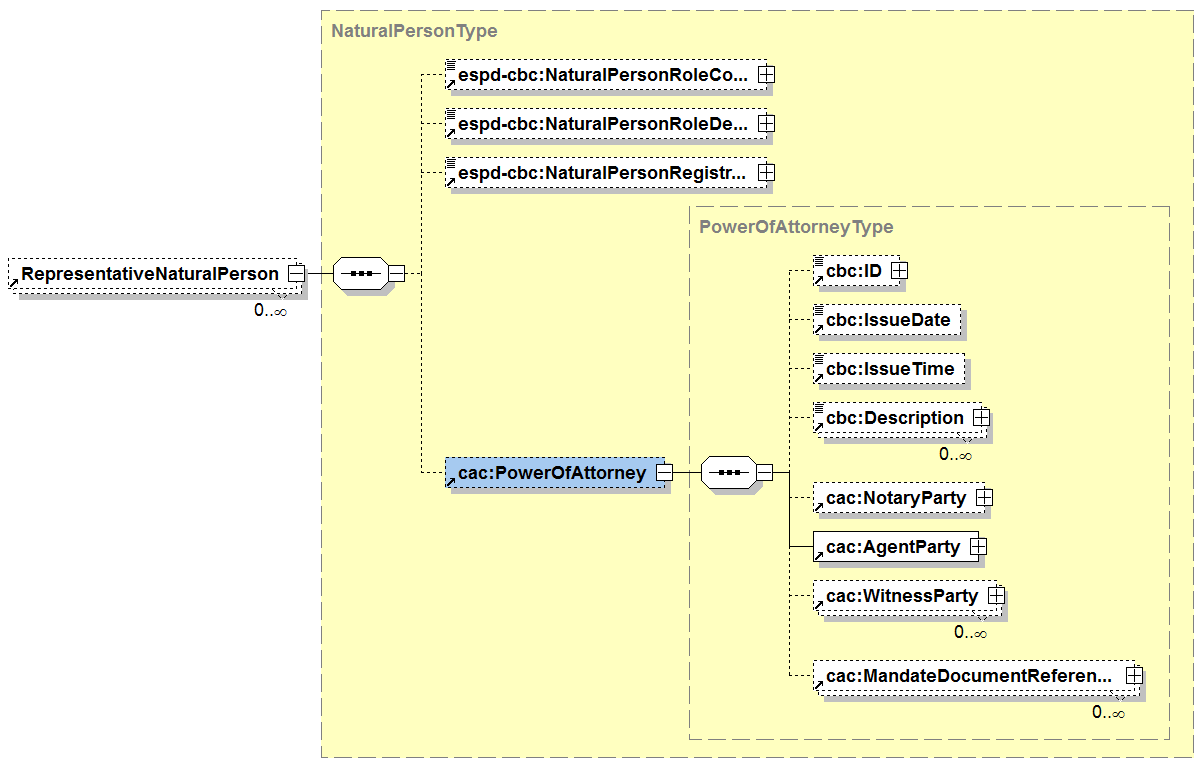
"A class representing an individual who in one way or the other represents the economic operator" |
||||
Property |
Description |
Example |
Mandatory? |
Rules & comments |
espd-cbc: NaturalPersonRoleCode |
OPTIONAL (0..1) - Currently not used (yet) in the ESPD Service |
|||
espd-cbc: NaturalPersonRoleDescription |
A short description for the role of the Economic Operator’s representative |
OPTIONAL (0..1) |
|
|
espd-cbc: NaturalPersonRegistrationCountryCode |
Country of registration of the natural person |
OPTIONAL (0..1) |
|
|
Associated classes |
||||
espd-cbc: NaturalPersonRegistrationCountryCode |
Country of registration of the natural person |
OPTIONAL (0..1) |
|
|
Power of attorney
The ESPD reuses only a small part of the class cac:PowerOfAttorney defined in UBL-2.1, only the component AgentParty and within it the subcomponent Person:
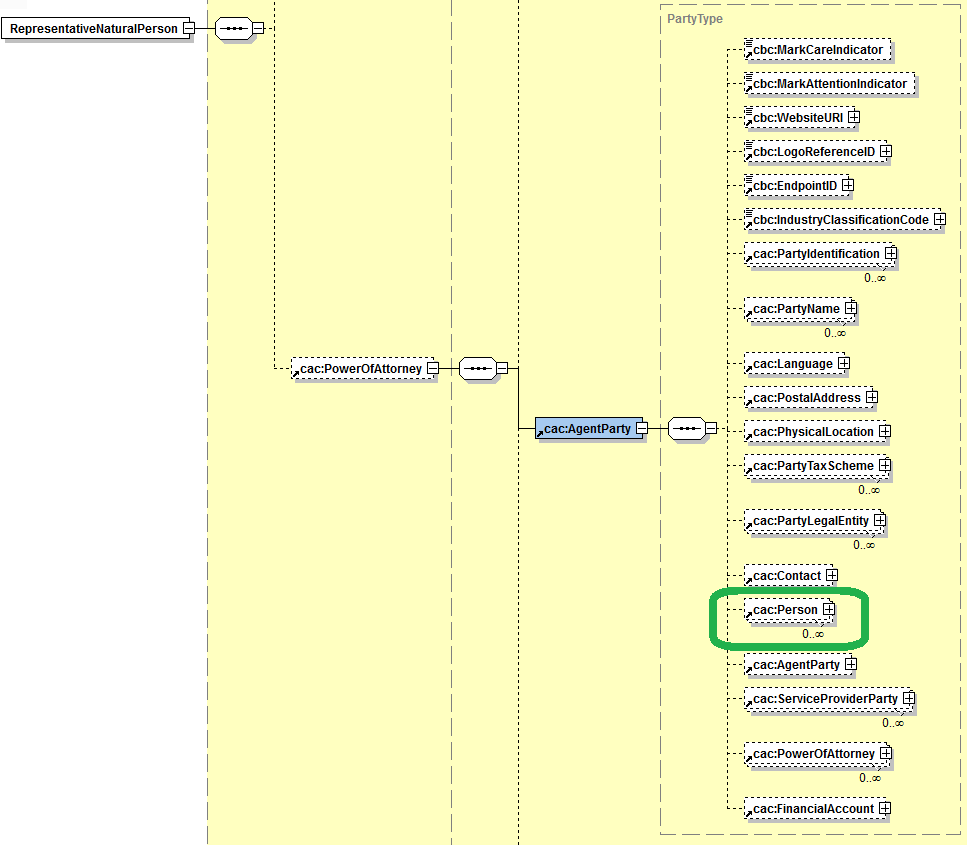
From the subcomponent Person, also a rich UBL structure, the ESPD is interested in a small set of elements, namely the name, birth data, and contact data of the representative, as shown in this example:
<cac:PowerOfAttorney>
<cac:AgentParty>
<cac:Person>
<cbc:FirstName>Bruce</cbc:FirstName>
<cbc:FamilyName>Wayne</cbc:FamilyName>
<cbc:BirthDate>1983-03-02</cbc:BirthDate>
<cbc:BirthplaceName>USA</cbc:BirthplaceName>
<cac:Contact>
<cbc:Telephone>01 234 56 78</cbc:Telephone>
<cbc:ElectronicMail>Bruce.wayne@enterprises.com</cbc:ElectronicMail>
</cac:Contact>
<cac:ResidenceAddress>
<cbc:Postbox>1000</cbc:Postbox>
<cbc:StreetName>Rue Melsens 3</cbc:StreetName>
<cbc:CityName>Brussels</cbc:CityName>
<cac:Country>
<cbc:IdentificationCode listID="CountryCodeIdentifier" listAgencyID="EU-COM-GROW" listName="CountryCodeIdentifier" listVersionID="1.0.2">BE</cbc:IdentificationCode>
</cac:Country>
</cac:ResidenceAddress>
</cac:Person>
</cac:AgentParty>
</cac:PowerOfAttorney>The Party component of the Economic Operator
For the Economic Operator (EO) it is the UBL class cac:Party that holds the more important part of the data.

The ESPD Service uses the class cac:Party to identify the Economic Operator. Although this UBL-2.1 class defines
many properties and associated classes, the ESPD Service uses only a reduced set of them: the EO’s identification, name,
address and contact, as shown below:
Element |
Description |
Example |
Mandatory? |
Rules & comments |
cac:PartyIdentification |
Unique identification number for the Economic Operator |
|
MANDATORY - (Although in the XSD Schema the cardinality is 0..n) |
|
cac:PartyName |
The official name of the Economic Operator, as registered in a Business Register |
|
MANDATORY - (Although in the XSD Schema the cardinality is 0..n) |
|
cac:PostalAddress |
The address of the Economic Operator, as registered in a Business Register |
|
OPTIONAL |
|
cac:Country |
The country code of where the EO is registered in a Business Register |
|
MANDATORY - (Although in the XSD Schema the cardinality is 0..1) |
`Rule: The country code MUST always be specified. Compulsory use of the code list CountryCodeIdentifier |
cac:Contact |
The contact data of a person related to the EO |
|
OPTIONAL |
`Comment: The ESPD Service expects the name, telephone and e-mail |
| 1 | The data provider SHOULD specify who is the issuer of the EO’s ID |
| 2 | The schemeID attribute specifies if it is a VAT number or another national number. The
possible values are: VAT_Number and National_Number. |
A complete example about the EO’s Party elements expected by the ESPD Service follows:
cac:Party to identify the Economic Operator<espd-cac:EconomicOperatorParty>
<espd-cbc:SMEIndicator>false</espd-cbc:SMEIndicator>
<espd-cac:RepresentativeNaturalPerson/>
<cac:Party>
<cac:PartyIdentification>
<cbc:ID>B20779081</cbc:ID>
</cac:PartyIdentification>
<cac:PartyName>
<cbc:Name>Wayne Enterprises</cbc:Name>
</cac:PartyName>
<cac:PostalAddress>
<cbc:Postbox>1000</cbc:Postbox>
<cbc:StreetName>Rue Melsens 3</cbc:StreetName>
<cbc:CityName>Brussels</cbc:CityName>
<cac:Country>
<cbc:IdentificationCode listID="CountryCodeIdentifier" listAgencyID="EU-COM-GROW" listName="CountryCodeIdentifier" listVersionID="1.0.2">BE</cbc:IdentificationCode>
</cac:Country>
</cac:PostalAddress>
<cac:Contact>
<cbc:Name>Bruce Wayne</cbc:Name>
<cbc:Telephone>01 234 56 78</cbc:Telephone>
<cbc:ElectronicMail>wayne@enterprises.com</cbc:ElectronicMail>
</cac:Contact>
</cac:Party>
</espd-cac:EconomicOperatorParty>Procurement Project Lot
The class cac:ProcurementProjectLot was defined in UBL-2.1 to refer to the
possible lots into which a procurement project has been subdivided (see complete
definition provided by UBL in the table below).

"One of the parts of a procurement project that is being subdivided to allow the contracting party to award different lots to different economic operators under different contracts"[11] |
||||
Elements |
Description |
Example |
Mandatory? |
Rules & comments |
cbc:ID |
An identifier for the lots |
|
MANDATORY |
|
| 1 | For the time being the ESPD Service does not handle multiple lots. |
Criterion
Criteria are at the core of the ESPD. The two main groups of Criteria relevant for the ESPD are the ones required in the Directive, Exclusion and Selection criteria. This section gives a detailed view on how to specify each of those criteria. Its content is aligned to the Annex to the Regulation 2016/7 establishing the standard form for the European Single Procurement Document.
Additionally to the Exclusion and Selection Criteria, the ESPD EDM treat some data related to the Economic Operator also as criteria. This is covered further on under Section "Other Criteria".
Core Criterion and Core Evidence Data Models and Vocabularies
This document differentiates between Data Model (referring to the UML conceptual diagrams) and Vocabulary (referring to the XSD schemas). Thus the CCV and CEV abbreviations refer to the Core Criterion and Core Evidence XSD Schemata that implement the conceptual Data Models (represented as UML diagrams).
The UML diagram below shows in detail the classes of the Core Criterion and Core Evidence Data Models used in the ESPDResponse XML document.
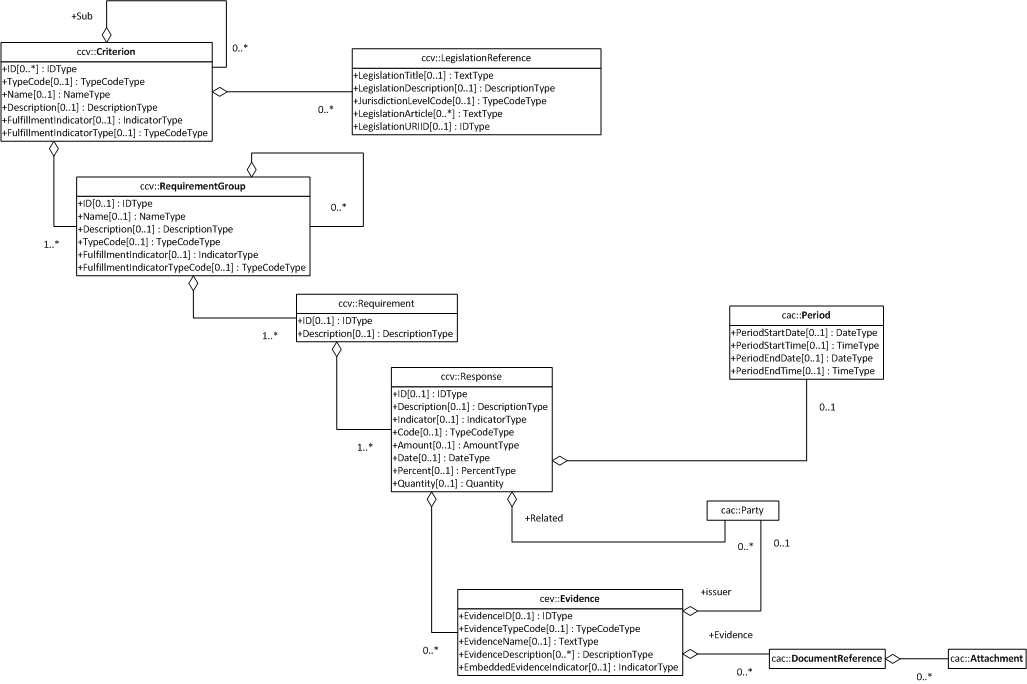
As far as the ESPD Service is concerned the above UML diagram SHOULD be interpreted as follows:
-
One Criterion contains one or more Groups of Requirements
-
One Criterion MAY have sub-Criteria
-
One Criterion MAY be linked to a specific Legislation
-
One Group of Requirements contains one or More Requirements
-
One or more Response MUST be provided (by the EO) for each Requirement
-
The Response MUST be of one, and only one, type of data
-
The type of data in a Response can be either an Indicator (a boolean value), a Code (representing a concept), an Amount (an economic value expressed as a specific currency type), a Date, a Percent, a Quantity or a Period
-
One Response MAY refer to one or more Evidences
-
The Response MAY also refer to a Party that is somehow related to the Response
-
An Evidence MAY refer to the issuer of that Evidence
-
The Evidence MAY refer to an attached DocumentReference, i.e. to a URL pointing at a document; the document could also be embedded into the cev:Evidence element, although the ESPD Service does not use this UBL feature
In the ESPD documents a Criterion takes the form of a ''question or statement about a specific subject that may lead to the exclusion or selection of an Economic Operator in a Procurement Project''. An example of Criterion in the ESPD would be a question like this:
"Has the economic operator itself or any person who is a member of its administrative, management or supervisory body or has powers of representation, decision or control therein been the subject of a conviction by final judgement for participation in a criminal organisation, by a conviction rendered at the most five years ago or in which an exclusion period set out directly in the conviction continues to be applicable?"
''Requirements'', in turn, relates to the way the Economic Operator has to answer one specific Criterion. In the case of the exclusion Criterion above mentioned, the Contracting Authority requires the Economic Operator (EO) to answer ''yes or no'', and in the case of an affirmative answer the EO is required to provide some more specific data about the conviction.
| In principle, practically all the elements in the UML class and the XSD Schema are optional. However this does not mean that an ESPD conformant Service will accept that certain data are not provided (or all of them for that matter). The compulsoriness of the ESPD Service documents elements is not controlled solely by the XSD Schema. Instead the cardinality of the elements is also validated based on ''rules''. These rules are assertions about the restrictions that affect an element, an attribute or the relationship between classes.[12]. In the tables below, describing each class, the optionality or compulsoriness is indicated in respect of the ESPD Service needs, and regardless of the XSD cardinality. |
The next figure shows the "collapsed" (i.e. abbreviated) XSD Schema corresponding to the Criterion element:
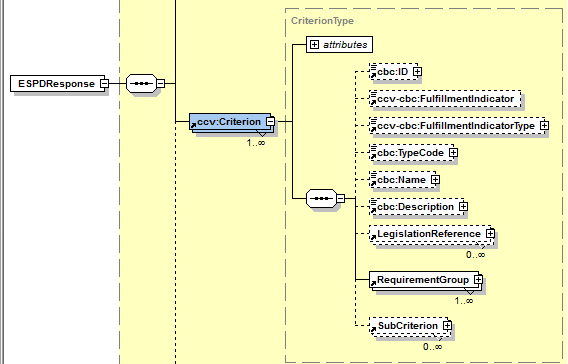
The tables below list and describe each class of the Core Criterion Vocabulary and Core Evidence Vocabulary used in the ESPDResponse XML document. They also provide the rules specific to each class, properties and elements within the class, as mentioned above. When implementing XML instances of the ESPDRequest schema these rules MUST be thoroughly respected if the XML instance is intended to be ESPD Service-conformant.
Remember that the prefixes (ccv:, cbc: cac:, etc.) are representatives of the namespaces used in the XSD Schema (see "Table 1. Schemas, namespaces and prefixes used by the ESPDResponse").
| Except for the ccv:Response element, the rest of the data is already present in the ESPDRequest XML Document. The ESPDResponse copies the ESPDRequest and extends it with the Response of the EO. |
"A class to associate a condition that the economic has to fulfil in order to not be excluded and be selected as a candidate for awarding in a procurement procedure" |
||||
Attributes |
||||
pi |
Processing Instruction. Reserved for non-standard processing of the class; e.g. for hiding or showing elements in a user interface |
OPTIONAL (0..1) |
|
|
Properties |
||||
cbc:ID |
A language-independent token, e.g., a number, that allows to identify a criterion uniquely as well as allows to reference the criterion in other documents |
|
MANDATORY (1..1) |
|
ccv-cbc: FulfillmentIndicator |
Indicates whether the economic operator states that it fulfills the specific criterion (true) or not (false) |
OPTIONAL (0..1) - Currently not used by the ESPD Service |
||
ccv-cbc: FulfillmentIndicatorType |
Codifies the type of indicator used to state whether the Criterion is met or not |
OPTIONAL (0..1) - Currently not used by the ESPD Service |
||
cbc:TypeCode |
Code specifying the type of Criterion |
|
MANDATORY (1..1) |
|
cbc:Name |
A short and descriptive name for a criterion |
|
MANDATORY (1..1) |
|
cbc:Description |
An extended description of the criterion |
|
MANDATORY (1..1) |
|
Associated classes |
||||
LegislationReference |
The specific piece(s) of Legislation(s) where the criterion is defined or mentioned |
MANDATORY (1..n) |
|
|
SubCriterion |
Specialised criterion derived from a higher classified Criterion |
OPTIONAL (0..n) |
|
|
Legislation Reference
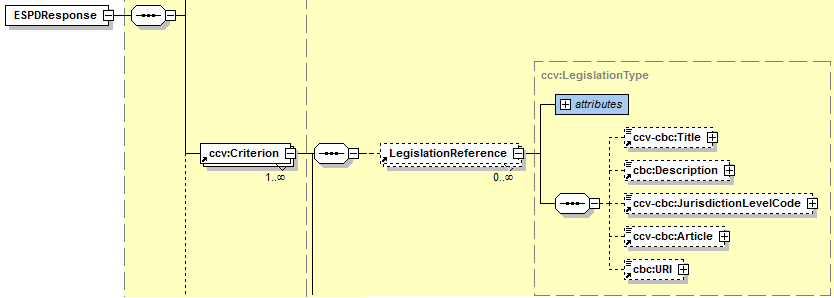
"The specific piece(s) of Legislation(s) where the criterion is defined or mentioned" |
||||
Attributes |
||||
langID |
Language of the textual data provided for this reference to a legislation |
|
OPTIONAL (0..1) |
|
Properties |
||||
ccv-cbc: LegislationTitle |
Title of the legislation as published in an official gazette or portal |
|
MANDATORY (1..1) |
|
Cbc:Description |
Reminder label or short description of the Legislation |
|
OPTIONAL (0..1) |
|
ccv-cbc: JurisdictionLevelCode |
Jurisdictional level of a particular Legislation |
|
MANDATORY (0..1) |
|
ccv-cbc:Article |
Textual description of the article of the Legislation; e.g. ''Article 61'' |
|
MANDATORY (1..1) |
|
ccv-cbc:URIID |
URI that points at the text of a particular Legislation |
|
MANDATORY (1..1) |
|
Requirement Group

"A group of requirements with a specific structure relating to one Criterion" |
||||
Attributes |
||||
pi |
Processing Instruction. Reserved for non-standard processing of the class; e.g. for hiding or showing elements in a user interface |
OPTIONAL (0..1) |
|
|
Properties |
||||
cbc:ID |
A language-independent token, e.g., a number, that allows to identify a group of requirements uniquely |
|
MANDATORY (1..1) |
|
cbc:Name |
A short and descriptive name for a group of requirements |
OPTIONAL (0..1) |
|
|
cbc:Description |
An extended description of the group of requirements |
OPTIONAL (0..1) |
|
|
cbc:TypeCode |
Code to specify the type of the group |
OPTIONAL (0..1) |
|
|
Associated classes |
||||
Requirement |
Request by the Contracting Authority oriented to determine how the Economic Operator meets a concrete aspect of the Criterion |
MANDATORY (1..n) |
||
RequirementGroup |
Subgroup(s) of nested Requirements catering for the construction of data flows including decision fork points |
(See the example about a complete Criterion below= |
MANDATORY (1..n) |
|
| A CriterionRequirementGroup MAY contain sub-groups of criteria. This nested structure allows the ESPD to represent complex decision structures and capture faithfully the data represented in highly structured user interfaces (like the one implemented in the ESPD Service). This is clearly illustrated in the next sections. |
Requirement

"A class to associate a specific requirement that must be fulfilled through a response by the Economic Operator (EO)" |
||||
Attributes |
||||
pi |
Processing Instruction. Reserved for non-standard processing of the class |
OPTIONAL (0..1) |
|
|
responseDataType |
Type of response expected for this requirement; e.g. Indicator, Date, Description, etc. |
MANDATORY (1..1) |
|
|
Properties |
||||
cbc:ID |
A language-independent token, e.g., a number, that allows to identify a Requirement |
|
MANDATORY (1..1) |
|
Response
The ccv:Response class is used by the economic operator to answer a specific Requirement issued by
the contracting body.
|
Providing the expected data type
The XSD Schema defines multiple types of data for the response (Indicator, Amount, Date, etc.), only one response data MUST be provided. And the data provided in the response MUST match the one specified in the attribute of the class ccv:Requirement. The economic operator MUST use the code list ResponseDataType and make sure that the data provided is of the same type that the one expected by the contracting authority (See the column ''Type of value expected by the current version of the ESPD Service''). |
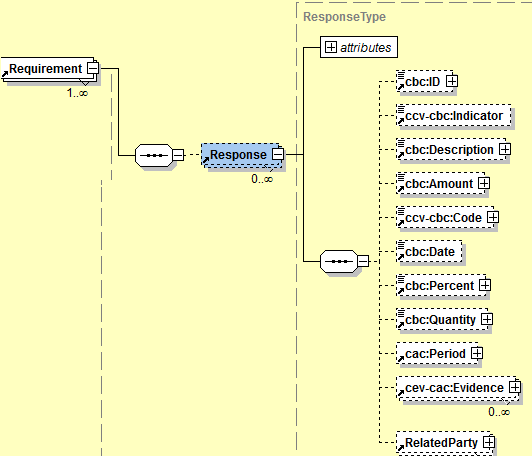
"A class to associate the answer provided by the Economic Operator (EO) to a specific Requirement" |
||||
Attributes |
||||
pi |
Processing Instruction. Reserved for non-standard processing of the class; |
OPTIONAL (0..1) |
|
|
Properties |
||||
cbc:ID |
A language-independent token, e.g., a number, that allows to identify a Response |
OPTIONAL (0..1) |
|
|
ccv-cbc:Indicator |
Indicates a positive or a negative answer provided by the economic operator as an answer to a question in the Requirement |
|
OPTIONAL (0..1) |
`Comment: The only possible values are False and True |
cbc:Description |
A textual description of a criterion response that describes how an economic operators fulfills an specific criterion |
OPTIONAL (0..1) |
||
cbc:Amount |
Declared amount that fulfills this criterion |
|
OPTIONAL (0..1) |
|
ccv-cbc:Code |
A code pointing at a definition of a concept as the answer to the Requirement |
OPTIONAL (0..1) |
`Comment: The current ESPD Service does not use this property, but consider for example a Requirement asking for a country code: in that case this would be the right placeholder for the expected data |
|
cbc:Date |
Declared date that fulfills this criterion |
|
OPTIONAL (0..1) |
`Rule: The date format MUST be 'YYYY-MM-DD', where 'Y' stands for 'Year', 'M' for 'Month', and 'D' for 'Day' |
cbc:Percent |
Declared percentage that fulfills this criterion |
|
OPTIONAL (0..1) |
|
cbc:Quantity |
Declared quantity that fullfills the criterion |
|
OPTIONAL (0..1) |
|
Associated classes |
||||
cac:Period |
Declared period that fulfills the Criterion |
|
OPTIONAL (0..1) |
|
cev-cac:Evidence |
One or more references to a source where a documentary proof can be obtained to demonstrate that one stated response does actually fulfill the Requirement from a Criterion |
OPTIONAL (0..n) |
|
|
RelatedParty |
A party that may be affected by the response provided by the economic operator |
OPTIONAL (0..1) |
|
|
| 1 | "…" indicates that some mandatory elements (ID and Description) have been removed from the example to shorten it |
| 2 | Notice the use of the attribute unitCode |
| 3 | Notice the absence of the attribute unitCode |
|
About the different types of Quantities
Up to three different types of Quantities can be specified: (1) QUANTITY_INTEGER, a number representing a quantity in a specific unit of measure. The unit has to be specified (e.g. number of workers); (2) QUANTITY_YEAR, a non-negative integer (i.e. a natural number) representing a year. The unit has to be specified as YEAR, and (3) QUANTITY, a number representing a generic quantity with no unit specified (e.g. a ratio). Beware that in the case of QUANTITY_INTEGER and QUANTITY_YEAR the attribute unitCode MUST be always specified (See code list ResponseDataType). 
Figure XXX: The ResponseDataType code list
|
Evidence
The ccv:Evidence class is used by the economic operator to refer to a trusted source of proofs that
supports the stated response to a criterion requirement.
In the ESPD Exchange Data Model (ESPD EDM) the Evidence class is part of the Response to a Requirement, as shown in the XSD diagram below:
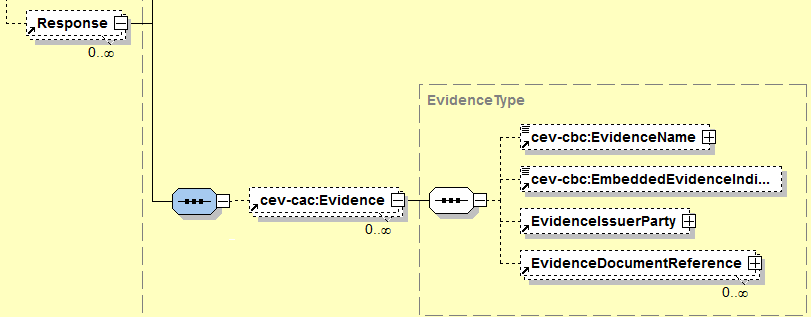
"A class used by the economic operator to refer to a trusted source of proofs that supports the stated response to a criterion requirement" |
||||
Properties |
||||
cev-cbc:EvidenceName |
The name of an evidence |
OPTIONAL (0..1) |
|
|
cev-cbc: EmbeddedEvidenceIndicator |
Indicates whether the Evidence is embedded in the XML document (True) |
OPTIONAL (0..1) |
|
|
Associated classes |
||||
EvidenceIssuerParty |
A UBL-2.1 Party class to refer to the (trusted) Party responsible for issuing the Evidence |
OPTIONAL (0..1) |
|
|
EvidenceDocumentReference |
A UBL-2.1 DocumentReference class to hold the data about the reference to the Evidence |
(See example below) |
OPTIONAL (0..1) |
|
<ccv:Requirement responseDataType="EVIDENCE_URL">
<cbc:ID schemeID="CriterionRelatedIDs" schemeAgencyID="EU-COM-GROW" schemeVersionID="1.0">03bb1954-13ae-47d8-8ef8-b7fe0f22d700</cbc:ID>
<cbc:Description>URL</cbc:Description>
<ccv:Response>
<cev:Evidence>
<cev:EvidenceDocumentReference>
<cbc:ID>6a5818a9-7908-44d0-9847-086b4b7a1444</cbc:ID>
<cac:Attachment>
<cac:ExternalReference>
<cbc:URI>http://www.eurodb.be/scriptsPublic/arianeweb.dll/e/m_mkt_rech</cbc:URI>
</cac:ExternalReference>
</cac:Attachment>
</cev:EvidenceDocumentReference>
</cev:Evidence>
</ccv:Response>
</ccv:Requirement>Service Provider
The Service Provider refers to the party who provided the data included in the ESPDRequest XML document. For this purpose the ESPD EDM reuses
the UBL-2.1 class cac:ServiceProvider, which ''is a'' cac:Party class. (see the UBL-2.1 specification for details about this class).
Signature
Similarly to the ''Service Provider'' the ESPD EDM defines a Signature that reuses the UBL-2.1 cac:Signature class to hold an
electronic signature. For the time being the ESPD does not use this UBL component neither.
Additional Document Reference
The ESPD EDM reuses this UBL-2.1 component to allow both the contracting body (in the ESPDRequest) and the economic operator (in the ESPDResponse) to include references to documents that they might consider relevant including in the XML instances of both types of documents.
The class used for this, cac:AdditionalDocumentReference ''is a'' cac:DocumentReference class defined in the UBL-2.1
Common Aggregate Components library (see the folder xsd/common/UBL-CommonAggregateComponents-2.1.xsd file of the
UBL-2.1 specification)
Although this class has a rich data structure the ESPD Service at most expects the following data from it:
-
The document ID;
-
The issue date and time;
-
The document type code;
-
A title for the document; and
-
A description of its content and/or intended purpose; and
-
The URL where to access its content.
This example below illustrates how these fields from the cac:AdditionalDocumentReference are used in the ESPDRequest XML document. Beware that this is a special case (see General rule 1, below), as it refers to the Contract Notice published in the Publications Office’s TeD Service:
<cac:AdditionalDocumentReference>
<cbc:ID schemeID="ISO/IEC 9834-8:2008 - 4UUID" schemeAgencyID="EU-COM-GROW" schemeAgencyName="DG GROW (European Commission)" schemeVersionID="1.1">2015/S 252-461137</cbc:ID>(1)
<cbc:DocumentTypeCode listID="ReferencesTypeCodes" listAgencyID="EU-COM-GROW" listVersionID="1.0">TED_CN</cbc:DocumentTypeCode>(2)
<cac:Attachment>
<cac:ExternalReference>
<cbc:FileName>Belgium-Brussels: European Resource Efficiency Excellence Centre</cbc:FileName>(3)
<cbc:Description>The objective of this contract is to set up a virtual European Resource Efficiency Excellence Centre. The Centre will provide information and support to European SMEs, business intermediaries, resource efficiencypractitioners and other interested parties such as regional authorities.</cbc:Description>(4)
</cac:ExternalReference>
</cac:Attachment>
</cac:AdditionalDocumentReference>| 1 | Unique ID for this document (the TeD Contract Notice reference number) |
| 2 | The COM’s code for this type of content |
| 3 | A title for the document |
| 4 | A description of the content and intended use of this document |
|
|
General rule 1: All ESPD XML Documents MUST refer to the Contract Notice (CN) published in TeD
All ESPDResponse XML instances (and the ESPDRequest instances, too, for that matter) MUST always include an Additional Document Reference indicating the TeD reference number of the Contract Notice the ESPDResponse is related to. This reference number MUST be specified in the field `cbc:ID`of the element cac:AdditionalDocumentReference component, and MUST follow the scheme defined by the Publications Office: [][][][]/S [][][]-[][][][][][] (e.g. 2015/S 252-461137). |
IV. Criteria Data Flows
The ESPD Exchange Data Model (ESPD-EDM) is flexible enough so as to implement XML documents with different structures. Concretely, the possibility of nesting groups of requirements inside groups of requirements can end up in complex XML instances that may not resemble amongst them thus hindering the mapping of data, their presentation and the interoperability between systems.
Hence the need of establishing of a minimum set of rules about how to build up such data structures. To keep conformance with the ESPD Services the rules are simple:
|
General rule 2: How to structure an ESPD Service Criterion
|
The flow-chart below illustrates this principle for any exclusion conviction criterion:
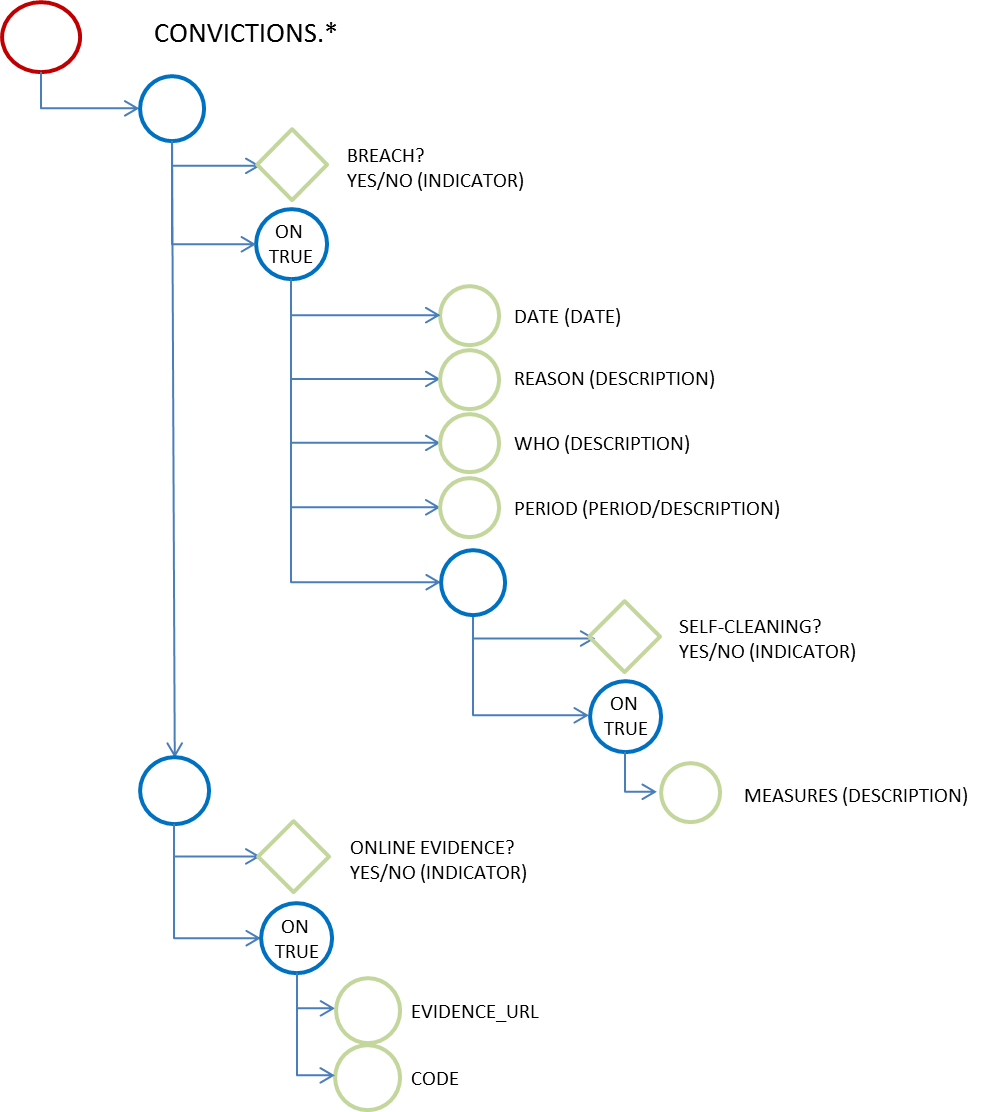
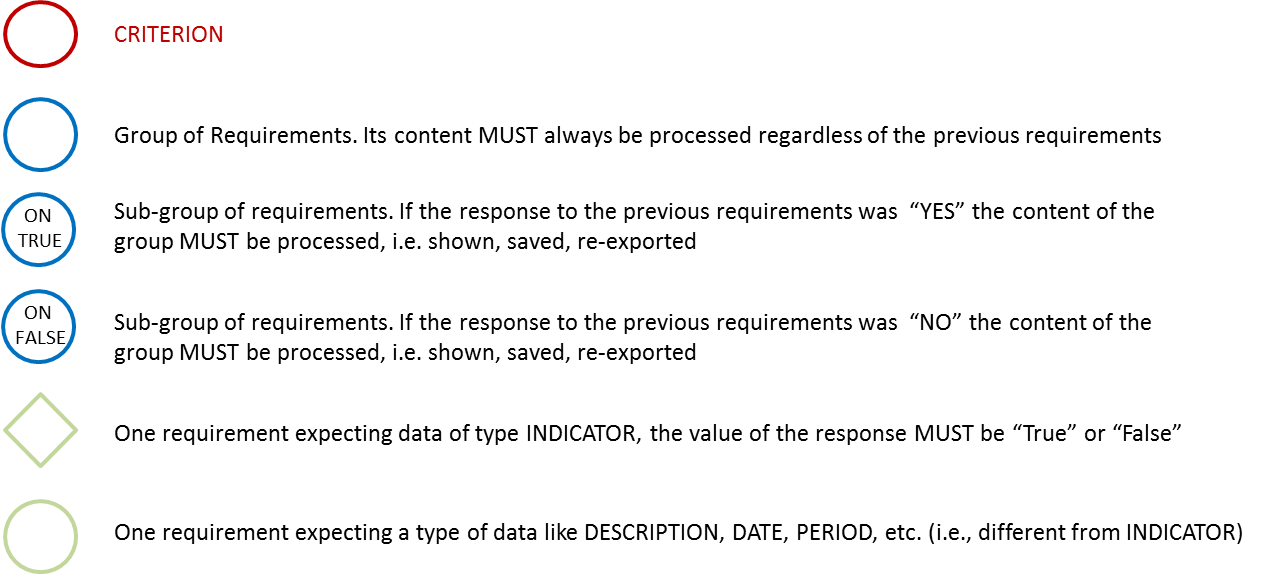
The interpretation of this diagram could be as follows:
-
This criterion has two main groups of requirements (G1: Breach? and G2: Online Evidence);
-
The first group of requirements has one requirement and one sub-group or requirements;
-
If the response to the requirement is "Yes" (ON TRUE [13]) then the ESPD Service application will show four data fields and a new subgroup with an additional question. Thus (on True) the EO will have to provide the date of the conviction, the reason, who was convicted and for how long. If the response is "No", then the EO will proceed providing data about whether there’s online evidence or not regarding to the absence of conviction (if that is possible).
-
This behaviour repeats per each subgroup of requirements: the deepest subgroup of the structure for the group 1 will have to be shown by the ESPD Service (and filled by the EO) in case an imported ESPDRequirement XML has a "Yes" in the response to the requirement Self-Cleaning.
In the next sections this principle is used to structure the Exclusion and Selection Criteria. See also the examples provided all along the document.
|
Note for the future 1. The ESPD Service evolution: from a dynamic structure towards a dynamic one
The current version of the ESPD Service user interface and XML documents instances are based on a fixed known structure which is very close to the requirements expressed in the Annex to the Regulation 2016/7. This imposes limitations to the maintainability and evolution of the ESPD Service. A dynamic approach where the interface is built-up based on the data being imported into the ESPD Service is currently being addressed in order to overcome these limitations. |
1. EXCLUSION CRITERIA
For Procurement Projects where the value of the contract is above the threshold, all ESPDRespone XML documents MUST specify all the exclusion criteria defined in the Directive. Thus the following general rule:
|
General rule 3: For above-the-threshold contracts all the Exclusion criteria MUST be specified
All ESPDResponse XML instances (and the ESPDRequest instances, too, for that matter) MUST always include all the exclusion criterion detailed in the Annex of the Regulation 2016 and the criteria data flow tables defined by COM). |
Criteria may be grouped in several different categories. The figure below is intended to identify and list these categories for the Exclusion criteria (branches in text boxes), and specific subgroups within each category (leaves in text without boxes):
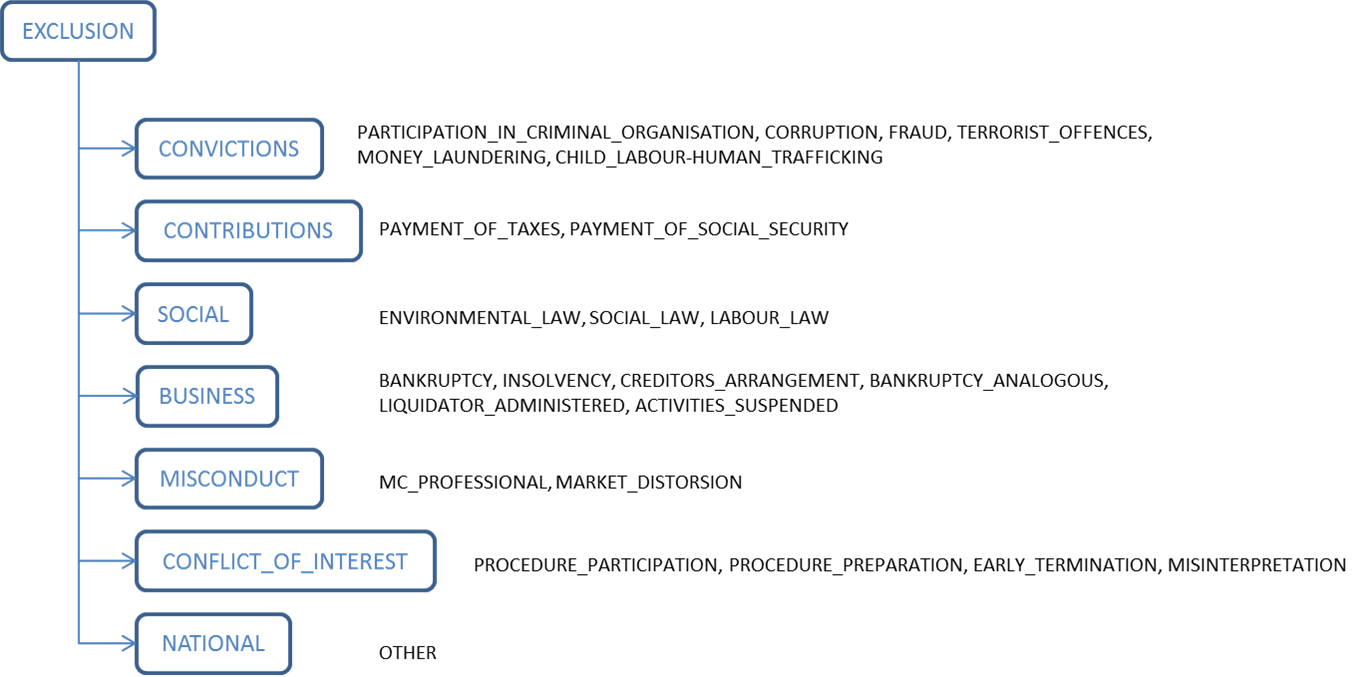
Each of these categories has its own particular data structure, which can be represented as flow diagrams like the one in the figure above (see Figure 21. ''General data-structure design rule for criteria and requirements with a yes or no answer''). Thus the data structures below represent how the data is organised for each exclusion criterion used in the ESPD.
|
The exclusion criteria have been drafted ''from a negative perspective''. Thus a criterion like Has the economic operator breached its obligations relating to the payment of taxes, both in the country in which it is established and in Member State of the contracting authority or contracting entity if other than the country of establishment? If the Economic Operator answers ''no'' then it has nothing to justify or motivate. On the contrary if it answers ''yes'' it will have to provide additional data and evidences to prove that the criterion is satisfied. The ESPD Service applies this approach as much as possible. |
Convictions
The label ''Convictions'' groups all the criteria related to the offences for which an Economic Operator may have been convicted [14]:
-
CRITERION.EXCLUSION.CONVICTIONS.*: ''participation in a criminal organisation'', ''corruption'', ''fraud'', ''terrorist offences linked to terrorist activities'', ''money laundering or terrorist financing'', ''child labour and other forms of trafficking in human beings''.
In an ESPD Service conformant XML document all these criteria share the same structure. The Figure 21 above provides a simple view of how the data of a Conviction exclusion criterion
is organised. This other figure represents practically the same idea, but from a ''data-structuring'' perspective:
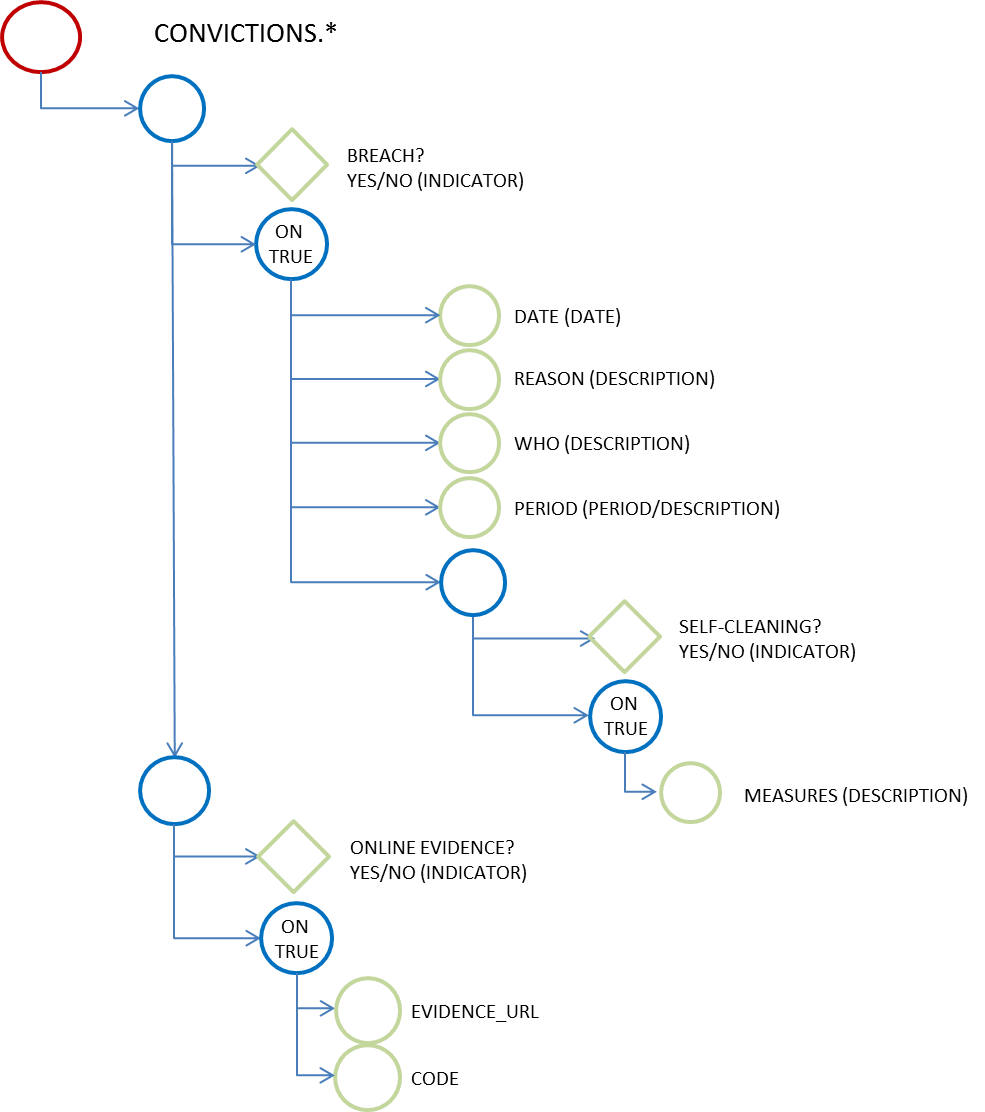
<ccv:Criterion>
<cbc:ID schemeID="CriteriaID" schemeAgencyID="EU-COM-GROW" schemeVersionID="1.0">005eb9ed-1347-4ca3-bb29-9bc0db64e1ab</cbc:ID>(1)
<cbc:TypeCode listID="CriteriaTypeCode" listAgencyID="EU-COM-GROW" listVersionID="1.0.2">CRITERION.EXCLUSION.CONVICTIONS.PARTICIPATION_IN_CRIMINAL_ORGANISATION</cbc:TypeCode>(2)
<cbc:Name>Participation in a criminal organisation</cbc:Name>
<cbc:Description>Has the economic operator itself or any person who is a member of its administrative, management or supervisory body or has powers of representation, decision or control therein been the subject of a conviction by final judgment for participation in a criminal organisation, by a conviction rendered at the most five years ago or in which an exclusion period set out directly in the conviction continues to be applicable? As defined in Article 2 of Council Framework Decision 2008/841/JHA of 24 October 2008 on the fight against organised crime (OJ L 300, 11.11.2008, p. 42).</cbc:Description>
<ccv:LegislationReference>
<ccv-cbc:Title>DIRECTIVE 2014/24/EU OF THE EUROPEAN PARLIAMENT AND OF THE COUNCIL of 26 February 2014 on public procurement and repealing Directive 2004/18/EC</ccv-cbc:Title>
<cbc:Description>Directive 2014/24/EU</cbc:Description>
<ccv-cbc:JurisdictionLevelCode listID="CriterionJurisdictionLevel" listAgencyID="EU-COM-GROW" listVersionID="1.0.2">EU_DIRECTIVE</ccv-cbc:JurisdictionLevelCode>
<ccv-cbc:Article>57(1)</ccv-cbc:Article>
<cbc:URI>http://eur-lex.europa.eu/legal-content/EN/TXT/?uri=celex:32014L0024</cbc:URI>
</ccv:LegislationReference>
<ccv:RequirementGroup>
<cbc:ID schemeAgencyID="EU-COM-GROW" schemeVersionID="1.0">7c637c0c-7703-4389-ba52-02997a055bd7</cbc:ID>(3)
<ccv:Requirement responseDataType="INDICATOR">(5)
<cbc:ID schemeID="CriterionRelatedIDs" schemeAgencyID="EU-COM-GROW" schemeVersionID="1.0">974c8196-9d1c-419c-9ca9-45bb9f5fd59a</cbc:ID>(4)
<cbc:Description>Your answer?</cbc:Description>
<ccv:Response>
<ccv-cbc:Indicator>true</ccv-cbc:Indicator>(6)
</ccv:Response>
</ccv:Requirement>
<ccv:RequirementGroup pi="GROUP_FULFILLED.ON_TRUE">
<cbc:ID schemeAgencyID="EU-COM-GROW" schemeVersionID="1.0">41dd2e9b-1bfd-44c7-93ee-56bd74a4334b</cbc:ID>
<ccv:Requirement responseDataType="DATE">
<cbc:ID schemeID="CriterionRelatedIDs" schemeAgencyID="EU-COM-GROW" schemeVersionID="1.0">ecf40999-7b64-4e10-b960-7f8ff8674cf6</cbc:ID>
<cbc:Description>Date of conviction</cbc:Description>
<ccv:Response>
<cbc:Date>2015-12-09</cbc:Date>
</ccv:Response>
</ccv:Requirement>
<ccv:Requirement responseDataType="DESCRIPTION">
<cbc:ID schemeID="CriterionRelatedIDs" schemeAgencyID="EU-COM-GROW" schemeVersionID="1.0">7d35fb7c-da5b-4830-b598-4f347a04dceb</cbc:ID>
<cbc:Description>Reason</cbc:Description>
<ccv:Response>
<cbc:Description>Participation in a criminal organisation</cbc:Description>
</ccv:Response>
</ccv:Requirement>
<ccv:Requirement responseDataType="DESCRIPTION">
<cbc:ID schemeID="CriterionRelatedIDs" schemeAgencyID="EU-COM-GROW" schemeVersionID="1.0">c5012430-14da-454c-9d01-34cedc6a7ded</cbc:ID>
<cbc:Description>Who has been convicted</cbc:Description>
<ccv:Response>
<cbc:Description>Mr Dragon A</cbc:Description>
</ccv:Response>
</ccv:Requirement>
<ccv:Requirement responseDataType="PERIOD">
<cbc:ID schemeID="CriterionRelatedIDs" schemeAgencyID="EU-COM-GROW" schemeVersionID="1.0">9ca9096f-edd2-4f19-b6b1-b55c83a2d5c8</cbc:ID>
<cbc:Description>Length of the period of exclusion</cbc:Description>
<ccv:Response>
<cac:Period>
<cbc:Description>6 years</cbc:Description>
</cac:Period>
</ccv:Response>
</ccv:Requirement>
<ccv:RequirementGroup>
<cbc:ID schemeAgencyID="EU-COM-GROW" schemeVersionID="1.0">5f9f09f7-f701-432c-9fdc-c22c124a74c9</cbc:ID>
<ccv:Requirement responseDataType="INDICATOR">
<cbc:ID schemeID="CriterionRelatedIDs" schemeAgencyID="EU-COM-GROW" schemeVersionID="1.0">20c5361b-7599-4ee6-b030-7f8323174d1e</cbc:ID>
<cbc:Description>Have you taken measures to demonstrate your reliability 'Self-Cleaning'?</cbc:Description>
<ccv:Response>
<ccv-cbc:Indicator>true</ccv-cbc:Indicator>
</ccv:Response>
</ccv:Requirement>
<ccv:RequirementGroup pi="GROUP_FULFILLED.ON_TRUE">
<cbc:ID schemeAgencyID="EU-COM-GROW" schemeVersionID="1.0">74e6c7b4-757b-4b40-ada6-fad6a997c310</cbc:ID>
<ccv:Requirement responseDataType="DESCRIPTION">
<cbc:ID schemeID="CriterionRelatedIDs" schemeAgencyID="EU-COM-GROW" schemeVersionID="1.0">7b07904f-e080-401a-a3a1-9a3efeeda54b</cbc:ID>
<cbc:Description>Please describe them</cbc:Description>
<ccv:Response>
<cbc:Description>Many causes and conditions can impair mobility and movement. The inability to use legs, arms, or the body trunk effectively because of paralysis, stiffness, pain, or other impairments is common. It may be the result of birth defects, disease, age, or accidents. These disabilities may change from day to day. They may also contribute to other disabilities such as impaired speech, memory loss, short stature, and hearing loss.</cbc:Description>
</ccv:Response>
</ccv:Requirement>
</ccv:RequirementGroup>
</ccv:RequirementGroup>
</ccv:RequirementGroup>
</ccv:RequirementGroup>
<ccv:RequirementGroup>
<cbc:ID schemeAgencyID="EU-COM-GROW" schemeVersionID="1.0">7458d42a-e581-4640-9283-34ceb3ad4345</cbc:ID>
<ccv:Requirement responseDataType="INDICATOR">
<cbc:ID schemeID="CriterionRelatedIDs" schemeAgencyID="EU-COM-GROW" schemeVersionID="1.0">c1347b74-1872-4060-a6db-f4044edcd7c4</cbc:ID>
<cbc:Description>Is this information available electronically?</cbc:Description>
<ccv:Response>
<ccv-cbc:Indicator>true</ccv-cbc:Indicator>
</ccv:Response>
</ccv:Requirement>
<ccv:RequirementGroup pi="GROUP_FULFILLED.ON_TRUE">
<cbc:ID schemeAgencyID="EU-COM-GROW" schemeVersionID="1.0">41dd2e9b-1bfd-44c7-93ee-56bd74a4334b</cbc:ID>
<ccv:Requirement responseDataType="EVIDENCE_URL">
<cbc:ID schemeID="CriterionRelatedIDs" schemeAgencyID="EU-COM-GROW" schemeVersionID="1.0">f4313bb6-21b6-499e-bdff-debe10e11d2c</cbc:ID>
<cbc:Description>URL</cbc:Description>
<ccv:Response>
<cev:Evidence>
<cev:EvidenceDocumentReference>
<cbc:ID>fe3696b0-0325-404a-9fab-989b4c9dd963</cbc:ID>
<cac:Attachment>
<cac:ExternalReference>
<cbc:URI>https://www.lds.org/topics/disability/list/physical-disability?lang=eng</cbc:URI>
</cac:ExternalReference>
</cac:Attachment>
</cev:EvidenceDocumentReference>
</cev:Evidence>
</ccv:Response>
</ccv:Requirement>
<ccv:Requirement responseDataType="CODE">
<cbc:ID schemeID="CriterionRelatedIDs" schemeAgencyID="EU-COM-GROW" schemeVersionID="1.0">1f1cd18e-3e01-4ca2-af4c-e2981924ba8d</cbc:ID>
<cbc:Description>Code</cbc:Description>
<ccv:Response>
<ccv-cbc:Code>Participation in a criminal organisation</ccv-cbc:Code>
</ccv:Response>
</ccv:Requirement>
</ccv:RequirementGroup>
</ccv:RequirementGroup>
</ccv:Criterion>| 1 | COM UUID in table ESPD Criteria: Exclusion criteria |
| 2 | COM code list CriteriaTypeCode |
| 3 | COM UUID in table ESPD Criteria: Exclusion criteria |
| 4 | COM UUID in table ESPD Criteria: Exclusion criteria |
| 5 | Expected response of type Indicator (a boolean value true or false) |
| 6 | The response (i) is of the expected type, and (2) the response answers the question in the Criterion: this EO has not participated in a criminal organisation. Hence the rest of responses are empty, as the EO has not to provide any further data |
|
General rule 4: Use of the first Requirement as a ''decision point''
If the Criterion contains a question that needs to be answered with ''yes'' or ''no'' the first Requirement SHOULD be just a sentence requiring to answer ''yes'' or ''no''. The answer to this Requirement will be considered the answer to the Criterion and a ''decision point'' used to fork between whether to process the data within the group or not. |
|
General rule 5: Compulsory use of the UUIDs defined by COM
ESPD XML documents intended to be conformant to the ESPD Service MUST use the Universally Unique Identifiers provided by COM for Criterion, RequirementGroup and Requirement. These UUIDs are the same as the ones used in e-Certis.[15]. |
|
Note for the future 2: Cross-border/cross-sector codes
Some relevant trans-European initiatives like ECRIS, BRIS, EESSI, and other, have defined Code Lists and other reference data that could be used in e-Procurement, and specifically by the ESPD. This would enhance the cross-border and cross-sector semantic and technical interoperability. Thus, in the case of Convictions, a new requirement could be introduced in G1 (see figures above) asking for the ECRIS Code corresponding to the offence that will be specified in the Response in case the Economic Operator answered ''yes'' to the first Requirement. The ECRIS Codes can be consulted in the Annex to the COUNCIL DECISION 2009/316/JHA of 6 April 2009 on the establishment of the European Criminal Records Information System (ECRIS) in application of Article 11 of Framework Decision 2009/315/JHA.[16]. |
-
The XML structure and elements of the above example reproduce the fragment of text in the Annex to the Regulation 2016/7 related to this criterion;
-
The general rules are respected;
-
The XML structure maps the data-structure;
Contributions
The category ''Contributions'' encompasses two criteria:
-
CRITERION.EXCLUSION.CONTRIBUTIONS.*: ''payment of taxes'' and ''social security contributions''.
Both are implemented using the same structure:
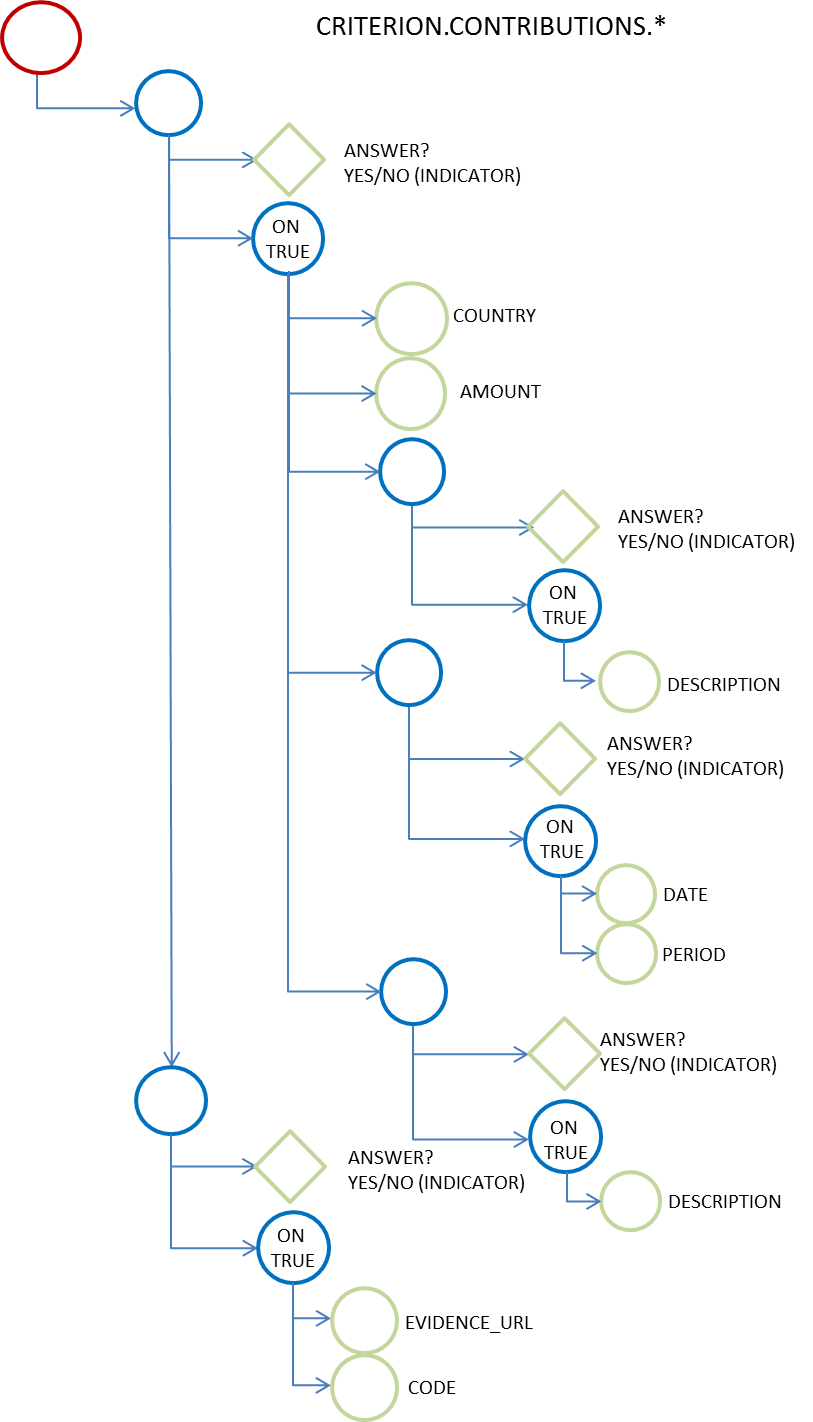
The fragment of XML below shows the implementation of both in the ESPD Service:
<ccv:Criterion>
<cbc:ID schemeID="CriteriaID" schemeAgencyID="EU-COM-GROW" schemeVersionID="1.0">b61bbeb7-690e-4a40-bc68-d6d4ecfaa3d4</cbc:ID>
<cbc:TypeCode listID="CriteriaTypeCode" listAgencyID="EU-COM-GROW" listVersionID="1.0.2">CRITERION.EXCLUSION.CONTRIBUTIONS.PAYMENT_OF_TAXES</cbc:TypeCode>
<cbc:Name>Payment of taxes</cbc:Name>
<cbc:Description>Has the economic operator breached its obligations relating to the payment of taxes, both in the country in which it is established and in Member State of the contracting authority or contracting entity if other than the country of establishment?</cbc:Description>
<ccv:LegislationReference>
<ccv-cbc:Title>DIRECTIVE 2014/24/EU OF THE EUROPEAN PARLIAMENT AND OF THE COUNCIL of 26 February 2014 on public procurement and repealing Directive 2004/18/EC</ccv-cbc:Title>
<cbc:Description>Directive 2014/24/EU</cbc:Description>
<ccv-cbc:JurisdictionLevelCode listID="CriterionJurisdictionLevel" listAgencyID="EU-COM-GROW" listVersionID="1.0.2">EU_DIRECTIVE</ccv-cbc:JurisdictionLevelCode>
<ccv-cbc:Article>57(2)</ccv-cbc:Article>
<cbc:URI>http://eur-lex.europa.eu/legal-content/EN/TXT/?uri=celex:32014L0024</cbc:URI>
</ccv:LegislationReference>
<ccv:RequirementGroup>
<cbc:ID schemeAgencyID="EU-COM-GROW" schemeVersionID="1.0">098fd3cc-466e-4233-af1a-affe09471bce</cbc:ID>
<ccv:Requirement responseDataType="INDICATOR">
<cbc:ID schemeID="CriterionRelatedIDs" schemeAgencyID="EU-COM-GROW" schemeVersionID="1.0">974c8196-9d1c-419c-9ca9-45bb9f5fd59a</cbc:ID>
<cbc:Description>Your answer?</cbc:Description>
<ccv:Response>
<ccv-cbc:Indicator>true</ccv-cbc:Indicator>(1)
</ccv:Response>
</ccv:Requirement>
<ccv:RequirementGroup pi="GROUP_FULFILLED.ON_TRUE">
<cbc:ID schemeAgencyID="EU-COM-GROW" schemeVersionID="1.0">f8499787-f9f8-4355-95e2-9784426f4d7b</cbc:ID>
<ccv:Requirement responseDataType="CODE_COUNTRY">
<cbc:ID schemeID="CriterionRelatedIDs" schemeAgencyID="EU-COM-GROW" schemeVersionID="1.0">6c87d3d4-e8eb-4253-b385-6373020ab886</cbc:ID>
<cbc:Description>Country or member state concerned</cbc:Description>
<ccv:Response>
<ccv-cbc:Code listID="ISO 3166-1" listAgencyID="ISO" listVersionID="1.0">FR</ccv-cbc:Code>
</ccv:Response>
</ccv:Requirement>
<ccv:Requirement responseDataType="AMOUNT">
<cbc:ID schemeID="CriterionRelatedIDs" schemeAgencyID="EU-COM-GROW" schemeVersionID="1.0">9052cc59-cfe5-41c6-a314-02a7f378ffe8</cbc:ID>
<cbc:Description>Amount concerned</cbc:Description>
<ccv:Response>
<cbc:Amount currencyID="EUR">300.0</cbc:Amount>(2)
</ccv:Response>
</ccv:Requirement>
<ccv:RequirementGroup>
<cbc:ID schemeAgencyID="EU-COM-GROW" schemeVersionID="1.0">7c2aec9f-4876-4c33-89e6-2ab6d6cf5d02</cbc:ID>
<ccv:Requirement responseDataType="INDICATOR">
<cbc:ID schemeID="CriterionRelatedIDs" schemeAgencyID="EU-COM-GROW" schemeVersionID="1.0">9b4497e6-a166-46f9-8581-7fc39ff975c4</cbc:ID>
<cbc:Description>Has this breach of obligations been established by means other than a judicial or administrative decision?</cbc:Description>
<ccv:Response>
<ccv-cbc:Indicator>true</ccv-cbc:Indicator>(3)
</ccv:Response>
</ccv:Requirement>
<ccv:RequirementGroup pi="GROUP_FULFILLED.ON_TRUE">
<cbc:ID schemeAgencyID="EU-COM-GROW" schemeVersionID="1.0">3cb7abf1-662a-4756-b61c-7bc716c1fafc</cbc:ID>
<ccv:Requirement responseDataType="DESCRIPTION">
<cbc:ID schemeID="CriterionRelatedIDs" schemeAgencyID="EU-COM-GROW" schemeVersionID="1.0">201f11c3-1fa2-4464-acc0-f021266fd881</cbc:ID>
<cbc:Description>Please describe which means were used</cbc:Description>
<ccv:Response>
<cbc:Description>how compassion, sensitivity, and sincerity by respecting the individual’s wishes. Maintain a balance between helping and allowing the individual to grow by providing for himself or herself.
Prepare to accommodate individuals with a physical disability before Church meetings and activities begin. This may include providing ramps, seating accommodations, access to all facilities (including the pulpit), and media equipment. Facilities should be accessible to those who use wheelchairs, braces, artificial limbs, other assistive devices, or assistive animals.</cbc:Description>
</ccv:Response>
</ccv:Requirement>
</ccv:RequirementGroup>
</ccv:RequirementGroup>
<ccv:RequirementGroup>
<cbc:ID schemeAgencyID="EU-COM-GROW" schemeVersionID="1.0">c882afa4-6971-4b00-8970-0c283eb122cc</cbc:ID>
<ccv:Requirement responseDataType="INDICATOR">
<cbc:ID schemeID="CriterionRelatedIDs" schemeAgencyID="EU-COM-GROW" schemeVersionID="1.0">08b0c984-c5e6-4143-8493-868c39745637</cbc:ID>
<cbc:Description>If this breach of obligations was established through a judicial or administrative decision, was this decision final and binding?</cbc:Description>
<ccv:Response>
<ccv-cbc:Indicator>false</ccv-cbc:Indicator>(4)
</ccv:Response>
</ccv:Requirement>
<ccv:RequirementGroup pi="GROUP_FULFILLED.ON_TRUE">
<cbc:ID schemeAgencyID="EU-COM-GROW" schemeVersionID="1.0">815422d6-f8a1-418a-8bf0-3524f7c8f721</cbc:ID>
<ccv:Requirement responseDataType="DATE">
<cbc:ID schemeID="CriterionRelatedIDs" schemeAgencyID="EU-COM-GROW" schemeVersionID="1.0">ecf40999-7b64-4e10-b960-7f8ff8674cf6</cbc:ID>
<cbc:Description>Date of conviction</cbc:Description>
<ccv:Response/>
</ccv:Requirement>
<ccv:Requirement responseDataType="PERIOD">
<cbc:ID schemeID="CriterionRelatedIDs" schemeAgencyID="EU-COM-GROW" schemeVersionID="1.0">9ca9096f-edd2-4f19-b6b1-b55c83a2d5c8</cbc:ID>
<cbc:Description>Length of the period of exclusion</cbc:Description>
<ccv:Response/>
</ccv:Requirement>
</ccv:RequirementGroup>
</ccv:RequirementGroup>
<ccv:RequirementGroup>
<cbc:ID schemeAgencyID="EU-COM-GROW" schemeVersionID="1.0">fc57e473-d63e-4a04-b589-dcf81cab8052</cbc:ID>
<ccv:Requirement responseDataType="INDICATOR">
<cbc:ID schemeID="CriterionRelatedIDs" schemeAgencyID="EU-COM-GROW" schemeVersionID="1.0">70f8697b-8953-411a-a489-4ff62e5250d2</cbc:ID>
<cbc:Description>Has the economic operator fulfilled its obligations by paying or entering into a binding arrangement with a view to paying the taxes or social security contributions due, including, where applicable, any interest accrued or fines?</cbc:Description>
<ccv:Response>
<ccv-cbc:Indicator>true</ccv-cbc:Indicator>
</ccv:Response>
</ccv:Requirement>
<ccv:RequirementGroup pi="GROUP_FULFILLED.ON_TRUE">
<cbc:ID schemeAgencyID="EU-COM-GROW" schemeVersionID="1.0">6c3609e1-9add-4fa9-9409-62ce72ae4548</cbc:ID>
<ccv:Requirement responseDataType="DESCRIPTION">
<cbc:ID schemeID="CriterionRelatedIDs" schemeAgencyID="EU-COM-GROW" schemeVersionID="1.0">55905dd0-38f0-4f93-8c74-5ae05a21afc5</cbc:ID>
<cbc:Description>Please describe them</cbc:Description>
<ccv:Response>
<cbc:Description>how compassion, sensitivity, and sincerity by respecting the individual’s wishes. Maintain a balance between helping and allowing the individual to grow by providing for himself or herself.
Prepare to accommodate individuals with a physical disability before Church meetings and activities begin. This may include providing ramps, seating accommodations, access to all facilities (including the pulpit), and media equipment. Facilities should be accessible to those who use wheelchairs, braces, artificial limbs, other assistive devices, or assistive animals.</cbc:Description>
</ccv:Response>
</ccv:Requirement>
</ccv:RequirementGroup>
</ccv:RequirementGroup>
</ccv:RequirementGroup>
</ccv:RequirementGroup>
<ccv:RequirementGroup>(5)
<cbc:ID schemeAgencyID="EU-COM-GROW" schemeVersionID="1.0">7458d42a-e581-4640-9283-34ceb3ad4345</cbc:ID>
<ccv:Requirement responseDataType="INDICATOR">
<cbc:ID schemeID="CriterionRelatedIDs" schemeAgencyID="EU-COM-GROW" schemeVersionID="1.0">c1347b74-1872-4060-a6db-f4044edcd7c4</cbc:ID>
<cbc:Description>Is this information available electronically?</cbc:Description>
<ccv:Response>
<ccv-cbc:Indicator>true</ccv-cbc:Indicator>
</ccv:Response>
</ccv:Requirement>
<ccv:RequirementGroup pi="GROUP_FULFILLED.ON_TRUE">
<cbc:ID schemeAgencyID="EU-COM-GROW" schemeVersionID="1.0">41dd2e9b-1bfd-44c7-93ee-56bd74a4334b</cbc:ID>
<ccv:Requirement responseDataType="EVIDENCE_URL">
<cbc:ID schemeID="CriterionRelatedIDs" schemeAgencyID="EU-COM-GROW" schemeVersionID="1.0">f4313bb6-21b6-499e-bdff-debe10e11d2c</cbc:ID>
<cbc:Description>URL</cbc:Description>
<ccv:Response>
<cev:Evidence>
<cev:EvidenceDocumentReference>
<cbc:ID>782b543f-f852-49e8-a1ab-76e4c63a8c1e</cbc:ID>
<cac:Attachment>
<cac:ExternalReference>
<cbc:URI>https://www.lds.org/topics/disability/list/physical-disability?lang=eng</cbc:URI>
</cac:ExternalReference>
</cac:Attachment>
</cev:EvidenceDocumentReference>
</cev:Evidence>
</ccv:Response>
</ccv:Requirement>
<ccv:Requirement responseDataType="CODE">
<cbc:ID schemeID="CriterionRelatedIDs" schemeAgencyID="EU-COM-GROW" schemeVersionID="1.0">1f1cd18e-3e01-4ca2-af4c-e2981924ba8d</cbc:ID>
<cbc:Description>Code</cbc:Description>
<ccv:Response>
<ccv-cbc:Code>Payment of taxes code</ccv-cbc:Code>
</ccv:Response>
</ccv:Requirement>
</ccv:RequirementGroup>
</ccv:RequirementGroup>
</ccv:Criterion>| 1 | The EO answers affirmatively, therefore it is, in principle, breaching an exclusion criterion and will have to motivate it by providing responses to the inner criterion requirements. |
| 2 | Notice how the currency is specified. |
| 3 | As the EO answers "no" (false) to this question it has not to provide data related to this inner requirement. |
| 4 | Again, as the EO answers "yes" to this other inner requirement it has also to provide the required data (date of the conviction and the period of exclusion) |
| 5 | In this case, the EO does not provide any online evidence (see other examples further on for this). |
|
Social
The ''Social'' group of criteria refers to breaching of social obligations like the ones related to social laws:
-
CRITERION.EXCLUSION.SOCIAL.*: ''breaching of obligations in the fields of environmental law'', ''breaching of obligations in the fields of social law'' and ''breaching of obligations in the fields of labour law''.
All these criteria are specified based on the same data structure:
This other figure below represents the data structure:
|
The piece of XML below is a fragment of an ESPD Request XML document. This fragment shows the implementation of the Criterion ''Breaching of obligations in the fields of environmental law'':
<ccv:Criterion>
<cbc:ID schemeID="CriteriaID" schemeAgencyID="EU-COM-GROW" schemeVersionID="1.0">a80ddb62-d25b-4e4e-ae22-3968460dc0a9</cbc:ID>
<cbc:TypeCode listID="CriteriaTypeCode" listAgencyID="EU-COM-GROW" listVersionID="1.0.2">CRITERION.EXCLUSION.SOCIAL.ENVIRONMENTAL_LAW</cbc:TypeCode>
<cbc:Name>Breaching of obligations in the fields of environmental law</cbc:Name>
<cbc:Description>Has the economic operator, to its knowledge, breached its obligations in the fields of environmental law? As referred to for the purposes of this procurement in national law, in the relevant notice or the procurement documents or in Article 18(2) of Directive 2014/24/EU.</cbc:Description>
<ccv:LegislationReference>
<ccv-cbc:Title>DIRECTIVE 2014/24/EU OF THE EUROPEAN PARLIAMENT AND OF THE COUNCIL of 26 February 2014 on public procurement and repealing Directive 2004/18/EC</ccv-cbc:Title>
<cbc:Description>Directive 2014/24/EU</cbc:Description>
<ccv-cbc:JurisdictionLevelCode listID="CriterionJurisdictionLevel" listAgencyID="EU-COM-GROW" listVersionID="1.0.2">EU_DIRECTIVE</ccv-cbc:JurisdictionLevelCode>
<ccv-cbc:Article>57(4)</ccv-cbc:Article>
<cbc:URI>http://eur-lex.europa.eu/legal-content/EN/TXT/?uri=celex:32014L0024</cbc:URI>
</ccv:LegislationReference>
<ccv:RequirementGroup>
<cbc:ID schemeAgencyID="EU-COM-GROW" schemeVersionID="1.0">976b5acb-c00f-46ca-8f83-5ce6abfdfe43</cbc:ID>
<ccv:Requirement responseDataType="INDICATOR">
<cbc:ID schemeID="CriterionRelatedIDs" schemeAgencyID="EU-COM-GROW" schemeVersionID="1.0">974c8196-9d1c-419c-9ca9-45bb9f5fd59a</cbc:ID>
<cbc:Description>Your answer?</cbc:Description>
<ccv:Response>
<ccv-cbc:Indicator>true</ccv-cbc:Indicator>(1)
</ccv:Response>
</ccv:Requirement>
<ccv:RequirementGroup pi="GROUP_FULFILLED.ON_TRUE">
<cbc:ID schemeAgencyID="EU-COM-GROW" schemeVersionID="1.0">64a2102c-4af1-4ecb-97b3-0c41907ec0f6</cbc:ID>
<ccv:Requirement responseDataType="DESCRIPTION">
<cbc:ID schemeID="CriterionRelatedIDs" schemeAgencyID="EU-COM-GROW" schemeVersionID="1.0">e098da8e-4717-4500-965f-f882d5b4e1ad</cbc:ID>
<cbc:Description>Please describe them</cbc:Description>
<ccv:Response>(2)
<cbc:Description>People with mobility and movement impairments may find it difficult to participate when facing social and physical barriers. Quite often they are individuals of courage and independence who have a desire to contribute to the fullest level of their ability. Some are totally independent, while others may need part- or full-time assistance.</cbc:Description>
</ccv:Response>
</ccv:Requirement>
<ccv:RequirementGroup>
<cbc:ID schemeAgencyID="EU-COM-GROW" schemeVersionID="1.0">5f9f09f7-f701-432c-9fdc-c22c124a74c9</cbc:ID>
<ccv:Requirement responseDataType="INDICATOR">
<cbc:ID schemeID="CriterionRelatedIDs" schemeAgencyID="EU-COM-GROW" schemeVersionID="1.0">20c5361b-7599-4ee6-b030-7f8323174d1e</cbc:ID>
<cbc:Description>Have you taken measures to demonstrate your reliability 'Self-Cleaning'?</cbc:Description>
<ccv:Response>
<ccv-cbc:Indicator>true</ccv-cbc:Indicator>
</ccv:Response>
</ccv:Requirement>
<ccv:RequirementGroup pi="GROUP_FULFILLED.ON_TRUE">
<cbc:ID schemeAgencyID="EU-COM-GROW" schemeVersionID="1.0">74e6c7b4-757b-4b40-ada6-fad6a997c310</cbc:ID>
<ccv:Requirement responseDataType="DESCRIPTION">(3)
<cbc:ID schemeID="CriterionRelatedIDs" schemeAgencyID="EU-COM-GROW" schemeVersionID="1.0">7b07904f-e080-401a-a3a1-9a3efeeda54b</cbc:ID>
<cbc:Description>Please describe them</cbc:Description>
<ccv:Response>
<cbc:Description>People with mobility and movement impairments may find it difficult to participate when facing social and physical barriers. Quite often they are individuals of courage and independence who have a desire to contribute to the fullest level of their ability. Some are totally independent, while others may need part- or full-time assistance.</cbc:Description>
</ccv:Response>
</ccv:Requirement>
</ccv:RequirementGroup>
</ccv:RequirementGroup>
</ccv:RequirementGroup>
</ccv:RequirementGroup>
</ccv:Criterion>| 1 | The EO answers "yes", therefore it has to provide an explanation |
| 2 | The EO explains the breach |
| 3 | The EO motivates the action undertaken to demonstrate its reliability |
-
The XML structure and elements of the above example reproduce the fragment of text in the Annex to the Regulation 2016/7 related to this criterion;
-
The general rules are respected;
-
The XML structure maps the data-structure; ;
-
The ''Self-Cleaning'' sub-group of requirements will only be processed in case the answer to the Criterion (i.e. the answer to first requirement) is ''yes'';
-
For this criterion no evidences are required.
Business
The category ''Business'' encompasses the following group of criteria:
-
CRITERION.EXCLUSION.BUSINESS.*: breaching of obligations for ''bankruptcy'', ''insolvency'', ''winding-up'', ''arrangement with creditors'', ''analogous situation like bankruptcy under national law'', ''assets being administered by liquidator'' and ''business activities suspended''.
All of them are implemented using the same structure:
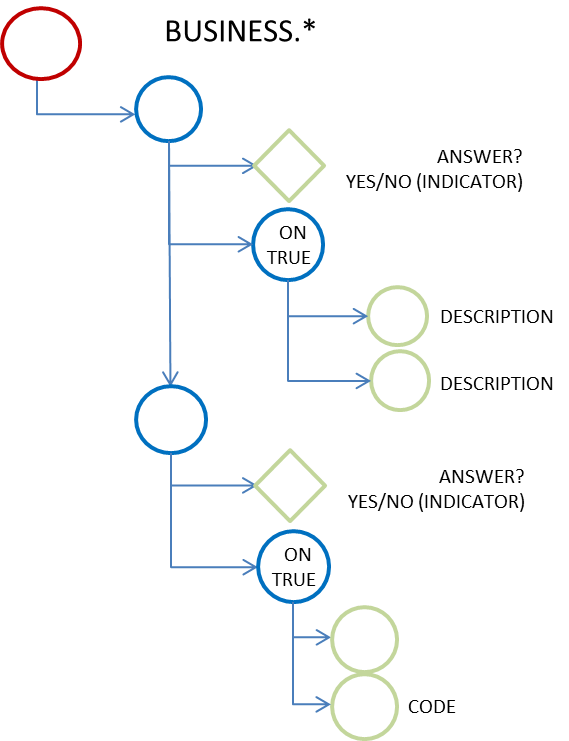
The piece of XML below is a fragment of an ESPD Request XML document. This fragment shows the implementation of the Criterion ''Bankruptcy'':
<ccv:Criterion>
<cbc:ID schemeID="CriteriaID" schemeAgencyID="EU-COM-GROW" schemeVersionID="1.0">d3732c09-7d62-4edc-a172-241da6636e7c</cbc:ID>
<cbc:TypeCode listID="CriteriaTypeCode" listAgencyID="EU-COM-GROW" listVersionID="1.0.2">CRITERION.EXCLUSION.BUSINESS.BANKRUPTCY</cbc:TypeCode>
<cbc:Name>Bankruptcy</cbc:Name>
<cbc:Description>Is the economic operator bankrupt? This information needs not be given if exclusion of economic operators in this case has been made mandatory under the applicable national law without any possibility of derogation where the economic operator is nevertheless able to perform the contract.</cbc:Description>
<ccv:LegislationReference>
<ccv-cbc:Title>DIRECTIVE 2014/24/EU OF THE EUROPEAN PARLIAMENT AND OF THE COUNCIL of 26 February 2014 on public procurement and repealing Directive 2004/18/EC</ccv-cbc:Title>
<cbc:Description>Directive 2014/24/EU</cbc:Description>
<ccv-cbc:JurisdictionLevelCode listID="CriterionJurisdictionLevel" listAgencyID="EU-COM-GROW" listVersionID="1.0.2">EU_DIRECTIVE</ccv-cbc:JurisdictionLevelCode>
<ccv-cbc:Article>57(4)</ccv-cbc:Article>
<cbc:URI>http://eur-lex.europa.eu/legal-content/EN/TXT/?uri=celex:32014L0024</cbc:URI>
</ccv:LegislationReference>
<ccv:RequirementGroup>
<cbc:ID schemeAgencyID="EU-COM-GROW" schemeVersionID="1.0">d91c11a1-f19e-4b83-8ade-c4be2bf00555</cbc:ID>
<ccv:Requirement responseDataType="INDICATOR">
<cbc:ID schemeID="CriterionRelatedIDs" schemeAgencyID="EU-COM-GROW" schemeVersionID="1.0">974c8196-9d1c-419c-9ca9-45bb9f5fd59a</cbc:ID>
<cbc:Description>Your answer?</cbc:Description>
<ccv:Response>
<ccv-cbc:Indicator>true</ccv-cbc:Indicator>
</ccv:Response>
</ccv:Requirement>
<ccv:RequirementGroup pi="GROUP_FULFILLED.ON_TRUE">
<cbc:ID schemeAgencyID="EU-COM-GROW" schemeVersionID="1.0">aeef523b-c8fc-4dba-9c34-03e34812567b</cbc:ID>
<ccv:Requirement responseDataType="DESCRIPTION">
<cbc:ID schemeID="CriterionRelatedIDs" schemeAgencyID="EU-COM-GROW" schemeVersionID="1.0">e098da8e-4717-4500-965f-f882d5b4e1ad</cbc:ID>
<cbc:Description>Please describe them</cbc:Description>
<ccv:Response>
<cbc:Description>Learn about the disability and how you can help. Get to know the person and the caregiver.
Show compassion, sensitivity, and sincerity by respecting the individual’s wishes. Maintain a balance between helping and allowing the individual to grow by providing for himself or herself.
Prepare to accommodate individuals with a physical disability before Church meetings and activities begin. This may include providing ramps, seating accommodations, access to all facilities (including the pulpit), and media equipment. Facilities should be accessible to those who use wheelchairs, braces, artificial limbs, other assistive devices, or assistive animals.</cbc:Description>
</ccv:Response>
</ccv:Requirement>
<ccv:Requirement responseDataType="DESCRIPTION">
<cbc:ID schemeID="CriterionRelatedIDs" schemeAgencyID="EU-COM-GROW" schemeVersionID="1.0">4e3f468a-86c4-4c99-bd15-c8b221229348</cbc:ID>
<cbc:Description>Indicate reasons for being nevertheless to perform the contract</cbc:Description>
<ccv:Response>
<cbc:Description>Learn about the disability and how you can help. Get to know the person and the caregiver.
Show compassion, sensitivity, and sincerity by respecting the individual’s wishes. Maintain a balance between helping and allowing the individual to grow by providing for himself or herself.
Prepare to accommodate individuals with a physical disability before Church meetings and activities begin. This may include providing ramps, seating accommodations, access to all facilities (including the pulpit), and media equipment. Facilities should be accessible to those who use wheelchairs, braces, artificial limbs, other assistive devices, or assistive animals.</cbc:Description>
</ccv:Response>
</ccv:Requirement>
</ccv:RequirementGroup>
</ccv:RequirementGroup>
<ccv:RequirementGroup>
<cbc:ID schemeAgencyID="EU-COM-GROW" schemeVersionID="1.0">7458d42a-e581-4640-9283-34ceb3ad4345</cbc:ID>
<ccv:Requirement responseDataType="INDICATOR">
<cbc:ID schemeID="CriterionRelatedIDs" schemeAgencyID="EU-COM-GROW" schemeVersionID="1.0">c1347b74-1872-4060-a6db-f4044edcd7c4</cbc:ID>
<cbc:Description>Is this information available electronically?</cbc:Description>
<ccv:Response>
<ccv-cbc:Indicator>true</ccv-cbc:Indicator>
</ccv:Response>
</ccv:Requirement>
<ccv:RequirementGroup pi="GROUP_FULFILLED.ON_TRUE">
<cbc:ID schemeAgencyID="EU-COM-GROW" schemeVersionID="1.0">41dd2e9b-1bfd-44c7-93ee-56bd74a4334b</cbc:ID>
<ccv:Requirement responseDataType="EVIDENCE_URL">
<cbc:ID schemeID="CriterionRelatedIDs" schemeAgencyID="EU-COM-GROW" schemeVersionID="1.0">f4313bb6-21b6-499e-bdff-debe10e11d2c</cbc:ID>
<cbc:Description>URL</cbc:Description>
<ccv:Response>
<cev:Evidence>
<cev:EvidenceDocumentReference>
<cbc:ID>5e3f7be6-ac84-4ad4-be34-38873e866f3f</cbc:ID>
<cac:Attachment>
<cac:ExternalReference>
<cbc:URI>https://www.lds.org/topics/disability/list/physical-disability?lang=eng</cbc:URI>
</cac:ExternalReference>
</cac:Attachment>
</cev:EvidenceDocumentReference>
</cev:Evidence>
</ccv:Response>
</ccv:Requirement>
<ccv:Requirement responseDataType="CODE">
<cbc:ID schemeID="CriterionRelatedIDs" schemeAgencyID="EU-COM-GROW" schemeVersionID="1.0">1f1cd18e-3e01-4ca2-af4c-e2981924ba8d</cbc:ID>
<cbc:Description>Code</cbc:Description>
<ccv:Response>
<ccv-cbc:Code>Bankruptcy code</ccv-cbc:Code>
</ccv:Response>
</ccv:Requirement>
</ccv:RequirementGroup>
</ccv:RequirementGroup>
</ccv:Criterion>-
The XML structure and elements of the above example reproduce the fragment of text in the Annex to the Regulation 2016/7 related to this criterion;
-
The general rules are respected;
-
The XML structure maps the data-structure; ;
-
The common evidence-related requirement group is herein used again.
Misconduct
The category ''Misconduct'' encompasses two criteria that share the same structure as the one used for the ''social'' group of criteria (see sub-section ''How to specify ''social'' related criteria, above).[17]
-
CRITERION.EXCLUSION.MISCONDUCT.*: ''guilty of grave professional misconduct''; and ''agreements with other economic operators aimed at distorting competition''.
This other figure below represents the data-structure:
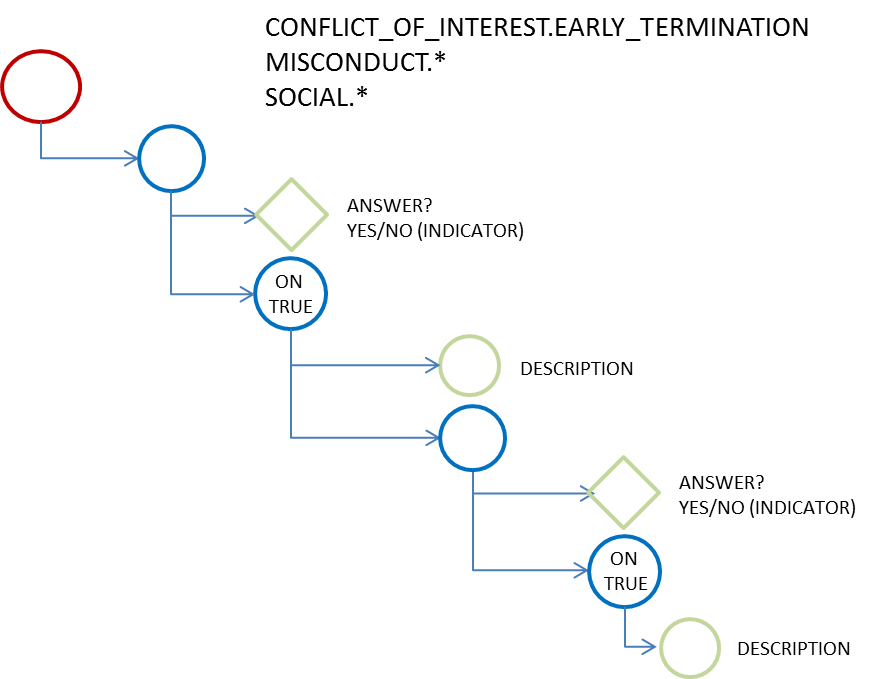
The piece of XML below is a fragment of an ESPD Response XML document. This fragment shows the implementation of the Criterion ''Guilty of grave professional misconduct'':
<ccv:Criterion>
<cbc:ID schemeID="CriteriaID" schemeAgencyID="EU-COM-GROW" schemeVersionID="1.0">514d3fde-1e3e-4dcd-b02a-9f984d5bbda3</cbc:ID>
<cbc:TypeCode listID="CriteriaTypeCode" listAgencyID="EU-COM-GROW" listVersionID="1.0.2">CRITERION.EXCLUSION.MISCONDUCT.MC_PROFESSIONAL</cbc:TypeCode>
<cbc:Name>Guilty of grave professional misconduct</cbc:Name>
<cbc:Description>Is the economic operator guilty of grave professional misconduct? Where applicable, see definitions in national law, the relevant notice or the procurement documents.</cbc:Description>
<ccv:LegislationReference>
<ccv-cbc:Title>DIRECTIVE 2014/24/EU OF THE EUROPEAN PARLIAMENT AND OF THE COUNCIL of 26 February 2014 on public procurement and repealing Directive 2004/18/EC</ccv-cbc:Title>
<cbc:Description>Directive 2014/24/EU</cbc:Description>
<ccv-cbc:JurisdictionLevelCode listID="CriterionJurisdictionLevel" listAgencyID="EU-COM-GROW" listVersionID="1.0.2">EU_DIRECTIVE</ccv-cbc:JurisdictionLevelCode>
<ccv-cbc:Article>57(4)</ccv-cbc:Article>
<cbc:URI>http://eur-lex.europa.eu/legal-content/EN/TXT/?uri=celex:32014L0024</cbc:URI>
</ccv:LegislationReference>
<ccv:RequirementGroup>
<cbc:ID schemeAgencyID="EU-COM-GROW" schemeVersionID="1.0">67362ec7-cec3-4cb8-a38e-5d7a2a31e6d8</cbc:ID>
<ccv:Requirement responseDataType="INDICATOR">
<cbc:ID schemeID="CriterionRelatedIDs" schemeAgencyID="EU-COM-GROW" schemeVersionID="1.0">974c8196-9d1c-419c-9ca9-45bb9f5fd59a</cbc:ID>
<cbc:Description>Your answer?</cbc:Description>
<ccv:Response>
<ccv-cbc:Indicator>true</ccv-cbc:Indicator>
</ccv:Response>
</ccv:Requirement>
<ccv:RequirementGroup pi="GROUP_FULFILLED.ON_TRUE">
<cbc:ID schemeAgencyID="EU-COM-GROW" schemeVersionID="1.0">2cbcf978-765c-40aa-996b-b1d082485cef</cbc:ID>
<ccv:Requirement responseDataType="DESCRIPTION">
<cbc:ID schemeID="CriterionRelatedIDs" schemeAgencyID="EU-COM-GROW" schemeVersionID="1.0">e098da8e-4717-4500-965f-f882d5b4e1ad</cbc:ID>
<cbc:Description>Please describe them</cbc:Description>
<ccv:Response>
<cbc:Description>Learn about the disability and how you can help. Get to know the person and the caregiver.
Show compassion, sensitivity, and sincerity by respecting the individual’s wishes. Maintain a balance between helping and allowing the individual to grow by providing for himself or herself.
Prepare to accommodate individuals with a physical disability before Church meetings and activities begin. This may include providing ramps, seating accommodations, access to all facilities (including the pulpit), and media equipment. Facilities should be accessible to those who use wheelchairs, braces, artificial limbs, other assistive devices, or assistive animals.</cbc:Description>
</ccv:Response>
</ccv:Requirement>
<ccv:RequirementGroup>
<cbc:ID schemeAgencyID="EU-COM-GROW" schemeVersionID="1.0">5f9f09f7-f701-432c-9fdc-c22c124a74c9</cbc:ID>
<ccv:Requirement responseDataType="INDICATOR">
<cbc:ID schemeID="CriterionRelatedIDs" schemeAgencyID="EU-COM-GROW" schemeVersionID="1.0">20c5361b-7599-4ee6-b030-7f8323174d1e</cbc:ID>
<cbc:Description>Have you taken measures to demonstrate your reliability 'Self-Cleaning'?</cbc:Description>
<ccv:Response>
<ccv-cbc:Indicator>true</ccv-cbc:Indicator>
</ccv:Response>
</ccv:Requirement>
<ccv:RequirementGroup pi="GROUP_FULFILLED.ON_TRUE">
<cbc:ID schemeAgencyID="EU-COM-GROW" schemeVersionID="1.0">74e6c7b4-757b-4b40-ada6-fad6a997c310</cbc:ID>
<ccv:Requirement responseDataType="DESCRIPTION">
<cbc:ID schemeID="CriterionRelatedIDs" schemeAgencyID="EU-COM-GROW" schemeVersionID="1.0">7b07904f-e080-401a-a3a1-9a3efeeda54b</cbc:ID>
<cbc:Description>Please describe them</cbc:Description>
<ccv:Response>
<cbc:Description>Guilty of grave professional misconduct descr</cbc:Description>
</ccv:Response>
</ccv:Requirement>
</ccv:RequirementGroup>
</ccv:RequirementGroup>
</ccv:RequirementGroup>
</ccv:RequirementGroup>
</ccv:Criterion>-
The XML structure and elements of the above example reproduce the fragment of text in the Annex to the Regulation 2016/7 related to this criterion;
-
The general rules are respected;
-
The XML structure maps the data-structure; ;
-
As for the group of ''social'' criteria no evidence is herein required.
Conflict of interest
The category ''Conflicts of Interest'' encompasses different exclusion criteria which are more heterogeneous than the ones described until now. Three different data structures are used in the ESPD Service to describe different conflict of interest criteria:
-
CRITERION.EXCLUSION.CONFLICT_OF_INTEREST.EARLY_TERMINATION: Conflict of interest due to ''early termination, damages or other comparable sanctions'';
-
CRITERION.EXCLUSION.CONFLICT_OF_INTEREST.PROCEDURE_PREPARATION: Conflict of interest due to ''direct or indirect involvement in the preparation of this procurement procedure'';
-
CRITERION.EXCLUSION.CONFLICT_OF_INTEREST.PROCEDURE_PARTICIPATION: Conflict of interest due to ''participation in the procurement procedure''; and
-
CRITERION.EXCLUSION.CONFLICT_OF_INTEREST.MISINTERPRETATION: Conflict of interest due for being ''guilty of misinterpretation, withheld information, able to provide required documents and obtained confidential information of this procedure''.
The following subsections show the data structures and examples for these three groups of criteria related to conflict of interests:
Early termination
The data structure for the criterion ''Early termination, damages or other comparable sanctions'' is the same as the ones used for the exclusion criteria groups [..].MINSCONDUCT.* and [..].SOCIAL.*:
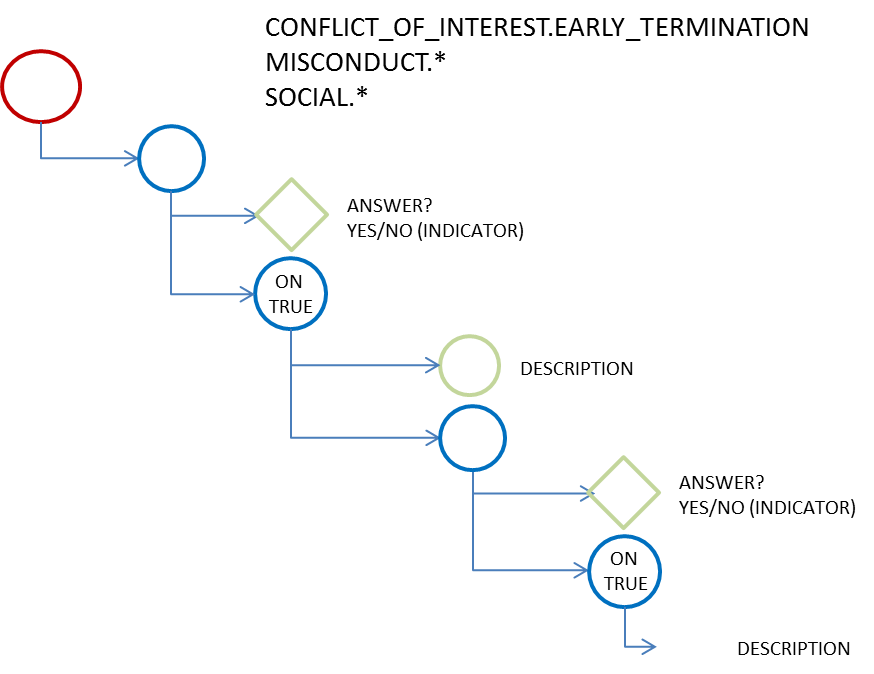
The piece of XML below is a fragment of an ESPD Response XML document. This fragment shows the implementation of the criterion ''Early termination'':
<ccv:Criterion>
<cbc:ID schemeID="CriteriaID" schemeAgencyID="EU-COM-GROW" schemeVersionID="1.0">3293e92b-7f3e-42f1-bee6-a7641bb04251</cbc:ID>
<cbc:TypeCode listID="CriteriaTypeCode" listAgencyID="EU-COM-GROW" listVersionID="1.0.2">CRITERION.EXCLUSION.CONFLICT_OF_INTEREST.EARLY_TERMINATION</cbc:TypeCode>
<cbc:Name>Early termination, damages or other comparable sanctions</cbc:Name>
<cbc:Description>Has the economic operator experienced that a prior public contract, a prior contract with a contracting entity or a prior concession contract was terminated early, or that damages or other comparable sanctions were imposed in connection with that prior contract?</cbc:Description>
<ccv:LegislationReference>
<ccv-cbc:Title>DIRECTIVE 2014/24/EU OF THE EUROPEAN PARLIAMENT AND OF THE COUNCIL of 26 February 2014 on public procurement and repealing Directive 2004/18/EC</ccv-cbc:Title>
<cbc:Description>Directive 2014/24/EU</cbc:Description>
<ccv-cbc:JurisdictionLevelCode listID="CriterionJurisdictionLevel" listAgencyID="EU-COM-GROW" listVersionID="1.0.2">EU_DIRECTIVE</ccv-cbc:JurisdictionLevelCode>
<ccv-cbc:Article>57(4)</ccv-cbc:Article>
<cbc:URI>http://eur-lex.europa.eu/legal-content/EN/TXT/?uri=celex:32014L0024</cbc:URI>
</ccv:LegislationReference>
<ccv:RequirementGroup>
<cbc:ID schemeAgencyID="EU-COM-GROW" schemeVersionID="1.0">67362ec7-cec3-4cb8-a38e-5d7a2a31e6d8</cbc:ID>
<ccv:Requirement responseDataType="INDICATOR">
<cbc:ID schemeID="CriterionRelatedIDs" schemeAgencyID="EU-COM-GROW" schemeVersionID="1.0">974c8196-9d1c-419c-9ca9-45bb9f5fd59a</cbc:ID>
<cbc:Description>Your answer?</cbc:Description>
<ccv:Response>
<ccv-cbc:Indicator>true</ccv-cbc:Indicator>
</ccv:Response>
</ccv:Requirement>
<ccv:RequirementGroup pi="GROUP_FULFILLED.ON_TRUE">
<cbc:ID schemeAgencyID="EU-COM-GROW" schemeVersionID="1.0">2cbcf978-765c-40aa-996b-b1d082485cef</cbc:ID>
<ccv:Requirement responseDataType="DESCRIPTION">
<cbc:ID schemeID="CriterionRelatedIDs" schemeAgencyID="EU-COM-GROW" schemeVersionID="1.0">e098da8e-4717-4500-965f-f882d5b4e1ad</cbc:ID>
<cbc:Description>Please describe them</cbc:Description>
<ccv:Response>
<cbc:Description>Learn about the disability and how you can help. Get to know the person and the caregiver.
Show compassion, sensitivity, and sincerity by respecting the individual’s wishes. Maintain a balance between helping and allowing the individual to grow by providing for himself or herself.
Prepare to accommodate individuals with a physical disability before Church meetings and activities begin. This may include providing ramps, seating accommodations, access to all facilities (including the pulpit), and media equipment. Facilities should be accessible to those who use wheelchairs, braces, artificial limbs, other assistive devices, or assistive animals.</cbc:Description>
</ccv:Response>
</ccv:Requirement>
<ccv:RequirementGroup>
<cbc:ID schemeAgencyID="EU-COM-GROW" schemeVersionID="1.0">5f9f09f7-f701-432c-9fdc-c22c124a74c9</cbc:ID>
<ccv:Requirement responseDataType="INDICATOR">
<cbc:ID schemeID="CriterionRelatedIDs" schemeAgencyID="EU-COM-GROW" schemeVersionID="1.0">20c5361b-7599-4ee6-b030-7f8323174d1e</cbc:ID>
<cbc:Description>Have you taken measures to demonstrate your reliability 'Self-Cleaning'?</cbc:Description>
<ccv:Response>
<ccv-cbc:Indicator>true</ccv-cbc:Indicator>
</ccv:Response>
</ccv:Requirement>
<ccv:RequirementGroup pi="GROUP_FULFILLED.ON_TRUE">
<cbc:ID schemeAgencyID="EU-COM-GROW" schemeVersionID="1.0">74e6c7b4-757b-4b40-ada6-fad6a997c310</cbc:ID>
<ccv:Requirement responseDataType="DESCRIPTION">
<cbc:ID schemeID="CriterionRelatedIDs" schemeAgencyID="EU-COM-GROW" schemeVersionID="1.0">7b07904f-e080-401a-a3a1-9a3efeeda54b</cbc:ID>
<cbc:Description>Please describe them</cbc:Description>
<ccv:Response>
<cbc:Description>Early termination, damages or other comparable sanctions descr</cbc:Description>
</ccv:Response>
</ccv:Requirement>
</ccv:RequirementGroup>
</ccv:RequirementGroup>
</ccv:RequirementGroup>
</ccv:RequirementGroup>
</ccv:Criterion>-
The XML structure and elements of the above example reproduce the fragment of text in the Annex to the Regulation 2016/7 related to this criterion;
-
The general rules are respected;
-
The XML structure maps the data-structure; ;
-
As for the group of ''social' criteria no evidence is herein required.
Procedure preparation
The data structures for the criterion ''Direct or indirect involvement in the preparation of this procurement procedure'' are the simplest ones:
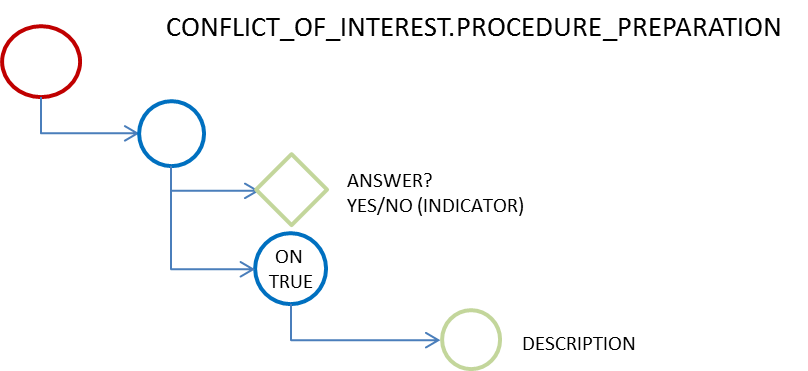
The piece of XML below corresponds to the implementation of the criterion ''Direct or indirect involvement in the preparation of this procurement procedure'' :
<ccv:Criterion>
<cbc:ID schemeID="CriteriaID" schemeAgencyID="EU-COM-GROW" schemeVersionID="1.0">61874050-5130-4f1c-a174-720939c7b483</cbc:ID>
<cbc:TypeCode listID="CriteriaTypeCode" listAgencyID="EU-COM-GROW" listVersionID="1.0.2">CRITERION.EXCLUSION.CONFLICT_OF_INTEREST.PROCEDURE_PREPARATION</cbc:TypeCode>
<cbc:Name>Direct or indirect involvement in the preparation of this procurement procedure</cbc:Name>
<cbc:Description>Has the economic operator or an undertaking related to it advised the contracting authority or contracting entity or otherwise been involved in the preparation of the procurement procedure?</cbc:Description>
<ccv:LegislationReference>
<ccv-cbc:Title>DIRECTIVE 2014/24/EU OF THE EUROPEAN PARLIAMENT AND OF THE COUNCIL of 26 February 2014 on public procurement and repealing Directive 2004/18/EC</ccv-cbc:Title>
<cbc:Description>Directive 2014/24/EU</cbc:Description>
<ccv-cbc:JurisdictionLevelCode listID="CriterionJurisdictionLevel" listAgencyID="EU-COM-GROW" listVersionID="1.0.2">EU_DIRECTIVE</ccv-cbc:JurisdictionLevelCode>
<ccv-cbc:Article>57(4)</ccv-cbc:Article>
<cbc:URI>http://eur-lex.europa.eu/legal-content/EN/TXT/?uri=celex:32014L0024</cbc:URI>
</ccv:LegislationReference>
<ccv:RequirementGroup>
<cbc:ID schemeAgencyID="EU-COM-GROW" schemeVersionID="1.0">77ae3f29-7c5f-4afa-af97-24afec48c5bf</cbc:ID>
<ccv:Requirement responseDataType="INDICATOR">
<cbc:ID schemeID="CriterionRelatedIDs" schemeAgencyID="EU-COM-GROW" schemeVersionID="1.0">974c8196-9d1c-419c-9ca9-45bb9f5fd59a</cbc:ID>
<cbc:Description>Your answer?</cbc:Description>
<ccv:Response>
<ccv-cbc:Indicator>true</ccv-cbc:Indicator>
</ccv:Response>
</ccv:Requirement>
<ccv:RequirementGroup pi="GROUP_FULFILLED.ON_TRUE">
<cbc:ID schemeAgencyID="EU-COM-GROW" schemeVersionID="1.0">73f0fe4c-4ed9-4343-8096-d898cf200146</cbc:ID>
<ccv:Requirement responseDataType="DESCRIPTION">
<cbc:ID schemeID="CriterionRelatedIDs" schemeAgencyID="EU-COM-GROW" schemeVersionID="1.0">e098da8e-4717-4500-965f-f882d5b4e1ad</cbc:ID>
<cbc:Description>Please describe them</cbc:Description>
<ccv:Response>
<cbc:Description>Learn about the disability and how you can help. Get to know the person and the caregiver.
Show compassion, sensitivity, and sincerity by respecting the individual’s wishes. Maintain a balance between helping and allowing the individual to grow by providing for himself or herself.
Prepare to accommodate individuals with a physical disability before Church meetings and activities begin. This may include providing ramps, seating accommodations, access to all facilities (including the pulpit), and media equipment. Facilities should be accessible to those who use wheelchairs, braces, artificial limbs, other assistive devices, or assistive animals.</cbc:Description>
</ccv:Response>
</ccv:Requirement>
</ccv:RequirementGroup>
</ccv:RequirementGroup>
</ccv:Criterion>-
The XML structure and elements of the above example reproduce the fragment of text in the Annex to the Regulation 2016/7 related to this criterion;
-
The general rules are respected;
-
The XML structure maps the data-structure; .
Procedure participation
Data structure for the criterion ''Conflict of interest due to its participation in the procurement procedure'':

The piece of XML below is a fragment of an ESPD Response XML document. This fragment shows the implementation of the conflict of interest criterion ''Conflict of interest due to its participation in the procurement procedure'' (file Example1-ESPDResponse-total fake-Wayne Enterprises.xml):
<ccv:Criterion>
<cbc:ID schemeID="CriteriaID" schemeAgencyID="EU-COM-GROW" schemeVersionID="1.0">b1b5ac18-f393-4280-9659-1367943c1a2e</cbc:ID>
<cbc:TypeCode listID="CriteriaTypeCode" listAgencyID="EU-COM-GROW" listVersionID="1.0.2">CRITERION.EXCLUSION.CONFLICT_OF_INTEREST.PROCEDURE_PARTICIPATION</cbc:TypeCode>
<cbc:Name>Conflict of interest due to its participation in the procurement procedure</cbc:Name>
<cbc:Description>Is the economic operator aware of any conflict of interest, as indicated in national law, the relevant notice or the procurement documents due to its participation in the procurement procedure?</cbc:Description>
<ccv:LegislationReference>
<ccv-cbc:Title>DIRECTIVE 2014/24/EU OF THE EUROPEAN PARLIAMENT AND OF THE COUNCIL of 26 February 2014 on public procurement and repealing Directive 2004/18/EC</ccv-cbc:Title>
<cbc:Description>Directive 2014/24/EU</cbc:Description>
<ccv-cbc:JurisdictionLevelCode listID="CriterionJurisdictionLevel" listAgencyID="EU-COM-GROW" listVersionID="1.0.2">EU_DIRECTIVE</ccv-cbc:JurisdictionLevelCode>
<ccv-cbc:Article>57(4)</ccv-cbc:Article>
<cbc:URI>http://eur-lex.europa.eu/legal-content/EN/TXT/?uri=celex:32014L0024</cbc:URI>
</ccv:LegislationReference>
<ccv:RequirementGroup>
<cbc:ID schemeAgencyID="EU-COM-GROW" schemeVersionID="1.0">30450436-f559-4dfa-98ba-f0842ed9d2a0</cbc:ID>
<ccv:Requirement responseDataType="INDICATOR">
<cbc:ID schemeID="CriterionRelatedIDs" schemeAgencyID="EU-COM-GROW" schemeVersionID="1.0">974c8196-9d1c-419c-9ca9-45bb9f5fd59a</cbc:ID>
<cbc:Description>Your answer?</cbc:Description>
<ccv:Response>
<ccv-cbc:Indicator>true</ccv-cbc:Indicator>
</ccv:Response>
</ccv:Requirement>
</ccv:RequirementGroup>
</ccv:Criterion>-
The XML structure and elements of the above example reproduce the fragment of text in the Annex to the Regulation 2016/7 related to this criterion;
-
The general rules are respected;
-
The XML structure maps the data-structure; .
Misinterpretation
Data structure for the criterion ''Guilty of misinterpretation, withheld information, able to provide required documents and obtained confidential information of this procedure'':
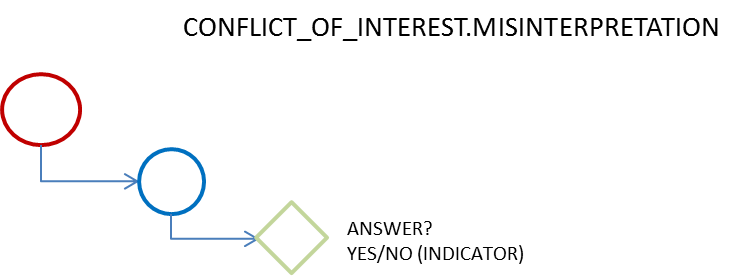
This fragment of XMl code shows the implementation of the conflict of interest criterion ''Guilty of misinterpretation, withheld information, unable to provide required documents and obtained confidential information of this procedure'':
<ccv:Criterion>
<cbc:ID schemeID="CriteriaID" schemeAgencyID="EU-COM-GROW" schemeVersionID="1.0">696a75b2-6107-428f-8b74-82affb67e184</cbc:ID>
<cbc:TypeCode listID="CriteriaTypeCode" listAgencyID="EU-COM-GROW" listVersionID="1.0.2">CRITERION.EXCLUSION.CONFLICT_OF_INTEREST.MISINTERPRETATION</cbc:TypeCode>
<cbc:Name>Guilty of misinterpretation, withheld information, unable to provide required documents and obtained confidential information of this procedure</cbc:Name>
<cbc:Description>Can the economic operator confirm the four exclusion grounds, that it has not been guilty of serious misrepresentation in supplying the information required for the verification of the absence of grounds for exclusion or the fulfilment of the selection criteria, that it has not withheld such information, it has been able, without delay, to submit the supporting documents required by a contracting authority or contracting entity, and it has not undertaken to unduly influence the decision making process of the contracting authority or contracting entity, to obtain confidential information that may confer upon it undue advantages in the procurement procedure or to negligently provide misleading information that may have a material influence on decisions concerning exclusion, selection or award?</cbc:Description>
<ccv:LegislationReference>
<ccv-cbc:Title>DIRECTIVE 2014/24/EU OF THE EUROPEAN PARLIAMENT AND OF THE COUNCIL of 26 February 2014 on public procurement and repealing Directive 2004/18/EC</ccv-cbc:Title>
<cbc:Description>Directive 2014/24/EU</cbc:Description>
<ccv-cbc:JurisdictionLevelCode listID="CriterionJurisdictionLevel" listAgencyID="EU-COM-GROW" listVersionID="1.0.2">EU_DIRECTIVE</ccv-cbc:JurisdictionLevelCode>
<ccv-cbc:Article>57(4)</ccv-cbc:Article>
<cbc:URI>http://eur-lex.europa.eu/legal-content/EN/TXT/?uri=celex:32014L0024</cbc:URI>
</ccv:LegislationReference>
<ccv:RequirementGroup>
<cbc:ID schemeAgencyID="EU-COM-GROW" schemeVersionID="1.0">30450436-f559-4dfa-98ba-f0842ed9d2a0</cbc:ID>
<ccv:Requirement responseDataType="INDICATOR">
<cbc:ID schemeID="CriterionRelatedIDs" schemeAgencyID="EU-COM-GROW" schemeVersionID="1.0">974c8196-9d1c-419c-9ca9-45bb9f5fd59a</cbc:ID>
<cbc:Description>Your answer?</cbc:Description>
<ccv:Response>
<ccv-cbc:Indicator>true</ccv-cbc:Indicator>
</ccv:Response>
</ccv:Requirement>
</ccv:RequirementGroup>
</ccv:Criterion>-
The XML structure and elements of the above example reproduce the fragment of text in the Annex to the Regulation 2016/7 related to this criterion;
-
The general rules are respected;
-
The XML structure maps the data-structure; .
Other national
Additionally to the exclusion criteria indicated in the Directive the Contracting Authorities MAY add other exclusion criteria that are specific to their Member State at a national or subnational level.
This is the objective of the category NATIONAL.OTHER:
-
CRITERION.EXCLUSION.NATIONAL.OTHER: ''Purely national exclusion grounds'', which data structure is as simple as the one illustrated below:

The piece of XML below shows the implementation of the Criterion ''Purely national exclusion grounds'':
<ccv:Criterion>
<cbc:ID schemeID="CriteriaID" schemeAgencyID="EU-COM-GROW" schemeVersionID="1.0">63adb07d-db1b-4ef0-a14e-a99785cf8cf6</cbc:ID>
<cbc:TypeCode listID="CriteriaTypeCode" listAgencyID="EU-COM-GROW" listVersionID="1.0.2">CRITERION.EXCLUSION.NATIONAL.OTHER</cbc:TypeCode>
<cbc:Name>Purely national exclusion grounds</cbc:Name>
<cbc:Description>Other exclusion grounds that may be foreseen in the national legislation of the contracting authority’s or contracting entity’s Member State. Do the purely national grounds of exclusion, which are specified in the relevant notice or in the procurement documents, apply?</cbc:Description>
<ccv:LegislationReference>
<ccv-cbc:Title>DIRECTIVE 2014/24/EU OF THE EUROPEAN PARLIAMENT AND OF THE COUNCIL of 26 February 2014 on public procurement and repealing Directive 2004/18/EC</ccv-cbc:Title>
<cbc:Description>Directive 2014/24/EU</cbc:Description>
<ccv-cbc:JurisdictionLevelCode listID="CriterionJurisdictionLevel" listAgencyID="EU-COM-GROW" listVersionID="1.0.2">EU_DIRECTIVE</ccv-cbc:JurisdictionLevelCode>
<ccv-cbc:Article>57(4)</ccv-cbc:Article>
<cbc:URI>http://eur-lex.europa.eu/legal-content/EN/TXT/?uri=celex:32014L0024</cbc:URI>
</ccv:LegislationReference>
<ccv:RequirementGroup>
<cbc:ID schemeAgencyID="EU-COM-GROW" schemeVersionID="1.0">77ae3f29-7c5f-4afa-af97-24afec48c5bf</cbc:ID>
<ccv:Requirement responseDataType="INDICATOR">
<cbc:ID schemeID="CriterionRelatedIDs" schemeAgencyID="EU-COM-GROW" schemeVersionID="1.0">974c8196-9d1c-419c-9ca9-45bb9f5fd59a</cbc:ID>
<cbc:Description>Your answer?</cbc:Description>
<ccv:Response>
<ccv-cbc:Indicator>true</ccv-cbc:Indicator>
</ccv:Response>
</ccv:Requirement>
<ccv:RequirementGroup pi="GROUP_FULFILLED.ON_TRUE">
<cbc:ID schemeAgencyID="EU-COM-GROW" schemeVersionID="1.0">73f0fe4c-4ed9-4343-8096-d898cf200146</cbc:ID>
<ccv:Requirement responseDataType="DESCRIPTION">
<cbc:ID schemeID="CriterionRelatedIDs" schemeAgencyID="EU-COM-GROW" schemeVersionID="1.0">e098da8e-4717-4500-965f-f882d5b4e1ad</cbc:ID>
<cbc:Description>Please describe them</cbc:Description>
<ccv:Response>
<cbc:Description>Learn about the disability and how you can help. Get to know the person and the caregiver.
Show compassion, sensitivity, and sincerity by respecting the individual’s wishes. Maintain a balance between helping and allowing the individual to grow by providing for himself or herself.
Prepare to accommodate individuals with a physical disability before Church meetings and activities begin. This may include providing ramps, seating accommodations, access to all facilities (including the pulpit), and media equipment. Facilities should be accessible to those who use wheelchairs, braces, artificial limbs, other assistive devices, or assistive animals.</cbc:Description>
</ccv:Response>
</ccv:Requirement>
</ccv:RequirementGroup>
</ccv:RequirementGroup>
<ccv:RequirementGroup>
<cbc:ID schemeAgencyID="EU-COM-GROW" schemeVersionID="1.0">7458d42a-e581-4640-9283-34ceb3ad4345</cbc:ID>
<ccv:Requirement responseDataType="INDICATOR">
<cbc:ID schemeID="CriterionRelatedIDs" schemeAgencyID="EU-COM-GROW" schemeVersionID="1.0">c1347b74-1872-4060-a6db-f4044edcd7c4</cbc:ID>
<cbc:Description>Is this information available electronically?</cbc:Description>
<ccv:Response>
<ccv-cbc:Indicator>true</ccv-cbc:Indicator>
</ccv:Response>
</ccv:Requirement>
<ccv:RequirementGroup pi="GROUP_FULFILLED.ON_TRUE">
<cbc:ID schemeAgencyID="EU-COM-GROW" schemeVersionID="1.0">41dd2e9b-1bfd-44c7-93ee-56bd74a4334b</cbc:ID>
<ccv:Requirement responseDataType="EVIDENCE_URL">
<cbc:ID schemeID="CriterionRelatedIDs" schemeAgencyID="EU-COM-GROW" schemeVersionID="1.0">f4313bb6-21b6-499e-bdff-debe10e11d2c</cbc:ID>
<cbc:Description>URL</cbc:Description>
<ccv:Response>
<cev:Evidence>
<cev:EvidenceDocumentReference>
<cbc:ID>ce57fb28-353e-494f-aec0-a930eb146042</cbc:ID>
<cac:Attachment>
<cac:ExternalReference>
<cbc:URI>https://www.lds.org/topics/disability/list/physical-disability?lang=eng</cbc:URI>
</cac:ExternalReference>
</cac:Attachment>
</cev:EvidenceDocumentReference>
</cev:Evidence>
</ccv:Response>
</ccv:Requirement>
<ccv:Requirement responseDataType="CODE">
<cbc:ID schemeID="CriterionRelatedIDs" schemeAgencyID="EU-COM-GROW" schemeVersionID="1.0">1f1cd18e-3e01-4ca2-af4c-e2981924ba8d</cbc:ID>
<cbc:Description>Code</cbc:Description>
<ccv:Response>
<ccv-cbc:Code>Purely national exclusion grounds code</ccv-cbc:Code>
</ccv:Response>
</ccv:Requirement>
</ccv:RequirementGroup>
</ccv:RequirementGroup>
</ccv:Criterion>-
The XML structure and elements of the above example reproduce the fragment of text in the Annex to the Regulation 2016/7 related to this criterion;
-
The general rules are respected;
-
The XML structure maps the data-structure;
2. SELECTION CRITERIA
The range of criteria related to the selection of Economic Operators is larger and more heterogeneous than the one related to the exclusion criteria. The figure below is intended to identify and list all the categories (branches in text boxes) and criteria (leaves in text without boxes):

Some groups or sub-groups of selection criteria share the same structure, while other have their own specific structure. Beware that, differently to the exclusion criteria, some selection criteria do not provide additional data when answering ''Yes'' to the criterion question. When this occurs the ''yes'' answer is ''the'' expected data. This is clearly illustrated for the selection suitability criteria in the next subsection below.
|
Remember that the data structures corresponding to the data-flow diagrams shown in this section can be accessed online (click here). |
Suitability
The criteria under the category ''Suitability'' use two groups of simple data structures:
-
I) (Enrolments) CRITERION.SELECTION.SUITABILITY.PROFESSIONAL_REGISTER_ENROLMENT, and CRITERION.SELECTION.SUITABILITY.TRADE_REGISTER_ENROLMENT: ''Enrolment in a relevant professional register'' and ''Enrolment in a trade register'';
-
II) (Authorisations and memberships) CRITERION.SELECTION.SUITABILITY.AUTHORISATION, and CRITERION.SELECTION.SUITABILITY.MEMBERSHIP: ''For service contracts: authorisation of particular organisation needed'', and ''For service contracts: membership of particular organisation needed''.
Enrolment
The two criteria of the first group (enrolment) share the structure shown in the table below (the table refers to the criterion ''Enrolment in a relevant professional register'' (See the ttps://webgate.ec.europa.eu/fpfis/wikis/display/EPROC/ESPD+Criteria%3A+Selection+Criteria[data structure table] for the details about the rest of the criterion).
The data-structure diagram is represented in the figure below:
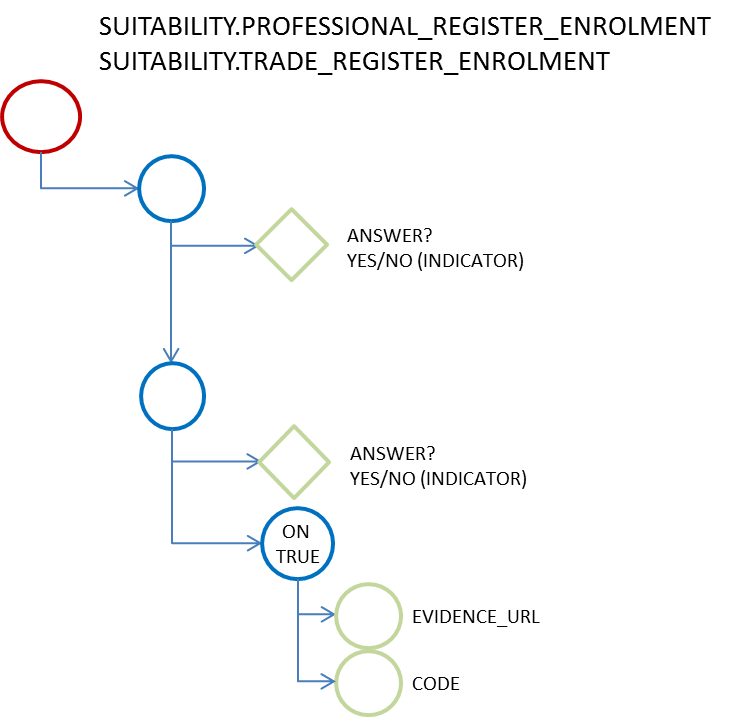
|
For the requirement R 1.1, both answers ''Yes'' or ''No'' redirect the flow of the data to the next requirement. However, the application controlling this flow (e.g. the ESPD Service) will persist and use.[18] the answer before deciding skipping to the next requirement. |
The fragment of XML below shows the implementation of the ''Enrolment in a relevant professional register'' criterion:
<ccv:Criterion>
<cbc:ID schemeID="CriteriaID" schemeAgencyID="EU-COM-GROW" schemeVersionID="1.0">6ee55a59-6adb-4c3a-b89f-e62a7ad7be7f</cbc:ID>
<cbc:TypeCode listID="CriteriaTypeCode" listAgencyID="EU-COM-GROW" listVersionID="1.0.2">CRITERION.SELECTION.SUITABILITY.PROFESSIONAL_REGISTER_ENROLMENT</cbc:TypeCode>
<cbc:Name>Enrolment in a relevant professional register</cbc:Name>
<cbc:Description>It is enrolled in relevant professional registers kept in the Member State of its establishment as described in Annex XI of Directive 2014/24/EU; economic operators from certain Member States may have to comply with other requirements set out in that Annex.</cbc:Description>
<ccv:LegislationReference>
<ccv-cbc:Title>DIRECTIVE 2014/24/EU OF THE EUROPEAN PARLIAMENT AND OF THE COUNCIL of 26 February 2014 on public procurement and repealing Directive 2004/18/EC</ccv-cbc:Title>
<cbc:Description>Directive 2014/24/EU</cbc:Description>
<ccv-cbc:JurisdictionLevelCode listID="CriterionJurisdictionLevel" listAgencyID="EU-COM-GROW" listVersionID="1.0.2">EU_DIRECTIVE</ccv-cbc:JurisdictionLevelCode>
<ccv-cbc:Article>58(2)</ccv-cbc:Article>
<cbc:URI>http://eur-lex.europa.eu/legal-content/EN/TXT/?uri=celex:32014L0024</cbc:URI>
</ccv:LegislationReference>
<ccv:RequirementGroup>
<cbc:ID schemeAgencyID="EU-COM-GROW" schemeVersionID="1.0">1768de86-a6c8-48e4-bd8e-de2f2f7424d0</cbc:ID>
<ccv:Requirement responseDataType="INDICATOR">
<cbc:ID schemeID="CriterionRelatedIDs" schemeAgencyID="EU-COM-GROW" schemeVersionID="1.0">15335c12-ad77-4728-b5ad-3c06a60d65a4</cbc:ID>
<cbc:Description>Your answer?</cbc:Description>
<ccv:Response>
<ccv-cbc:Indicator>true</ccv-cbc:Indicator>(1)
</ccv:Response>
</ccv:Requirement>
</ccv:RequirementGroup>
<ccv:RequirementGroup>
<cbc:ID schemeAgencyID="EU-COM-GROW" schemeVersionID="1.0">9026e403-3eb6-4705-a9e9-e21a1efc867d</cbc:ID>
<ccv:Requirement responseDataType="INDICATOR">
<cbc:ID schemeID="CriterionRelatedIDs" schemeAgencyID="EU-COM-GROW" schemeVersionID="1.0">9dae5670-cb75-4c97-901b-96ddac5a633a</cbc:ID>
<cbc:Description>Is this information available electronically?</cbc:Description>
<ccv:Response>
<ccv-cbc:Indicator>true</ccv-cbc:Indicator>
</ccv:Response>
</ccv:Requirement>
<ccv:RequirementGroup pi="GROUP_FULFILLED.ON_TRUE">
<cbc:ID schemeAgencyID="EU-COM-GROW" schemeVersionID="1.0">0a166f0a-0c5f-42b0-81e9-0fc9fa598a48</cbc:ID>
<ccv:Requirement responseDataType="EVIDENCE_URL">(2)
<cbc:ID schemeID="CriterionRelatedIDs" schemeAgencyID="EU-COM-GROW" schemeVersionID="1.0">03bb1954-13ae-47d8-8ef8-b7fe0f22d700</cbc:ID>
<cbc:Description>URL</cbc:Description>
<ccv:Response>
<cev:Evidence>
<cev:EvidenceDocumentReference>
<cbc:ID>9ac9f19b-e455-4564-a7c3-b95a345070d2</cbc:ID>
<cac:Attachment>
<cac:ExternalReference>
<cbc:URI>https://www.lds.org/topics/disability/list/physical-disability?lang=eng</cbc:URI>
</cac:ExternalReference>
</cac:Attachment>
</cev:EvidenceDocumentReference>
</cev:Evidence>
</ccv:Response>
</ccv:Requirement>
<ccv:Requirement responseDataType="CODE">
<cbc:ID schemeID="CriterionRelatedIDs" schemeAgencyID="EU-COM-GROW" schemeVersionID="1.0">e2d863a0-60cb-4e58-8c14-4c1595af48b7</cbc:ID>
<cbc:Description>Code</cbc:Description>
<ccv:Response>
<ccv-cbc:Code>Enrolment in a relevant professional register code</ccv-cbc:Code>
</ccv:Response>
</ccv:Requirement>
</ccv:RequirementGroup>
</ccv:RequirementGroup>
</ccv:Criterion>| 1 | The EO is enrolled in a professional register |
| 2 | It provides a URL where to get an online registration certificate |
|
Authorisation or membership
The only difference between this group of suitability criteria and the enrolment one, above, is that it adds a requirement asking for a description. See the Selection Criteria Table, data-structure and example below).
The fragment of XML below shows the implementation of the criterion ''For service contracts: authorisation of particular organisation needed'':
<ccv:Criterion>
<cbc:ID schemeID="CriteriaID" schemeAgencyID="EU-COM-GROW" schemeVersionID="1.0">9eeb6d5c-0eb8-48e8-a4c5-5087a7c095a4</cbc:ID>
<cbc:TypeCode listID="CriteriaTypeCode" listAgencyID="EU-COM-GROW" listVersionID="1.0.2">CRITERION.SELECTION.SUITABILITY.AUTHORISATION</cbc:TypeCode>
<cbc:Name>For service contracts: authorisation of particular organisation needed</cbc:Name>
<cbc:Description>Is a particular membership of a particular organisation needed in order to be able to perform the service in question in the country of establishment of the economic operator?</cbc:Description>
<ccv:LegislationReference>
<ccv-cbc:Title>DIRECTIVE 2014/24/EU OF THE EUROPEAN PARLIAMENT AND OF THE COUNCIL of 26 February 2014 on public procurement and repealing Directive 2004/18/EC</ccv-cbc:Title>
<cbc:Description>Directive 2014/24/EU</cbc:Description>
<ccv-cbc:JurisdictionLevelCode listID="CriterionJurisdictionLevel" listAgencyID="EU-COM-GROW" listVersionID="1.0.2">EU_DIRECTIVE</ccv-cbc:JurisdictionLevelCode>
<ccv-cbc:Article>58(2)</ccv-cbc:Article>
<cbc:URI>http://eur-lex.europa.eu/legal-content/EN/TXT/?uri=celex:32014L0024</cbc:URI>
</ccv:LegislationReference>
<ccv:RequirementGroup>
<cbc:ID schemeAgencyID="EU-COM-GROW" schemeVersionID="1.0">a109e144-f65e-469d-bcda-220f1af34b6c</cbc:ID>
<ccv:Requirement responseDataType="INDICATOR">
<cbc:ID schemeID="CriterionRelatedIDs" schemeAgencyID="EU-COM-GROW" schemeVersionID="1.0">15335c12-ad77-4728-b5ad-3c06a60d65a4</cbc:ID>
<cbc:Description>Your answer?</cbc:Description>
<ccv:Response>
<ccv-cbc:Indicator>true</ccv-cbc:Indicator>
</ccv:Response>
</ccv:Requirement>
<ccv:RequirementGroup pi="GROUP_FULFILLED.ON_TRUE">
<cbc:ID schemeAgencyID="EU-COM-GROW" schemeVersionID="1.0">7696fb3f-9722-43b8-9b91-ad59bb4b8ad2</cbc:ID>
<ccv:Requirement responseDataType="DESCRIPTION">
<cbc:ID schemeID="CriterionRelatedIDs" schemeAgencyID="EU-COM-GROW" schemeVersionID="1.0">51391308-0bf6-423c-95e2-d5a54aa31fb8</cbc:ID>
<cbc:Description>Please describe them</cbc:Description>
<ccv:Response>
<cbc:Description>Learn about the disability and how you can help. Get to know the person and the caregiver.
Show compassion, sensitivity, and sincerity by respecting the individual’s wishes. Maintain a balance between helping and allowing the individual to grow by providing for himself or herself.
Prepare to accommodate individuals with a physical disability before Church meetings and activities begin. This may include providing ramps, seating accommodations, access to all facilities (including the pulpit), and media equipment. Facilities should be accessible to those who use wheelchairs, braces, artificial limbs, other assistive devices, or assistive animals.</cbc:Description>
</ccv:Response>
</ccv:Requirement>
</ccv:RequirementGroup>
</ccv:RequirementGroup>
<ccv:RequirementGroup>
<cbc:ID schemeAgencyID="EU-COM-GROW" schemeVersionID="1.0">9026e403-3eb6-4705-a9e9-e21a1efc867d</cbc:ID>
<ccv:Requirement responseDataType="INDICATOR">
<cbc:ID schemeID="CriterionRelatedIDs" schemeAgencyID="EU-COM-GROW" schemeVersionID="1.0">9dae5670-cb75-4c97-901b-96ddac5a633a</cbc:ID>
<cbc:Description>Is this information available electronically?</cbc:Description>
<ccv:Response>
<ccv-cbc:Indicator>true</ccv-cbc:Indicator>
</ccv:Response>
</ccv:Requirement>
<ccv:RequirementGroup pi="GROUP_FULFILLED.ON_TRUE">
<cbc:ID schemeAgencyID="EU-COM-GROW" schemeVersionID="1.0">0a166f0a-0c5f-42b0-81e9-0fc9fa598a48</cbc:ID>
<ccv:Requirement responseDataType="EVIDENCE_URL">
<cbc:ID schemeID="CriterionRelatedIDs" schemeAgencyID="EU-COM-GROW" schemeVersionID="1.0">03bb1954-13ae-47d8-8ef8-b7fe0f22d700</cbc:ID>
<cbc:Description>URL</cbc:Description>
<ccv:Response>
<cev:Evidence>
<cev:EvidenceDocumentReference>
<cbc:ID>945331da-f91f-4040-a929-5499bf1386ec</cbc:ID>
<cac:Attachment>
<cac:ExternalReference>
<cbc:URI>https://www.lds.org/topics/disability/list/physical-disability?lang=eng</cbc:URI>
</cac:ExternalReference>
</cac:Attachment>
</cev:EvidenceDocumentReference>
</cev:Evidence>
</ccv:Response>
</ccv:Requirement>
<ccv:Requirement responseDataType="CODE">
<cbc:ID schemeID="CriterionRelatedIDs" schemeAgencyID="EU-COM-GROW" schemeVersionID="1.0">e2d863a0-60cb-4e58-8c14-4c1595af48b7</cbc:ID>
<cbc:Description>Code</cbc:Description>
<ccv:Response>
<ccv-cbc:Code>For service contracts: authorisation of particular organisation needed code</ccv-cbc:Code>
</ccv:Response>
</ccv:Requirement>
</ccv:RequirementGroup>
</ccv:RequirementGroup>
</ccv:Criterion>
|
Economic and financial standing
The ''Economic Financial Standing'' category encompasses one group of subcategories and four criteria with specific data structures:
-
CRITERION.SELECTION.ECONOMIC_FINANCIAL_STANDING.TURNOVER.*: ''General yearly turnover'', ''Average yearly turnover'', ''Specific yearly turnover'', ''Specific average turnover'';
-
CRITERION.SELECTION.ECONOMIC_FINANCIAL_STANDING.FINANCIAL_RATIO: it currently refers to ''Financial ratio''
-
CRITERION.SELECTION.ECONOMIC_FINANCIAL_STANDING.RISK_INDEMNITY_INSURANCE.PROFESIONAL: it currently refers to ''Professional risk indemnity insurance'';
-
CRITERION.SELECTION.ECONOMIC_FINANCIAL_STANDING.TURNOVER.SET_UP: ''Set up of economic operator'';
-
CRITERION.SELECTION.ECONOMIC_FINANCIAL_STANDING.OTHER_REQUIREMENTS: ''Other economic or financial requirements''.
The following subsections show the data structures and examples for these three groups of criteria related to economic and financial standing criteria.
Turnovers
The group of criteria relating to turnovers is somehow special in the sense that it introduces a kind of ''iterative structure'' that the criteria studied so far do not implement. As illustrated in the figures and example below, this iterative structure for turnovers allows repeating a specific tuple [19] of amount and year as many times as required in the specific call for tender (normally values for the past three years).
The simplified data structure illustrates this idea of iterative tuples (Year, Amount). The ''…'' symbol means that the subgroup is repeated as many times as required in the tender documents: The corresponding data-structure diagram would be this one. Notice that each tuple (Year, Amount) is treated as a subgroup of two requirements:
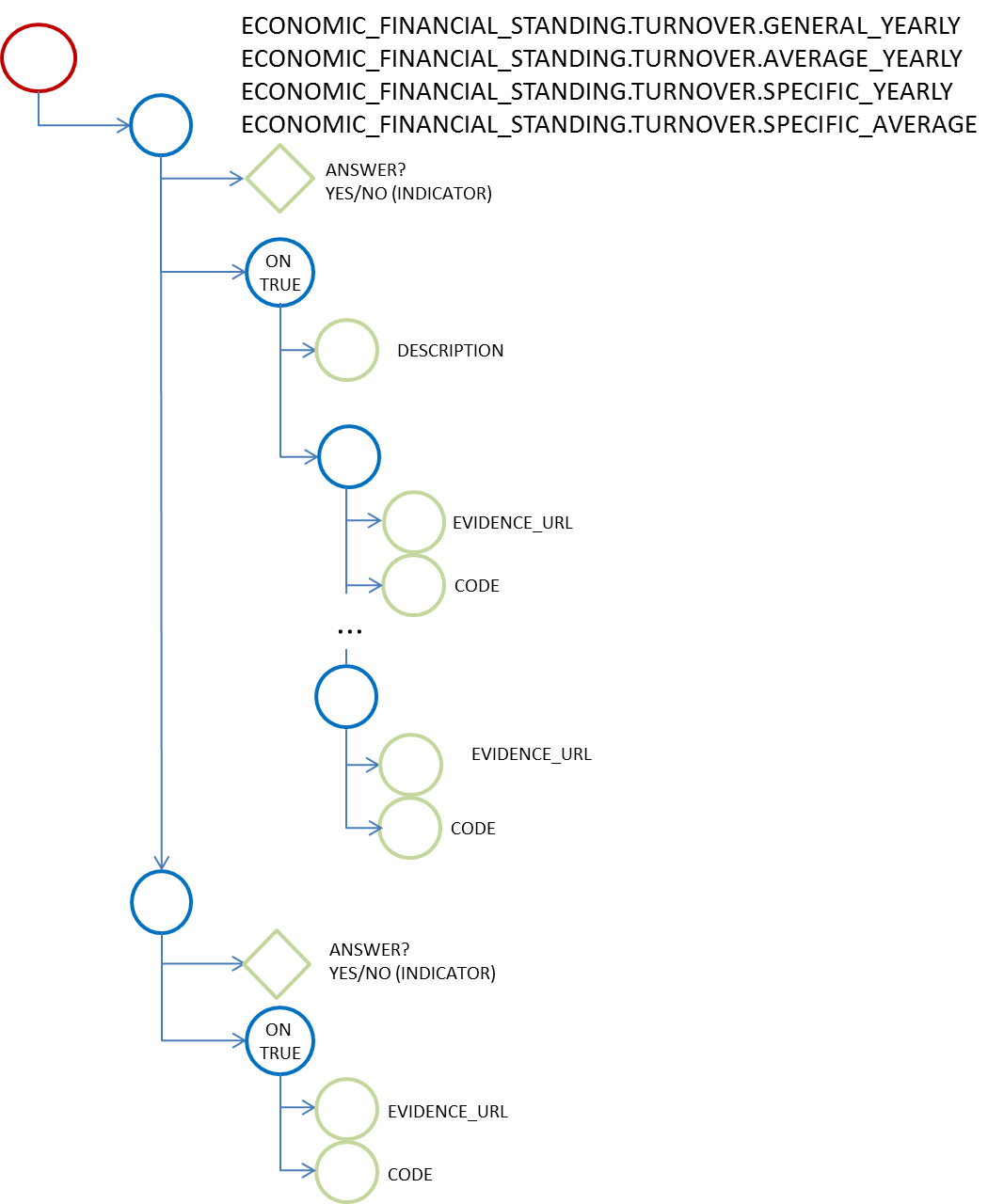
The fragment of XML below shows the implementation of the ''General yearly turnover'' criterion (file Example1-ESPDResponse-total fake-Wayne Enterprises.xml):
<ccv:Criterion>
<cbc:ID schemeID="CriteriaID" schemeAgencyID="EU-COM-GROW" schemeVersionID="1.0">499efc97-2ac1-4af2-9e84-323c2ca67747</cbc:ID>
<cbc:TypeCode listID="CriteriaTypeCode" listAgencyID="EU-COM-GROW" listVersionID="1.0.2">SELECTION.ECONOMIC_FINANCIAL_STANDING</cbc:TypeCode>
<cbc:Name>General yearly turnover</cbc:Name>
<cbc:Description>Its general yearly turnover for the number of financial years required in the relevant notice, the procurement documents or the ESPD is as follows:</cbc:Description>
<ccv:LegislationReference>
<ccv-cbc:Title>DIRECTIVE 2014/24/EU OF THE EUROPEAN PARLIAMENT AND OF THE COUNCIL of 26 February 2014 on public procurement and repealing Directive 2004/18/EC</ccv-cbc:Title>
<cbc:Description>On public procurement and repealing Directive 2004/18/EC</cbc:Description>
<ccv-cbc:JurisdictionLevelCode listID="CriterionJurisdictionLevel" listAgencyID="EU-COM-GROW" listVersionID="1.0.2">EU_DIRECTIVE</ccv-cbc:JurisdictionLevelCode>
<ccv-cbc:Article>58(3)</ccv-cbc:Article>
<cbc:URI>http://eur-lex.europa.eu/legal-content/EN/TXT/?uri=celex:32014L0024</cbc:URI>
</ccv:LegislationReference>
<ccv:RequirementGroup>
<cbc:ID schemeAgencyID="EU-COM-GROW" schemeVersionID="1.0">e1886054-ada4-473c-9afc-2fde82c24cf4</cbc:ID>
<ccv:Requirement responseDataType="INDICATOR">
<cbc:ID schemeID="CriterionRelatedIDs" schemeAgencyID="EU-COM-GROW" schemeVersionID="1.0">15335c12-ad77-4728-b5ad-3c06a60d65a4</cbc:ID>
<cbc:Description>Your answer?</cbc:Description>
<ccv:Response>
<ccv-cbc:Indicator>true</ccv-cbc:Indicator>(1)
</ccv:Response>
</ccv:Requirement>
<ccv:RequirementGroup>
<cbc:ID schemeAgencyID="EU-COM-GROW" schemeVersionID="1.0">1689194b-6ecf-4ab4-ab38-7656610c25bb</cbc:ID>
<ccv:Requirement responseDataType="QUANTITY_YEAR">
<cbc:ID schemeID="CriterionRelatedIDs" schemeAgencyID="EU-COM-GROW" schemeVersionID="1.0">5aacceb3-280e-42f1-b2da-3d8ac7877fe9</cbc:ID>
<cbc:Description>Year</cbc:Description>
<ccv:Response>
<cbc:Quantity unitCode="YEAR">2015</cbc:Quantity>(2)
</ccv:Response>
</ccv:Requirement>
<ccv:Requirement responseDataType="AMOUNT">
<cbc:ID schemeID="CriterionRelatedIDs" schemeAgencyID="EU-COM-GROW" schemeVersionID="1.0">42db0eaa-d2dd-48cb-83ac-38d73cab9b50</cbc:ID>
<cbc:Description>Amount</cbc:Description>
<ccv:Response>
<cbc:Amount currencyID="EUR">800000000</cbc:Amount>(3)
</ccv:Response>
</ccv:Requirement>
</ccv:RequirementGroup>
<ccv:RequirementGroup>
<cbc:ID schemeAgencyID="EU-COM-GROW" schemeVersionID="1.0">c628dd27-8016-4d80-8660-7461f2e3ee0f</cbc:ID>
<ccv:Requirement responseDataType="QUANTITY_YEAR">
<cbc:ID schemeID="CriterionRelatedIDs" schemeAgencyID="EU-COM-GROW" schemeVersionID="1.0">49a57870-7fb8-451f-a7af-fa0e7f8b97e7</cbc:ID>
<cbc:Description>Year</cbc:Description>
<ccv:Response>
<cbc:Quantity unitCode="YEAR">2014</cbc:Quantity>(4)
</ccv:Response>
</ccv:Requirement>
<ccv:Requirement responseDataType="AMOUNT">
<cbc:ID schemeID="CriterionRelatedIDs" schemeAgencyID="EU-COM-GROW" schemeVersionID="1.0">4acd0a02-c267-4d05-b456-c0565c2ffd46</cbc:ID>
<cbc:Description>Amount</cbc:Description>
<ccv:Response>
<cbc:Amount currencyID="EUR">750000000</cbc:Amount>(5)
</ccv:Response>
</ccv:Requirement>
</ccv:RequirementGroup>
<ccv:RequirementGroup>
<cbc:ID schemeAgencyID="EU-COM-GROW" schemeVersionID="1.0">9dd09f9f-3326-4865-9d5a-f0836076fb19</cbc:ID>
<ccv:Requirement responseDataType="QUANTITY_YEAR">
<cbc:ID schemeID="CriterionRelatedIDs" schemeAgencyID="EU-COM-GROW" schemeVersionID="1.0">9d0cf1cb-27bc-4747-8579-47dce4d8d490</cbc:ID>
<cbc:Description>Year</cbc:Description>
<ccv:Response>
<cbc:Quantity unitCode="YEAR">2013</cbc:Quantity>(6)
</ccv:Response>
</ccv:Requirement>
<ccv:Requirement responseDataType="AMOUNT">
<cbc:ID schemeID="CriterionRelatedIDs" schemeAgencyID="EU-COM-GROW" schemeVersionID="1.0">28fb4b41-5178-4b79-ba24-d9a62fa4a658</cbc:ID>
<cbc:Description>Amount</cbc:Description>
<ccv:Response>
<cbc:Amount currencyID="EUR">650000000</cbc:Amount>(7)
</ccv:Response>
</ccv:Requirement>
</ccv:RequirementGroup>
<ccv:RequirementGroup>
<cbc:ID schemeAgencyID="EU-COM-GROW" schemeVersionID="1.0">962011c9-9e2e-4e7b-818e-30e8506e874f</cbc:ID>
<ccv:Requirement responseDataType="QUANTITY_YEAR">
<cbc:ID schemeID="CriterionRelatedIDs" schemeAgencyID="EU-COM-GROW" schemeVersionID="1.0">17a7353d-a7a4-43ee-9cc8-b9db83eeafb3</cbc:ID>
<cbc:Description>Year</cbc:Description>
<ccv:Response>
<cbc:Quantity unitCode="YEAR">2012</cbc:Quantity>(8)
</ccv:Response>
</ccv:Requirement>
<ccv:Requirement responseDataType="AMOUNT">
<cbc:ID schemeID="CriterionRelatedIDs" schemeAgencyID="EU-COM-GROW" schemeVersionID="1.0">9f278e42-aa1d-4b2e-97cd-832248aa5393</cbc:ID>
<cbc:Description>Amount</cbc:Description>
<ccv:Response>
<cbc:Amount currencyID="EUR">620000000</cbc:Amount>
</ccv:Response>
</ccv:Requirement>
</ccv:RequirementGroup>
<ccv:RequirementGroup>
<cbc:ID schemeAgencyID="EU-COM-GROW" schemeVersionID="1.0">343795e2-98e9-4cc9-8ef2-8817cec8f49a</cbc:ID>
<ccv:Requirement responseDataType="QUANTITY_YEAR">
<cbc:ID schemeID="CriterionRelatedIDs" schemeAgencyID="EU-COM-GROW" schemeVersionID="1.0">34825634-5151-4e31-af1b-7eafadcf15be</cbc:ID>
<cbc:Description>Year</cbc:Description>
<ccv:Response>
<cbc:Quantity unitCode="YEAR">2011</cbc:Quantity>
</ccv:Response>
</ccv:Requirement>
<ccv:Requirement responseDataType="AMOUNT">
<cbc:ID schemeID="CriterionRelatedIDs" schemeAgencyID="EU-COM-GROW" schemeVersionID="1.0">cc1a0b1e-dbfd-4313-a4fb-2e543b05549b</cbc:ID>
<cbc:Description>Amount</cbc:Description>
<ccv:Response>
<cbc:Amount currencyID="EUR">590000000</cbc:Amount>
</ccv:Response>
</ccv:Requirement>
</ccv:RequirementGroup>
</ccv:RequirementGroup>
<ccv:RequirementGroup>
<cbc:ID schemeAgencyID="EU-COM-GROW" schemeVersionID="1.0">9026e403-3eb6-4705-a9e9-e21a1efc867d</cbc:ID>
<ccv:Requirement responseDataType="INDICATOR">
<cbc:ID schemeID="CriterionRelatedIDs" schemeAgencyID="EU-COM-GROW" schemeVersionID="1.0">9dae5670-cb75-4c97-901b-96ddac5a633a</cbc:ID>
<cbc:Description>Is this information available electronically?</cbc:Description>
<ccv:Response>
<ccv-cbc:Indicator>false</ccv-cbc:Indicator>
</ccv:Response>
</ccv:Requirement>
<ccv:Requirement responseDataType="EVIDENCE_URL">
<cbc:ID schemeID="CriterionRelatedIDs" schemeAgencyID="EU-COM-GROW" schemeVersionID="1.0">03bb1954-13ae-47d8-8ef8-b7fe0f22d700</cbc:ID>
<cbc:Description>URL</cbc:Description>
<ccv:Response/>
</ccv:Requirement>
<ccv:Requirement responseDataType="CODE">
<cbc:ID schemeID="CriterionRelatedIDs" schemeAgencyID="EU-COM-GROW" schemeVersionID="1.0">e2d863a0-60cb-4e58-8c14-4c1595af48b7</cbc:ID>
<cbc:Description>Code</cbc:Description>
<ccv:Response/>
</ccv:Requirement>
</ccv:RequirementGroup>
</ccv:Criterion>| 1 | Data is going to be provided by the EO, hence the ''true'' indicator |
| 2 | Year 2012 |
| 3 | Amount corresponding to year 2012 |
| 4 | Year 2013 |
| 5 | Amount corresponding to year 2013 |
| 6 | Year 2014 |
| 7 | Amount corresponding to year 2014 |
| 8 | etc. |
|
Ratio
For the time being the only type of ratio referred to in the ESPD is ''Financial Ratio'' (thus its inclusion under the Economic and Financial category of criteria). The structure of this criterion is identical to the one for turnovers. The only difference between them lies in the tuple of values required, (Description, Ratio) instead of (Year, Amount).
The simplified data structure illustrates this idea of iterative tuples (Description, Quantity). The ''…'' symbol means that the subgroup is repeated as many times as required in the tender documents:
The corresponding data-structure diagram would be this one. Notice that each tuple (Description, Quantity) is treated as a subgroup of two requirements:
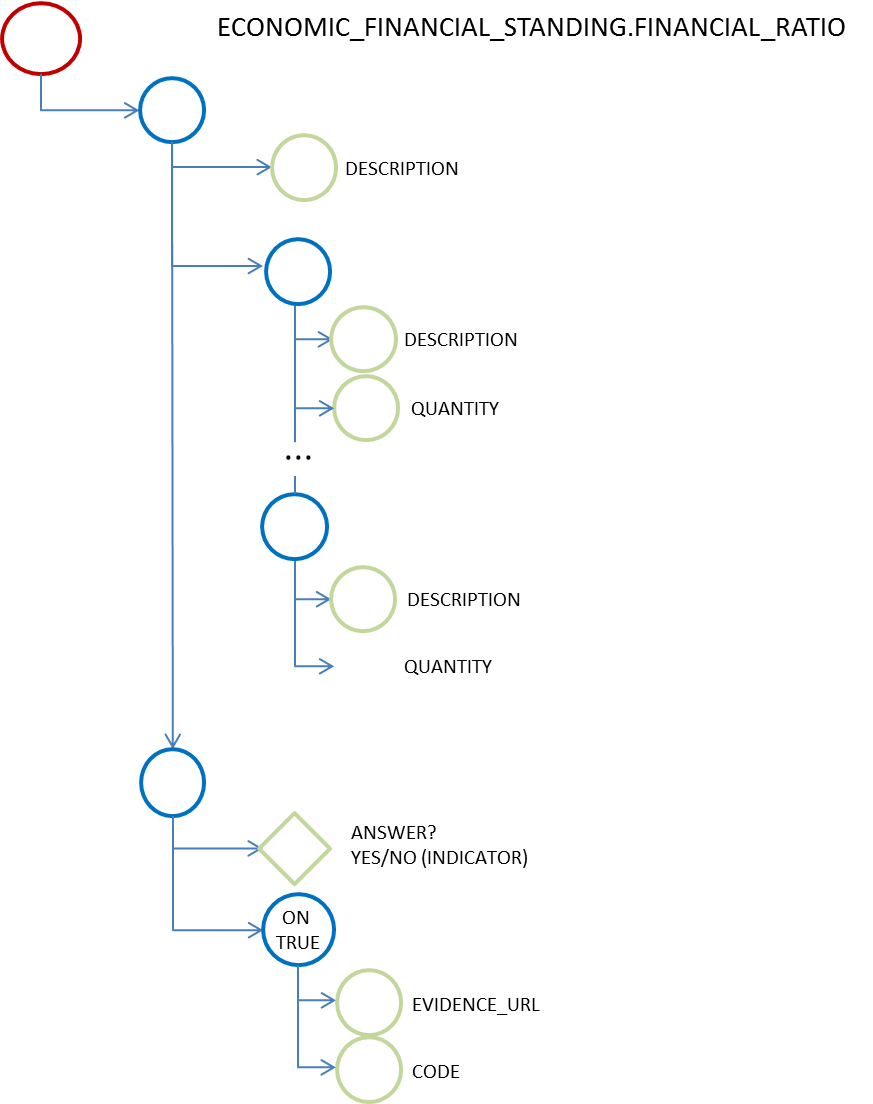
The fragment of XML below shows the implementation of criterion ''Financial Ratio'' in the ESPD Service:
<ccv:Criterion>
<cbc:ID schemeID="CriteriaID" schemeAgencyID="EU-COM-GROW" schemeVersionID="1.0">e4d37adc-08cd-4f4d-a8d8-32b62b0a1f46</cbc:ID>
<cbc:TypeCode listID="CriteriaTypeCode" listAgencyID="EU-COM-GROW" listVersionID="1.0.2">CRITERION.SELECTION.ECONOMIC_FINANCIAL_STANDING.FINANCIAL_RATIO</cbc:TypeCode>
<cbc:Name>Financial ratio</cbc:Name>
<cbc:Description>Concerning the financial ratios specified in the relevant notice, the procurement documents or the ESPD, the economic operator declares that the actual values for the required ratios are as follows:</cbc:Description>
<ccv:LegislationReference>
<ccv-cbc:Title>DIRECTIVE 2014/24/EU OF THE EUROPEAN PARLIAMENT AND OF THE COUNCIL of 26 February 2014 on public procurement and repealing Directive 2004/18/EC</ccv-cbc:Title>
<cbc:Description>On public procurement and repealing Directive 2004/18/EC</cbc:Description>
<ccv-cbc:JurisdictionLevelCode listID="CriterionJurisdictionLevel" listAgencyID="EU-COM-GROW" listVersionID="1.0.2">EU_DIRECTIVE</ccv-cbc:JurisdictionLevelCode>
<ccv-cbc:Article>58(3)</ccv-cbc:Article>
<cbc:URI>http://eur-lex.europa.eu/legal-content/EN/TXT/?uri=celex:32014L0024</cbc:URI>
</ccv:LegislationReference>
<ccv:RequirementGroup>
<cbc:ID schemeAgencyID="EU-COM-GROW" schemeVersionID="1.0">cf00f7bb-c2cf-4565-91bb-221d78d8dd2f</cbc:ID>
<ccv:Requirement responseDataType="DESCRIPTION">
<cbc:ID schemeID="CriterionRelatedIDs" schemeAgencyID="EU-COM-GROW" schemeVersionID="1.0">3a6fefd4-f458-4d43-97fb-0725fce5dce2</cbc:ID>
<cbc:Description>Please provide the requested data below</cbc:Description>
<ccv:Response/>
</ccv:Requirement>
<ccv:RequirementGroup>
<cbc:ID schemeAgencyID="EU-COM-GROW" schemeVersionID="1.0">096686e1-82ca-4de0-8710-d74d90da0f0c</cbc:ID>
<ccv:Requirement responseDataType="DESCRIPTION">
<cbc:ID schemeID="CriterionRelatedIDs" schemeAgencyID="EU-COM-GROW" schemeVersionID="1.0">ab05ff3b-f3e1-4441-9b43-ee9912e29e92</cbc:ID>
<cbc:Description>Description</cbc:Description>
<ccv:Response>
<cbc:Description>TEST_1</cbc:Description>(1)
</ccv:Response>
</ccv:Requirement>
<ccv:Requirement responseDataType="QUANTITY">
<cbc:ID schemeID="CriterionRelatedIDs" schemeAgencyID="EU-COM-GROW" schemeVersionID="1.0">5461b973-7067-457e-93cc-8338da2c3eef</cbc:ID>
<cbc:Description>Ratio</cbc:Description>
<ccv:Response>
<cbc:Quantity>1.0</cbc:Quantity>(2)
</ccv:Response>
</ccv:Requirement>
</ccv:RequirementGroup>
<ccv:RequirementGroup>
<cbc:ID schemeAgencyID="EU-COM-GROW" schemeVersionID="1.0">ce5a61e7-0b0d-4c8b-ac55-2a457743022a</cbc:ID>
<ccv:Requirement responseDataType="DESCRIPTION">
<cbc:ID schemeID="CriterionRelatedIDs" schemeAgencyID="EU-COM-GROW" schemeVersionID="1.0">927def36-1fa3-4018-8b45-7ee2c5b1e0af</cbc:ID>
<cbc:Description>Description</cbc:Description>
<ccv:Response>
<cbc:Description>TEST_2</cbc:Description>(3)
</ccv:Response>
</ccv:Requirement>
<ccv:Requirement responseDataType="QUANTITY">
<cbc:ID schemeID="CriterionRelatedIDs" schemeAgencyID="EU-COM-GROW" schemeVersionID="1.0">295d82b7-5ee6-4977-8aea-bac4acf6ecdf</cbc:ID>
<cbc:Description>Ratio</cbc:Description>
<ccv:Response>
<cbc:Quantity>2.0</cbc:Quantity>(4)
</ccv:Response>
</ccv:Requirement>
</ccv:RequirementGroup>
<ccv:RequirementGroup>
<cbc:ID schemeAgencyID="EU-COM-GROW" schemeVersionID="1.0">3d0734f0-8f9b-4218-a245-c535e3773bc5</cbc:ID>
<ccv:Requirement responseDataType="DESCRIPTION">
<cbc:ID schemeID="CriterionRelatedIDs" schemeAgencyID="EU-COM-GROW" schemeVersionID="1.0">e6ca4034-cfee-499a-9a47-c4f2862ef4d0</cbc:ID>
<cbc:Description>Description</cbc:Description>
<ccv:Response>
<cbc:Description>TEST_3</cbc:Description>
</ccv:Response>
</ccv:Requirement>
<ccv:Requirement responseDataType="QUANTITY">
<cbc:ID schemeID="CriterionRelatedIDs" schemeAgencyID="EU-COM-GROW" schemeVersionID="1.0">2b792afb-87ba-47b5-a80c-aee76a6f2cc8</cbc:ID>
<cbc:Description>Ratio</cbc:Description>(5)
...| 1 | Description for the first ratio |
| 2 | Amount for the first ratio |
| 3 | Description for the second ratio |
| 4 | Amount for the second ratio |
| 5 | etc…more tuples (Ratio, Amount) |
|
Risk indemnity insurance
The structure of this criterion is quite simple as it only asks for an amount and, if available, online information.
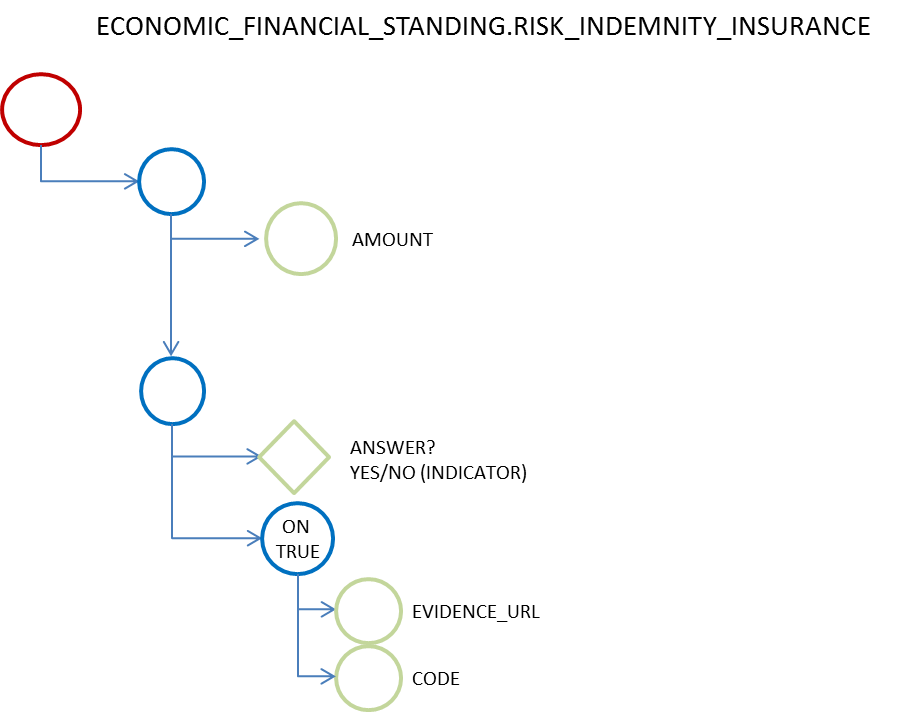
The fragment of XML below shows the implementation of this criterion ''Professional risk indemnity insurance'' in the ESPD Service:
<ccv:Criterion>
<cbc:ID schemeID="CriteriaID" schemeAgencyID="EU-COM-GROW" schemeVersionID="1.0">7604bd40-4462-4086-8763-a50da51a869c</cbc:ID>
<cbc:TypeCode listID="CriteriaTypeCode" listAgencyID="EU-COM-GROW" listVersionID="1.0.2">CRITERION.SELECTION.ECONOMIC_FINANCIAL_STANDING.RISK_INDEMNITY_INSURANCE</cbc:TypeCode>
<cbc:Name>Professional risk indemnity insurance</cbc:Name>
<cbc:Description>The insured amount in its professional risk indemnity insurance is the following:</cbc:Description>
<ccv:LegislationReference>
<ccv-cbc:Title>DIRECTIVE 2014/24/EU OF THE EUROPEAN PARLIAMENT AND OF THE COUNCIL of 26 February 2014 on public procurement and repealing Directive 2004/18/EC</ccv-cbc:Title>
<cbc:Description>On public procurement and repealing Directive 2004/18/EC</cbc:Description>
<ccv-cbc:JurisdictionLevelCode listID="CriterionJurisdictionLevel" listAgencyID="EU-COM-GROW" listVersionID="1.0.2">EU_DIRECTIVE</ccv-cbc:JurisdictionLevelCode>
<ccv-cbc:Article>58(3)</ccv-cbc:Article>
<cbc:URI>http://eur-lex.europa.eu/legal-content/EN/TXT/?uri=celex:32014L0024</cbc:URI>
</ccv:LegislationReference>
<ccv:RequirementGroup>
<cbc:ID schemeAgencyID="EU-COM-GROW" schemeVersionID="1.0">42dc8062-974d-4201-91ba-7f2ea90338fd</cbc:ID>
<ccv:Requirement responseDataType="AMOUNT">
<cbc:ID schemeID="CriterionRelatedIDs" schemeAgencyID="EU-COM-GROW" schemeVersionID="1.0">42db0eaa-d2dd-48cb-83ac-38d73cab9b50</cbc:ID>
<cbc:Description>Amount</cbc:Description>
<ccv:Response>
<cbc:Amount currencyID="EUR">3000000000000000</cbc:Amount>(1)
</ccv:Response>
</ccv:Requirement>
</ccv:RequirementGroup>
<ccv:RequirementGroup>(2)
<cbc:ID schemeAgencyID="EU-COM-GROW" schemeVersionID="1.0">9026e403-3eb6-4705-a9e9-e21a1efc867d</cbc:ID>
<ccv:Requirement responseDataType="INDICATOR">
<cbc:ID schemeID="CriterionRelatedIDs" schemeAgencyID="EU-COM-GROW" schemeVersionID="1.0">9dae5670-cb75-4c97-901b-96ddac5a633a</cbc:ID>
<cbc:Description>Is this information available electronically?</cbc:Description>
<ccv:Response>
<ccv-cbc:Indicator>true</ccv-cbc:Indicator>
</ccv:Response>
</ccv:Requirement>
<ccv:RequirementGroup pi="GROUP_FULFILLED.ON_TRUE">
<cbc:ID schemeAgencyID="EU-COM-GROW" schemeVersionID="1.0">0a166f0a-0c5f-42b0-81e9-0fc9fa598a48</cbc:ID>
<ccv:Requirement responseDataType="EVIDENCE_URL">
<cbc:ID schemeID="CriterionRelatedIDs" schemeAgencyID="EU-COM-GROW" schemeVersionID="1.0">03bb1954-13ae-47d8-8ef8-b7fe0f22d700</cbc:ID>
<cbc:Description>URL</cbc:Description>
<ccv:Response>
<cev:Evidence>
<cev:EvidenceDocumentReference>
<cbc:ID>cf195bb0-48ba-409f-9a90-77e0ef1a8f5c</cbc:ID>
<cac:Attachment>
<cac:ExternalReference>
<cbc:URI>https://www.lds.org/topics/disability/list/physical-disability?lang=eng</cbc:URI>
</cac:ExternalReference>
</cac:Attachment>
</cev:EvidenceDocumentReference>
</cev:Evidence>
</ccv:Response>
</ccv:Requirement>
<ccv:Requirement responseDataType="CODE">
<cbc:ID schemeID="CriterionRelatedIDs" schemeAgencyID="EU-COM-GROW" schemeVersionID="1.0">e2d863a0-60cb-4e58-8c14-4c1595af48b7</cbc:ID>
<cbc:Description>Code</cbc:Description>
<ccv:Response>
<ccv-cbc:Code>Professional risk indemnity insurance code</ccv-cbc:Code>
</ccv:Response>
</ccv:Requirement>
</ccv:RequirementGroup>
</ccv:RequirementGroup>
</ccv:Criterion>| 1 | The EO provides an amount |
| 2 | The EO does not provide an evidence |
|
Economic operator setup
The structure of this criterion is very simple as it only asks for a year: in the criterion description the Contracting Authority is requiring that in case the information concerning turnover (general or specific) is not available for the entire period required, the Economic Operator states the date on which it was set up or started trading. The simplified data structure follows below:

include::4.9.2.7_RESP_EO_Setup_Example.adoc
Other economic of financial requirements
Contracting Authorities MAY include other economic and financial requirements beyond the ones studied above. In this case a simple description is requested, plus additional information if available on line:
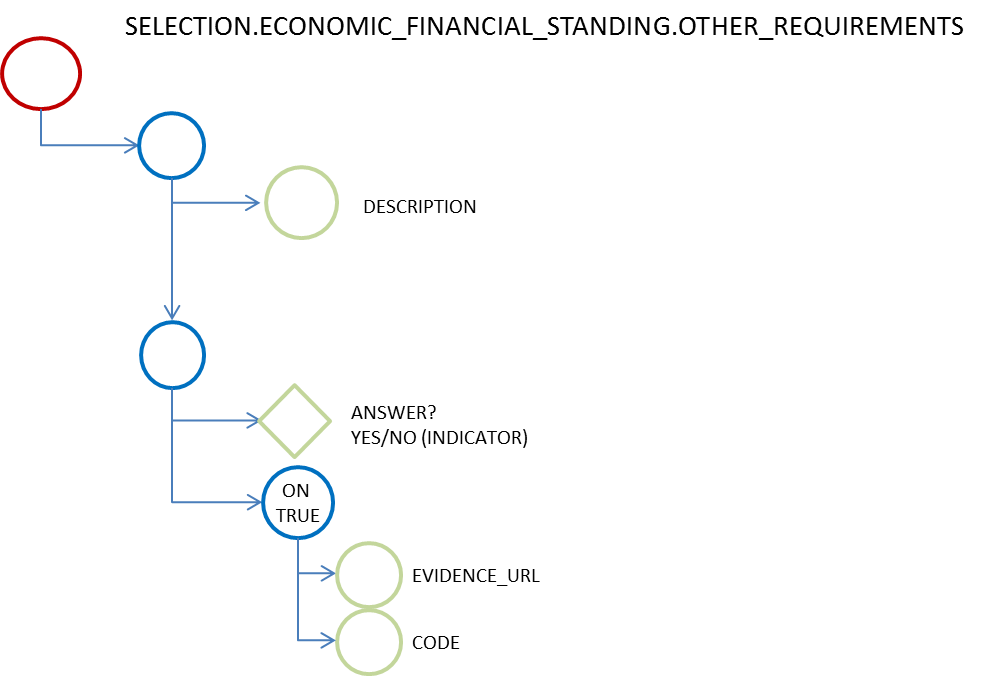
The fragment of XML below shows the implementation of this criterion ''Set up of economic operator'' in the ESPD Service:
<ccv:Criterion>
<cbc:ID schemeID="CriteriaID" schemeAgencyID="EU-COM-GROW" schemeVersionID="1.0">77f481ce-ffb6-483f-8e2b-c78db5e68292</cbc:ID>
<cbc:TypeCode listID="CriteriaTypeCode" listAgencyID="EU-COM-GROW" listVersionID="1.0.2">CRITERION.SELECTION.ECONOMIC_FINANCIAL_STANDING.TURNOVER.SET_UP</cbc:TypeCode>
<cbc:Name>Set up of economic operator</cbc:Name>
<cbc:Description>In case the information concerning turnover (general or specific) is not available for the entire period required, please state the date on which the economic operator was set up or started trading:</cbc:Description>
<ccv:LegislationReference>
<ccv-cbc:Title>DIRECTIVE 2014/24/EU OF THE EUROPEAN PARLIAMENT AND OF THE COUNCIL of 26 February 2014 on public procurement and repealing Directive 2004/18/EC</ccv-cbc:Title>
<cbc:Description>On public procurement and repealing Directive 2004/18/EC</cbc:Description>
<ccv-cbc:JurisdictionLevelCode listID="CriterionJurisdictionLevel" listAgencyID="EU-COM-GROW" listVersionID="1.0.2">EU_DIRECTIVE</ccv-cbc:JurisdictionLevelCode>
<ccv-cbc:Article>58(3)</ccv-cbc:Article>
<cbc:URI>http://eur-lex.europa.eu/legal-content/EN/TXT/?uri=celex:32014L0024</cbc:URI>
</ccv:LegislationReference>
<ccv:RequirementGroup>
<cbc:ID schemeAgencyID="EU-COM-GROW" schemeVersionID="1.0">e9aa7763-c167-4352-8060-1a3d7d3e2662</cbc:ID>
<ccv:Requirement responseDataType="QUANTITY_YEAR">
<cbc:ID schemeID="CriterionRelatedIDs" schemeAgencyID="EU-COM-GROW" schemeVersionID="1.0">a18b2c98-8552-45ca-9751-d4c94c05847a</cbc:ID>
<cbc:Description>Please specify</cbc:Description>
<ccv:Response>
<cbc:Quantity unitCode="YEAR">2014</cbc:Quantity>(1)
</ccv:Response>
</ccv:Requirement>
</ccv:RequirementGroup>
</ccv:Criterion>| 1 | The EO specified the year of its set up |
|
Technical and professional abilities
Many criteria under the group of technical and professional abilities share one simple structure where only a description and additional information available online are requested.
That is mainly the case for the category:
-
CRITERION.SELECTION.TECHNICAL_PROFESSIONAL_ABILITY.TECHNICAL.* grouping the following criteria: ''Supply chain management'', ''Tools, plant or technical equipment'', ''Environmental management measures''; ''Technicians or technical bodies for quality control'', ''For works contracts: technicians or technical bodies to carry out the work'', Technical facilities and measures for ensuring quality'', ''Study and research facilities'' and ''Educational and professional qualifications'';
-
CRITERION.SELECTION.TECHNICAL_PROFESSIONAL_ABILITY.REFERENCES.* also has a specific (iterative) structure where several groups of requirements specific for reference to experience are requested: ''For works contracts: performance of works of the specified type'', ''For supply contracts: performance of deliveries of the specified type'', ''For service contracts: performance of services of the specified type'';
-
CRITERION.SELECTION.TECHNICAL_PROFESSIONAL_ABILITY.TECHNICAL.CHECKS.ALLOWANCE_OF_CHECKS: represents the criterion ''Allowance of checks'' which has however a special data structure of its own (a response ''yes'' or ''no'' is simply expected;
-
CRITERION.SELECTION.TECHNICAL_PROFESSIONAL_ABILITY.MANAGEMENT: ''Number of managerial staff'', and ''Average annual manpower''. And two other sub-elements with different structures:
-
ARTEFACTS: ''For supply contracts: samples, descriptions or photographs without certification of authenticity'' and For supply contracts: samples, descriptions or photographs with certification of authenticity '' '';
-
SUBCONTRACTING_PROPORTION: the criterion ''Subcontracting proportion'' has its own very simple structure in the ESPD Service currently requesting for a text;
-
-
CRITERION.SELECTION.TECHNICAL_PROFESSIONAL_ABILITY.CERTIFICATES:
-
QUALITY_ASSURANCE: ''For supply contracts: certificates by quality control institutes'' and ''Certificates by independent bodies about quality assurance standards'';
-
ENVIRONMENTAL_MANAGEMENT: ''Certificates by independent bodies about environmental management systems or standards''.
-
Technical
The corresponding data-structure diagram would be this one:
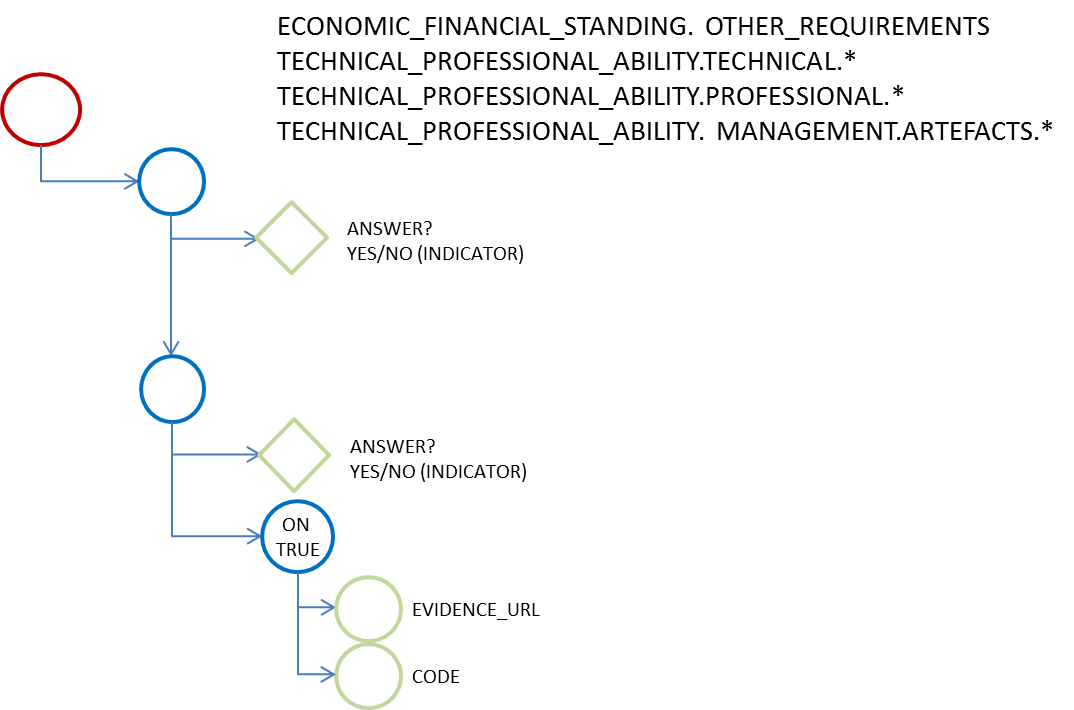
The fragment of XML below shows the implementation of a selection criterion of the group ''Technical and Professional Abilities'':
<ccv:Criterion>
<cbc:ID schemeID="CriteriaID" schemeAgencyID="EU-COM-GROW" schemeVersionID="1.0">dc12a151-7fdf-4733-a8f0-30f667292e66</cbc:ID>
<cbc:TypeCode listID="CriteriaTypeCode" listAgencyID="EU-COM-GROW" listVersionID="1.0.2">CRITERION.SELECTION.TECHNICAL_PROFESSIONAL_ABILITY.TECHNICAL.SUPPLY_CHAIN_MANAGEMENT</cbc:TypeCode>
<cbc:Name>Supply chain management</cbc:Name>
<cbc:Description>It will be able to apply the following supply chain management and tracking systems when performing the contract:</cbc:Description>
<ccv:LegislationReference>
<ccv-cbc:Title>DIRECTIVE 2014/24/EU OF THE EUROPEAN PARLIAMENT AND OF THE COUNCIL of 26 February 2014 on public procurement and repealing Directive 2004/18/EC</ccv-cbc:Title>
<cbc:Description>On public procurement and repealing Directive 2004/18/EC</cbc:Description>
<ccv-cbc:JurisdictionLevelCode listID="CriterionJurisdictionLevel" listAgencyID="EU-COM-GROW" listVersionID="1.0.2">EU_DIRECTIVE</ccv-cbc:JurisdictionLevelCode>
<ccv-cbc:Article>58(4)</ccv-cbc:Article>
<cbc:URI>http://eur-lex.europa.eu/legal-content/EN/TXT/?uri=celex:32014L0024</cbc:URI>
</ccv:LegislationReference>
<ccv:RequirementGroup>
<cbc:ID schemeAgencyID="EU-COM-GROW" schemeVersionID="1.0">488ca189-bcdb-4bf4-80c7-3ad507fd89fb</cbc:ID>
<ccv:Requirement responseDataType="DESCRIPTION">
<cbc:ID schemeID="CriterionRelatedIDs" schemeAgencyID="EU-COM-GROW" schemeVersionID="1.0">51391308-0bf6-423c-95e2-d5a54aa31fb8</cbc:ID>
<cbc:Description>Please describe them</cbc:Description>
<ccv:Response>
<cbc:Description>f the Netherlands, with a mission to explore the potential of nature to improve the quality of life. WUR has a strong experience in developing countries, especially in the domain of land and water management;
University of Copenhagen, Faculty of Science, is one of the European leading universities in the areas of food, health, plants, natural resources and environment, with a recognised expertise in agricultural development in the third countries;
University College Cork (UCC), which hosts one of the well-known colleges in Ireland for agriculture and food industries;
Università degli Studi di Catania, the university in Sicilia, Italy, with a high experience in mediterranean crops and animals;
Universidad Politecnica de Madrid the university in Spain which carries for years a deep involvement in the support to local development i</cbc:Description>(1)
</ccv:Response>
</ccv:Requirement>
</ccv:RequirementGroup>
<ccv:RequirementGroup>
<cbc:ID schemeAgencyID="EU-COM-GROW" schemeVersionID="1.0">9026e403-3eb6-4705-a9e9-e21a1efc867d</cbc:ID>
<ccv:Requirement responseDataType="INDICATOR">
<cbc:ID schemeID="CriterionRelatedIDs" schemeAgencyID="EU-COM-GROW" schemeVersionID="1.0">9dae5670-cb75-4c97-901b-96ddac5a633a</cbc:ID>
<cbc:Description>Is this information available electronically?</cbc:Description>
<ccv:Response>
<ccv-cbc:Indicator>true</ccv-cbc:Indicator>
</ccv:Response>
</ccv:Requirement>
<ccv:RequirementGroup pi="GROUP_FULFILLED.ON_TRUE">
<cbc:ID schemeAgencyID="EU-COM-GROW" schemeVersionID="1.0">0a166f0a-0c5f-42b0-81e9-0fc9fa598a48</cbc:ID>
<ccv:Requirement responseDataType="EVIDENCE_URL">
<cbc:ID schemeID="CriterionRelatedIDs" schemeAgencyID="EU-COM-GROW" schemeVersionID="1.0">03bb1954-13ae-47d8-8ef8-b7fe0f22d700</cbc:ID>
<cbc:Description>URL</cbc:Description>
<ccv:Response>
<cev:Evidence>
<cev:EvidenceDocumentReference>
<cbc:ID>95cbc61a-6b71-43b6-b4cb-8f0746cf7582</cbc:ID>
<cac:Attachment>
<cac:ExternalReference>
<cbc:URI>http://www.agrismundus.eu/Partners/</cbc:URI>
</cac:ExternalReference>
</cac:Attachment>
</cev:EvidenceDocumentReference>
</cev:Evidence>
</ccv:Response>
</ccv:Requirement>
<ccv:Requirement responseDataType="CODE">
<cbc:ID schemeID="CriterionRelatedIDs" schemeAgencyID="EU-COM-GROW" schemeVersionID="1.0">e2d863a0-60cb-4e58-8c14-4c1595af48b7</cbc:ID>
<cbc:Description>Code</cbc:Description>
<ccv:Response>
<ccv-cbc:Code>Supply chain management code</ccv-cbc:Code>
</ccv:Response>
</ccv:Requirement>
</ccv:RequirementGroup>
</ccv:RequirementGroup>
</ccv:Criterion>| 1 | The EO provides the supply chain model it uses |
|
References
References relate to those criteria where the Economic Operator is requested to demonstrate experience in one works execution, service performance or supply delivery. In all three cases the structure is the same and, as for ''turnovers'' or ''ratio'' it also contains an iterative structure that can repeat as many times as requested by the Contracting Authority in the contract documents. In this case the repetitive structure asks for a description, an amount, a date and the related recipients of the work, service or supply.
The corresponding data-structure diagram would be this one:

The fragment of XML below shows the implementation of this criterion in the ESPD Service:
<ccv:Criterion>
<cbc:ID schemeID="CriteriaID" schemeAgencyID="EU-COM-GROW" schemeVersionID="1.0">cdd3bb3e-34a5-43d5-b668-2aab86a73822</cbc:ID>
<cbc:TypeCode listID="CriteriaTypeCode" listAgencyID="EU-COM-GROW" listVersionID="1.0.2">CRITERION.SELECTION.TECHNICAL_PROFESSIONAL_ABILITY.REFERENCES.WORKS_PERFORMANCE</cbc:TypeCode>
<cbc:Name>For works contracts: performance of works of the specified type</cbc:Name>
<cbc:Description>For public works contracts only: During the reference period, the economic operator has performed the following works of the specified type. Contracting authorities may require up to five years and allow experience dating from more than five years.</cbc:Description>
<ccv:LegislationReference>
<ccv-cbc:Title>DIRECTIVE 2014/24/EU OF THE EUROPEAN PARLIAMENT AND OF THE COUNCIL of 26 February 2014 on public procurement and repealing Directive 2004/18/EC</ccv-cbc:Title>
<cbc:Description>On public procurement and repealing Directive 2004/18/EC</cbc:Description>
<ccv-cbc:JurisdictionLevelCode listID="CriterionJurisdictionLevel" listAgencyID="EU-COM-GROW" listVersionID="1.0.2">EU_DIRECTIVE</ccv-cbc:JurisdictionLevelCode>
<ccv-cbc:Article>58(4)</ccv-cbc:Article>
<cbc:URI>http://eur-lex.europa.eu/legal-content/EN/TXT/?uri=celex:32014L0024</cbc:URI>
</ccv:LegislationReference>
<ccv:RequirementGroup>
<cbc:ID schemeAgencyID="EU-COM-GROW" schemeVersionID="1.0">96f00020-0a25-402e-b850-2378e83b5695</cbc:ID>
<ccv:Requirement responseDataType="DESCRIPTION">
<cbc:ID schemeID="CriterionRelatedIDs" schemeAgencyID="EU-COM-GROW" schemeVersionID="1.0">ab05ff3b-f3e1-4441-9b43-ee9912e29e92</cbc:ID>
<cbc:Description>Description</cbc:Description>
<ccv:Response>
<cbc:Description>TEST 1</cbc:Description>(1)
</ccv:Response>
</ccv:Requirement>
<ccv:Requirement responseDataType="AMOUNT">
<cbc:ID schemeID="CriterionRelatedIDs" schemeAgencyID="EU-COM-GROW" schemeVersionID="1.0">42db0eaa-d2dd-48cb-83ac-38d73cab9b50</cbc:ID>
<cbc:Description>Amount</cbc:Description>
<ccv:Response>
<cbc:Amount currencyID="EUR">100000.0</cbc:Amount>(2)
</ccv:Response>
</ccv:Requirement>
<ccv:Requirement responseDataType="DATE">
<cbc:ID schemeID="CriterionRelatedIDs" schemeAgencyID="EU-COM-GROW" schemeVersionID="1.0">42ec8116-31a7-4118-8612-5b04f5c8bde7</cbc:ID>
<cbc:Description>Date</cbc:Description>
<ccv:Response>
<cbc:Date>2016-03-16</cbc:Date>(3)
</ccv:Response>
</ccv:Requirement>
<ccv:Requirement responseDataType="DESCRIPTION">
<cbc:ID schemeID="CriterionRelatedIDs" schemeAgencyID="EU-COM-GROW" schemeVersionID="1.0">a92536ab-6783-40bb-a037-5d31f421fd85</cbc:ID>
<cbc:Description>Recipients</cbc:Description>
<ccv:Response>
<cbc:Description>TEST 1</cbc:Description>(4)
</ccv:Response>
</ccv:Requirement>
</ccv:RequirementGroup>
<ccv:RequirementGroup>
<cbc:ID schemeAgencyID="EU-COM-GROW" schemeVersionID="1.0">c48572f9-47bf-423a-9885-2c78ae9ca718</cbc:ID>
<ccv:Requirement responseDataType="DESCRIPTION">
<cbc:ID schemeID="CriterionRelatedIDs" schemeAgencyID="EU-COM-GROW" schemeVersionID="1.0">927def36-1fa3-4018-8b45-7ee2c5b1e0af</cbc:ID>
<cbc:Description>Description</cbc:Description>
<ccv:Response>
<cbc:Description>TEST 2</cbc:Description>(5)
</ccv:Response>
</ccv:Requirement>
<ccv:Requirement responseDataType="AMOUNT">
<cbc:ID schemeID="CriterionRelatedIDs" schemeAgencyID="EU-COM-GROW" schemeVersionID="1.0">4acd0a02-c267-4d05-b456-c0565c2ffd46</cbc:ID>
<cbc:Description>Amount</cbc:Description>
<ccv:Response>
<cbc:Amount currencyID="EUR">100000.0</cbc:Amount>
</ccv:Response>
</ccv:Requirement>
<ccv:Requirement responseDataType="DATE">
<cbc:ID schemeID="CriterionRelatedIDs" schemeAgencyID="EU-COM-GROW" schemeVersionID="1.0">8d0e5e16-85ed-4730-a784-d4db8f439c0c</cbc:ID>
<cbc:Description>Date</cbc:Description>
<ccv:Response>
<cbc:Date>2016-01-06</cbc:Date>
</ccv:Response>
</ccv:Requirement>
<ccv:Requirement responseDataType="DESCRIPTION">
<cbc:ID schemeID="CriterionRelatedIDs" schemeAgencyID="EU-COM-GROW" schemeVersionID="1.0">c8babafa-b6fa-4e14-8749-d913d8f1d33b</cbc:ID>
<cbc:Description>Recipients</cbc:Description>
<ccv:Response>
<cbc:Description>TEST 2</cbc:Description>
</ccv:Response>
</ccv:Requirement>
</ccv:RequirementGroup>
<ccv:RequirementGroup>
<cbc:ID schemeAgencyID="EU-COM-GROW" schemeVersionID="1.0">2c7a3581-2954-4142-8c1b-5c52d7c7e9b7</cbc:ID>
<ccv:Requirement responseDataType="DESCRIPTION">
<cbc:ID schemeID="CriterionRelatedIDs" schemeAgencyID="EU-COM-GROW" schemeVersionID="1.0">e6ca4034-cfee-499a-9a47-c4f2862ef4d0</cbc:ID>
<cbc:Description>Description</cbc:Description>
<ccv:Response>
<cbc:Description>TEST 3</cbc:Description>
</ccv:Response>
</ccv:Requirement>
<ccv:Requirement responseDataType="AMOUNT">
<cbc:ID schemeID="CriterionRelatedIDs" schemeAgencyID="EU-COM-GROW" schemeVersionID="1.0">28fb4b41-5178-4b79-ba24-d9a62fa4a658</cbc:ID>
<cbc:Description>Amount</cbc:Description>
<ccv:Response>
<cbc:Amount currencyID="EUR">100000.0</cbc:Amount>
</ccv:Response>
</ccv:Requirement>
<ccv:Requirement responseDataType="DATE">
<cbc:ID schemeID="CriterionRelatedIDs" schemeAgencyID="EU-COM-GROW" schemeVersionID="1.0">c953e635-580b-4d7c-a30c-2edbde3b8fdf</cbc:ID>
<cbc:Description>Date</cbc:Description>
<ccv:Response>
<cbc:Date>2016-01-19</cbc:Date>
</ccv:Response>
</ccv:Requirement>
<ccv:Requirement responseDataType="DESCRIPTION">
<cbc:ID schemeID="CriterionRelatedIDs" schemeAgencyID="EU-COM-GROW" schemeVersionID="1.0">5157e1ff-d272-4382-98a9-6953f5a15300</cbc:ID>
<cbc:Description>Recipients</cbc:Description>
<ccv:Response>
<cbc:Description>TEST 3</cbc:Description>
</ccv:Response>
</ccv:Requirement>
</ccv:RequirementGroup>
<ccv:RequirementGroup>
<cbc:ID schemeAgencyID="EU-COM-GROW" schemeVersionID="1.0">d67a6126-dd6d-4ed2-bda7-214a19e13a63</cbc:ID>
<ccv:Requirement responseDataType="DESCRIPTION">
<cbc:ID schemeID="CriterionRelatedIDs" schemeAgencyID="EU-COM-GROW" schemeVersionID="1.0">b1640c24-b405-443e-bf5e-d7771f66aab6</cbc:ID>
<cbc:Description>Description</cbc:Description>
<ccv:Response>
<cbc:Description>TEST 4</cbc:Description>
</ccv:Response>
</ccv:Requirement>
<ccv:Requirement responseDataType="AMOUNT">
<cbc:ID schemeID="CriterionRelatedIDs" schemeAgencyID="EU-COM-GROW" schemeVersionID="1.0">9f278e42-aa1d-4b2e-97cd-832248aa5393</cbc:ID>
<cbc:Description>Amount</cbc:Description>
<ccv:Response>
<cbc:Amount currencyID="EUR">100000.0</cbc:Amount>
</ccv:Response>
</ccv:Requirement>
<ccv:Requirement responseDataType="DATE">
<cbc:ID schemeID="CriterionRelatedIDs" schemeAgencyID="EU-COM-GROW" schemeVersionID="1.0">9b263b45-fc63-4b01-a3dc-cb9c95dda449</cbc:ID>
<cbc:Description>Date</cbc:Description>
<ccv:Response>
<cbc:Date>2015-08-21</cbc:Date>
</ccv:Response>
</ccv:Requirement>
<ccv:Requirement responseDataType="DESCRIPTION">
<cbc:ID schemeID="CriterionRelatedIDs" schemeAgencyID="EU-COM-GROW" schemeVersionID="1.0">a84ea948-cf03-47b5-b4cf-a35f49910d10</cbc:ID>
<cbc:Description>Recipients</cbc:Description>
<ccv:Response>
<cbc:Description>TEST 4</cbc:Description>
</ccv:Response>
</ccv:Requirement>
</ccv:RequirementGroup>
<ccv:RequirementGroup>
<cbc:ID schemeAgencyID="EU-COM-GROW" schemeVersionID="1.0">159fc086-cf34-48a4-a41b-afed62661383</cbc:ID>
<ccv:Requirement responseDataType="DESCRIPTION">
<cbc:ID schemeID="CriterionRelatedIDs" schemeAgencyID="EU-COM-GROW" schemeVersionID="1.0">587129bc-a5e1-43be-94ac-6e5366d30c67</cbc:ID>
<cbc:Description>Description</cbc:Description>
<ccv:Response>
<cbc:Description>TEST 5</cbc:Description>
</ccv:Response>
</ccv:Requirement>
<ccv:Requirement responseDataType="AMOUNT">
<cbc:ID schemeID="CriterionRelatedIDs" schemeAgencyID="EU-COM-GROW" schemeVersionID="1.0">cc1a0b1e-dbfd-4313-a4fb-2e543b05549b</cbc:ID>
<cbc:Description>Amount</cbc:Description>
<ccv:Response>
<cbc:Amount currencyID="EUR">100000.0</cbc:Amount>
</ccv:Response>
</ccv:Requirement>
<ccv:Requirement responseDataType="DATE">
<cbc:ID schemeID="CriterionRelatedIDs" schemeAgencyID="EU-COM-GROW" schemeVersionID="1.0">056cba1d-986b-4164-92b6-26a1cbdf0690</cbc:ID>
<cbc:Description>Date</cbc:Description>
<ccv:Response>
<cbc:Date>2015-10-27</cbc:Date>
</ccv:Response>
</ccv:Requirement>
<ccv:Requirement responseDataType="DESCRIPTION">
<cbc:ID schemeID="CriterionRelatedIDs" schemeAgencyID="EU-COM-GROW" schemeVersionID="1.0">38a4802f-0b93-4e78-ad4e-2a057e1aa578</cbc:ID>
<cbc:Description>Recipients</cbc:Description>
<ccv:Response>
<cbc:Description>TEST 5</cbc:Description>
</ccv:Response>
</ccv:Requirement>
</ccv:RequirementGroup>
<ccv:RequirementGroup>
<cbc:ID schemeAgencyID="EU-COM-GROW" schemeVersionID="1.0">9026e403-3eb6-4705-a9e9-e21a1efc867d</cbc:ID>
<ccv:Requirement responseDataType="INDICATOR">
<cbc:ID schemeID="CriterionRelatedIDs" schemeAgencyID="EU-COM-GROW" schemeVersionID="1.0">9dae5670-cb75-4c97-901b-96ddac5a633a</cbc:ID>
<cbc:Description>Is this information available electronically?</cbc:Description>
<ccv:Response>
<ccv-cbc:Indicator>true</ccv-cbc:Indicator>
</ccv:Response>
</ccv:Requirement>
<ccv:RequirementGroup pi="GROUP_FULFILLED.ON_TRUE">
<cbc:ID schemeAgencyID="EU-COM-GROW" schemeVersionID="1.0">0a166f0a-0c5f-42b0-81e9-0fc9fa598a48</cbc:ID>
<ccv:Requirement responseDataType="EVIDENCE_URL">
<cbc:ID schemeID="CriterionRelatedIDs" schemeAgencyID="EU-COM-GROW" schemeVersionID="1.0">03bb1954-13ae-47d8-8ef8-b7fe0f22d700</cbc:ID>
<cbc:Description>URL</cbc:Description>
<ccv:Response>
<cev:Evidence>
<cev:EvidenceDocumentReference>
<cbc:ID>f4ea3924-31be-4dd1-9e46-8a855ed6b870</cbc:ID>
<cac:Attachment>
<cac:ExternalReference>
<cbc:URI>http://www.agrismundus.eu/Partners/</cbc:URI>
</cac:ExternalReference>
</cac:Attachment>
</cev:EvidenceDocumentReference>
</cev:Evidence>
</ccv:Response>
</ccv:Requirement>
<ccv:Requirement responseDataType="CODE">
<cbc:ID schemeID="CriterionRelatedIDs" schemeAgencyID="EU-COM-GROW" schemeVersionID="1.0">e2d863a0-60cb-4e58-8c14-4c1595af48b7</cbc:ID>
<cbc:Description>Code</cbc:Description>
<ccv:Response>
<ccv-cbc:Code>For works contracts: performance of works of the specified type code</ccv-cbc:Code>
</ccv:Response>
</ccv:Requirement>
</ccv:RequirementGroup>
</ccv:RequirementGroup>
</ccv:Criterion>| 1 | The EO provides a description for the first reference |
| 2 | The EO provides the amount of that project |
| 3 | The EO provides the date when the project was executed |
| 4 | The EO provides the name of the client who contracted this project |
| 5 | etc… (the EO provides as many responses as requested in the ESPDRequest XML document) |
|
Allowance of checks
The corresponding data-structure diagram would be this one:

The fragment of XML below shows the implementation of this criterion in the ESPD Service:
<ccv:Criterion>
<cbc:ID schemeID="CriteriaID" schemeAgencyID="EU-COM-GROW" schemeVersionID="1.0">c8809aa1-29b6-4f27-ae2f-27e612e394db</cbc:ID>
<cbc:TypeCode listID="CriteriaTypeCode" listAgencyID="EU-COM-GROW" listVersionID="1.0.2">CRITERION.SELECTION.TECHNICAL_PROFESSIONAL_ABILITY.TECHNICAL.CHECKS.ALLOWANCE_OF_CHECKS</cbc:TypeCode>
<cbc:Name>Allowance of checks</cbc:Name>
<cbc:Description>For complex products or services to be supplied or, exceptionally, for products or services which are required for a special purpose: The economic operator will allow checks to be conducted on the production capacities or the technical capacity of the economic operator and, where necessary, on the means of study and research which are available to it and on the quality control measures? The check is to be performed by the contracting authority or, in case the latter consents to this, on its behalf by a competent official body of the country in which the supplier or service provider is established.</cbc:Description>
<ccv:LegislationReference>
<ccv-cbc:Title>DIRECTIVE 2014/24/EU OF THE EUROPEAN PARLIAMENT AND OF THE COUNCIL of 26 February 2014 on public procurement and repealing Directive 2004/18/EC</ccv-cbc:Title>
<cbc:Description>On public procurement and repealing Directive 2004/18/EC</cbc:Description>
<ccv-cbc:JurisdictionLevelCode listID="CriterionJurisdictionLevel" listAgencyID="EU-COM-GROW" listVersionID="1.0.2">EU_DIRECTIVE</ccv-cbc:JurisdictionLevelCode>
<ccv-cbc:Article>58(4)</ccv-cbc:Article>
<cbc:URI>http://eur-lex.europa.eu/legal-content/EN/TXT/?uri=celex:32014L0024</cbc:URI>
</ccv:LegislationReference>
<ccv:RequirementGroup>
<cbc:ID schemeAgencyID="EU-COM-GROW" schemeVersionID="1.0">d7721546-9106-43a7-8d31-2fe08a862b00</cbc:ID>
<ccv:Requirement responseDataType="INDICATOR">
<cbc:ID schemeID="CriterionRelatedIDs" schemeAgencyID="EU-COM-GROW" schemeVersionID="1.0">23a27c0e-c4f7-42cd-b0fd-a7cedfbf77a7</cbc:ID>
<cbc:Description>Do you allow checks?</cbc:Description>
<ccv:Response>
<ccv-cbc:Indicator>true</ccv-cbc:Indicator>(1)
</ccv:Response>
</ccv:Requirement>
</ccv:RequirementGroup>
</ccv:Criterion>| 1 | The EO allows for checks |
|
Management
This general category groups the two criteria ''Number of managerial staff'', and ''Average annual manpower''. The two criteria have a repetitive structure (like in the case of ''references'') where groups of couples (Year, Number) are requested (number of staff and the year to which that year refers to). The quantity of groups is usually specified in the contract documents. The figure below is a fragment of a long table plenty of details. The corresponding data-structure diagram would be this one:
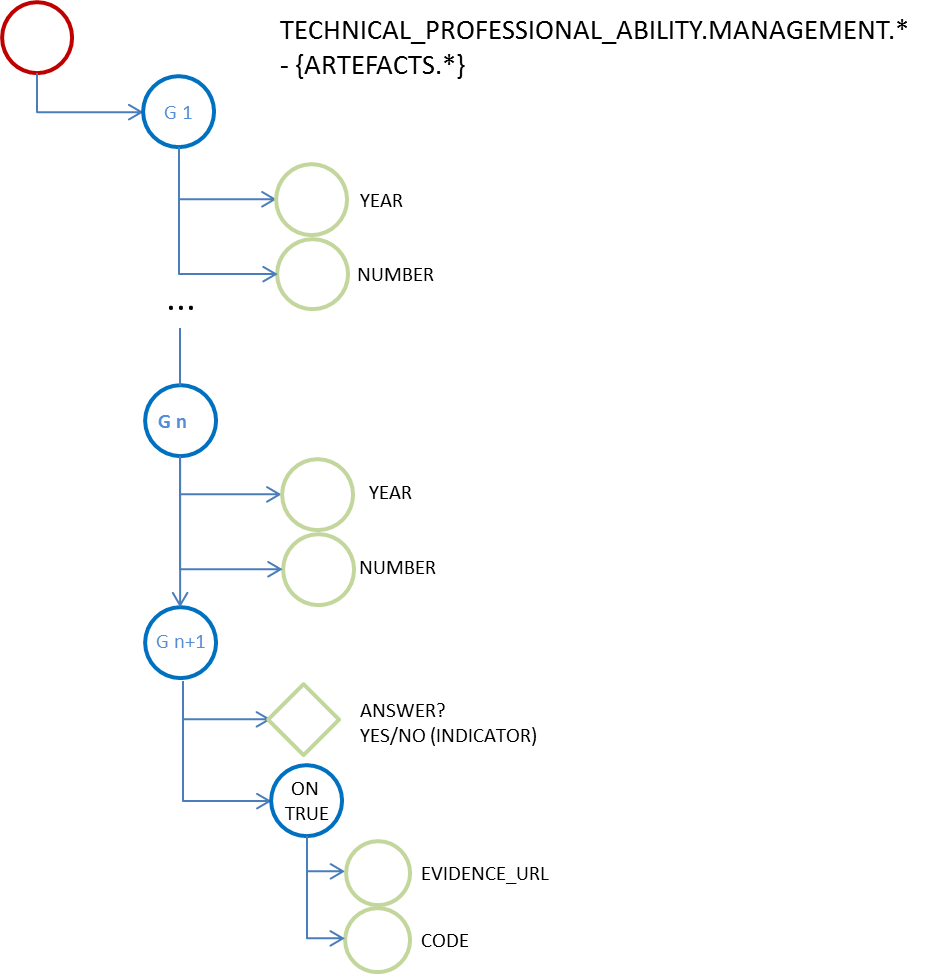
The fragment of XML below shows the implementation of this criterion in the ESPD Service:
<ccv:Criterion>
<cbc:ID schemeID="CriteriaID" schemeAgencyID="EU-COM-GROW" schemeVersionID="1.0">6346959b-e097-4ea1-89cd-d1b4c131ea4d</cbc:ID>
<cbc:TypeCode listID="CriteriaTypeCode" listAgencyID="EU-COM-GROW" listVersionID="1.0.2">CRITERION.SELECTION.TECHNICAL_PROFESSIONAL_ABILITY.MANAGEMENT.MANAGERIAL_STAFF</cbc:TypeCode>
<cbc:Name>Number of managerial staff</cbc:Name>
<cbc:Description>The economic operator’s number of managerial staff for the last three years were as follows:</cbc:Description>
<ccv:LegislationReference>
<ccv-cbc:Title>DIRECTIVE 2014/24/EU OF THE EUROPEAN PARLIAMENT AND OF THE COUNCIL of 26 February 2014 on public procurement and repealing Directive 2004/18/EC</ccv-cbc:Title>
<cbc:Description>On public procurement and repealing Directive 2004/18/EC</cbc:Description>
<ccv-cbc:JurisdictionLevelCode listID="CriterionJurisdictionLevel" listAgencyID="EU-COM-GROW" listVersionID="1.0.2">EU_DIRECTIVE</ccv-cbc:JurisdictionLevelCode>
<ccv-cbc:Article>58(4)</ccv-cbc:Article>
<cbc:URI>http://eur-lex.europa.eu/legal-content/EN/TXT/?uri=celex:32014L0024</cbc:URI>
</ccv:LegislationReference>
<ccv:RequirementGroup>
<cbc:ID schemeAgencyID="EU-COM-GROW" schemeVersionID="1.0">96defecc-7d32-4957-82e9-aad5f3c5b736</cbc:ID>
<ccv:Requirement responseDataType="QUANTITY_YEAR">
<cbc:ID schemeID="CriterionRelatedIDs" schemeAgencyID="EU-COM-GROW" schemeVersionID="1.0">5aacceb3-280e-42f1-b2da-3d8ac7877fe9</cbc:ID>
<cbc:Description>Year</cbc:Description>
<ccv:Response>
<cbc:Quantity unitCode="YEAR">2014</cbc:Quantity>(1)
</ccv:Response>
</ccv:Requirement>
<ccv:Requirement responseDataType="QUANTITY_INTEGER">
<cbc:ID schemeID="CriterionRelatedIDs" schemeAgencyID="EU-COM-GROW" schemeVersionID="1.0">42037f41-53af-44df-b6b8-2395cee98087</cbc:ID>
<cbc:Description>Number</cbc:Description>
<ccv:Response>
<cbc:Quantity unitCode="NUMBER">123</cbc:Quantity>(2)
</ccv:Response>
</ccv:Requirement>
</ccv:RequirementGroup>
<ccv:RequirementGroup>
<cbc:ID schemeAgencyID="EU-COM-GROW" schemeVersionID="1.0">dac727d8-2cd2-43e0-8561-6f17e25870a4</cbc:ID>
<ccv:Requirement responseDataType="QUANTITY_YEAR">
<cbc:ID schemeID="CriterionRelatedIDs" schemeAgencyID="EU-COM-GROW" schemeVersionID="1.0">49a57870-7fb8-451f-a7af-fa0e7f8b97e7</cbc:ID>
<cbc:Description>Year</cbc:Description>
<ccv:Response>
<cbc:Quantity unitCode="YEAR">2015</cbc:Quantity>(3)
</ccv:Response>
</ccv:Requirement>
<ccv:Requirement responseDataType="QUANTITY_INTEGER">
<cbc:ID schemeID="CriterionRelatedIDs" schemeAgencyID="EU-COM-GROW" schemeVersionID="1.0">0bb2d3bf-160f-4904-a4e8-ee672bd5cb30</cbc:ID>
<cbc:Description>Number</cbc:Description>
<ccv:Response>
<cbc:Quantity unitCode="NUMBER">456</cbc:Quantity>
</ccv:Response>
</ccv:Requirement>
</ccv:RequirementGroup>
<ccv:RequirementGroup>
<cbc:ID schemeAgencyID="EU-COM-GROW" schemeVersionID="1.0">b799d324-358c-48b0-bd5e-6d205969b4a5</cbc:ID>
<ccv:Requirement responseDataType="QUANTITY_YEAR">
<cbc:ID schemeID="CriterionRelatedIDs" schemeAgencyID="EU-COM-GROW" schemeVersionID="1.0">9d0cf1cb-27bc-4747-8579-47dce4d8d490</cbc:ID>
<cbc:Description>Year</cbc:Description>
<ccv:Response>
<cbc:Quantity unitCode="YEAR">2013</cbc:Quantity>
</ccv:Response>
</ccv:Requirement>
<ccv:Requirement responseDataType="QUANTITY_INTEGER">
<cbc:ID schemeID="CriterionRelatedIDs" schemeAgencyID="EU-COM-GROW" schemeVersionID="1.0">668dbc0d-2a3a-49b9-b8e1-8ebbeccd712a</cbc:ID>
<cbc:Description>Number</cbc:Description>
<ccv:Response>
<cbc:Quantity unitCode="NUMBER">789</cbc:Quantity>
</ccv:Response>
</ccv:Requirement>
</ccv:RequirementGroup>
<ccv:RequirementGroup>
<cbc:ID schemeAgencyID="EU-COM-GROW" schemeVersionID="1.0">9026e403-3eb6-4705-a9e9-e21a1efc867d</cbc:ID>
<ccv:Requirement responseDataType="INDICATOR">
<cbc:ID schemeID="CriterionRelatedIDs" schemeAgencyID="EU-COM-GROW" schemeVersionID="1.0">9dae5670-cb75-4c97-901b-96ddac5a633a</cbc:ID>
<cbc:Description>Is this information available electronically?</cbc:Description>
<ccv:Response>
<ccv-cbc:Indicator>true</ccv-cbc:Indicator>
</ccv:Response>
</ccv:Requirement>
<ccv:RequirementGroup pi="GROUP_FULFILLED.ON_TRUE">
<cbc:ID schemeAgencyID="EU-COM-GROW" schemeVersionID="1.0">0a166f0a-0c5f-42b0-81e9-0fc9fa598a48</cbc:ID>
<ccv:Requirement responseDataType="EVIDENCE_URL">
<cbc:ID schemeID="CriterionRelatedIDs" schemeAgencyID="EU-COM-GROW" schemeVersionID="1.0">03bb1954-13ae-47d8-8ef8-b7fe0f22d700</cbc:ID>
<cbc:Description>URL</cbc:Description>
<ccv:Response>
<cev:Evidence>
<cev:EvidenceDocumentReference>
<cbc:ID>c3940a02-4181-4102-b55b-5cfd583c1dcf</cbc:ID>
<cac:Attachment>
<cac:ExternalReference>
<cbc:URI>http://www.agrismundus.eu/</cbc:URI>
</cac:ExternalReference>
</cac:Attachment>
</cev:EvidenceDocumentReference>
</cev:Evidence>
</ccv:Response>
</ccv:Requirement>
<ccv:Requirement responseDataType="CODE">
<cbc:ID schemeID="CriterionRelatedIDs" schemeAgencyID="EU-COM-GROW" schemeVersionID="1.0">e2d863a0-60cb-4e58-8c14-4c1595af48b7</cbc:ID>
<cbc:Description>Code</cbc:Description>
<ccv:Response>
<ccv-cbc:Code> Number of managerial staff code</ccv-cbc:Code>
</ccv:Response>
</ccv:Requirement>
</ccv:RequirementGroup>
</ccv:RequirementGroup>
</ccv:Criterion>| 1 | The EO provides data for the year 2015 |
| 2 | The EO provides the staff in 2015 |
| 3 | Etc. (the EO provides data for the amount of years required in the procurement documents) |
|
Management Artefacts
AUTHENTICATED_ARTEFACTS, NO_AUTHENTICATED_ARTEFACTS
This category refers to a group of two criteria that share the same structure:
-
CRITERION.SELECTION.TECHNICAL_PROFESSIONAL_ABILITY.MANAGEMENT.ARTEFACTS.: ''For supply contracts: samples, descriptions or photographs *with certification of authenticity'', and ''For supply contracts: samples, descriptions or photographs without certification of authenticity''
The corresponding data-structure diagram would be this one:

The fragment of XML below shows the implementation of this criterion in the ESPD Service:
<ccv:Criterion>
<cbc:ID schemeID="CriteriaID" schemeAgencyID="EU-COM-GROW" schemeVersionID="1.0">bdf0601d-2480-4250-b870-658d0ee95be6</cbc:ID>
<cbc:TypeCode listID="CriteriaTypeCode" listAgencyID="EU-COM-GROW" listVersionID="1.0.2">CRITERION.SELECTION.TECHNICAL_PROFESSIONAL_ABILITY.MANAGEMENT.ARTEFACTS.NO_AUTHENTICATED_ARTEFACTS</cbc:TypeCode>
<cbc:Name>For supply contracts: samples, descriptions or photographs without certification of authenticity</cbc:Name>
<cbc:Description>For public supply contracts: The economic operator will supply the required samples, descriptions or photographs of the products to be supplied, which do not need to be accompanied by certifications of authenticity.</cbc:Description>
<ccv:LegislationReference>
<ccv-cbc:Title>DIRECTIVE 2014/24/EU OF THE EUROPEAN PARLIAMENT AND OF THE COUNCIL of 26 February 2014 on public procurement and repealing Directive 2004/18/EC</ccv-cbc:Title>
<cbc:Description>On public procurement and repealing Directive 2004/18/EC</cbc:Description>
<ccv-cbc:JurisdictionLevelCode listID="CriterionJurisdictionLevel" listAgencyID="EU-COM-GROW" listVersionID="1.0.2">EU_DIRECTIVE</ccv-cbc:JurisdictionLevelCode>
<ccv-cbc:Article>58(4)</ccv-cbc:Article>
<cbc:URI>http://eur-lex.europa.eu/legal-content/EN/TXT/?uri=celex:32014L0024</cbc:URI>
</ccv:LegislationReference>
<ccv:RequirementGroup>
<cbc:ID schemeAgencyID="EU-COM-GROW" schemeVersionID="1.0">cb73544d-e8bb-4cc6-819b-b8e04f1e240e</cbc:ID>
<ccv:Requirement responseDataType="INDICATOR">
<cbc:ID schemeID="CriterionRelatedIDs" schemeAgencyID="EU-COM-GROW" schemeVersionID="1.0">15335c12-ad77-4728-b5ad-3c06a60d65a4</cbc:ID>
<cbc:Description>Your answer?</cbc:Description>
<ccv:Response>
<ccv-cbc:Indicator>true</ccv-cbc:Indicator>(1)
</ccv:Response>
</ccv:Requirement>
</ccv:RequirementGroup>
<ccv:RequirementGroup>
<cbc:ID schemeAgencyID="EU-COM-GROW" schemeVersionID="1.0">9026e403-3eb6-4705-a9e9-e21a1efc867d</cbc:ID>
<ccv:Requirement responseDataType="INDICATOR">
<cbc:ID schemeID="CriterionRelatedIDs" schemeAgencyID="EU-COM-GROW" schemeVersionID="1.0">9dae5670-cb75-4c97-901b-96ddac5a633a</cbc:ID>
<cbc:Description>Is this information available electronically?</cbc:Description>
<ccv:Response>
<ccv-cbc:Indicator>true</ccv-cbc:Indicator>
</ccv:Response>
</ccv:Requirement>
<ccv:RequirementGroup pi="GROUP_FULFILLED.ON_TRUE">
<cbc:ID schemeAgencyID="EU-COM-GROW" schemeVersionID="1.0">0a166f0a-0c5f-42b0-81e9-0fc9fa598a48</cbc:ID>
<ccv:Requirement responseDataType="EVIDENCE_URL">
<cbc:ID schemeID="CriterionRelatedIDs" schemeAgencyID="EU-COM-GROW" schemeVersionID="1.0">03bb1954-13ae-47d8-8ef8-b7fe0f22d700</cbc:ID>
<cbc:Description>URL</cbc:Description>
<ccv:Response>
<cev:Evidence>
<cev:EvidenceDocumentReference>
<cbc:ID>9c91d7ac-d6f6-4bb8-a143-166963f95bda</cbc:ID>
<cac:Attachment>
<cac:ExternalReference>
<cbc:URI>http://www.agrismundus.eu/</cbc:URI>
</cac:ExternalReference>
</cac:Attachment>
</cev:EvidenceDocumentReference>
</cev:Evidence>
</ccv:Response>
</ccv:Requirement>
<ccv:Requirement responseDataType="CODE">
<cbc:ID schemeID="CriterionRelatedIDs" schemeAgencyID="EU-COM-GROW" schemeVersionID="1.0">e2d863a0-60cb-4e58-8c14-4c1595af48b7</cbc:ID>
<cbc:Description>Code</cbc:Description>
<ccv:Response>
<ccv-cbc:Code>For supply contracts: samples, descriptions or photographs without certification of authenticity code</ccv-cbc:Code>
</ccv:Response>
</ccv:Requirement>
</ccv:RequirementGroup>
</ccv:RequirementGroup>
</ccv:Criterion>| 1 | The EO states that it will provide the artefacts required in the procurement documents. |
|
The EO only has to answer ''yes'' or ''no'' and provide available online evidences. In this case the EO does not provide any evidence but states that it will produce any requested artefact. |
Certificates
The criteria under the category ''Certificates'' use two groups of data structure. However the categorisation of the certificates (in the Criteria Taxonomy) has been split in three different certificate categories:
-
CRITERION.SELECTION.TECHNICAL_PROFESSIONAL_ABILITY.CERTIFICATES.QUALITY_ASSURANCE.QA_INSTITUTES: ''For supply contracts: certificates by quality control institutes''.
-
CRITERION.SELECTION.TECHNICAL_PROFESSIONAL_ABILITY.CERTIFICATES.QUALITY_ASSURANCE.QA_INDEPENDENT: ''For certificates by independent bodies about quality assurance standards''.
-
CRITERION.SELECTION.TECHNICAL_PROFESSIONAL_ABILITY.CERTIFICATES.ENVIRONMENTAL_MANAGEMENT.*: ''Certificates by independent bodies about environmental management systems or standards''.
Quality Assurance Institutes
This category refers to a quality control certificate drawn up by official quality control institutes or agencies of recognised competence:
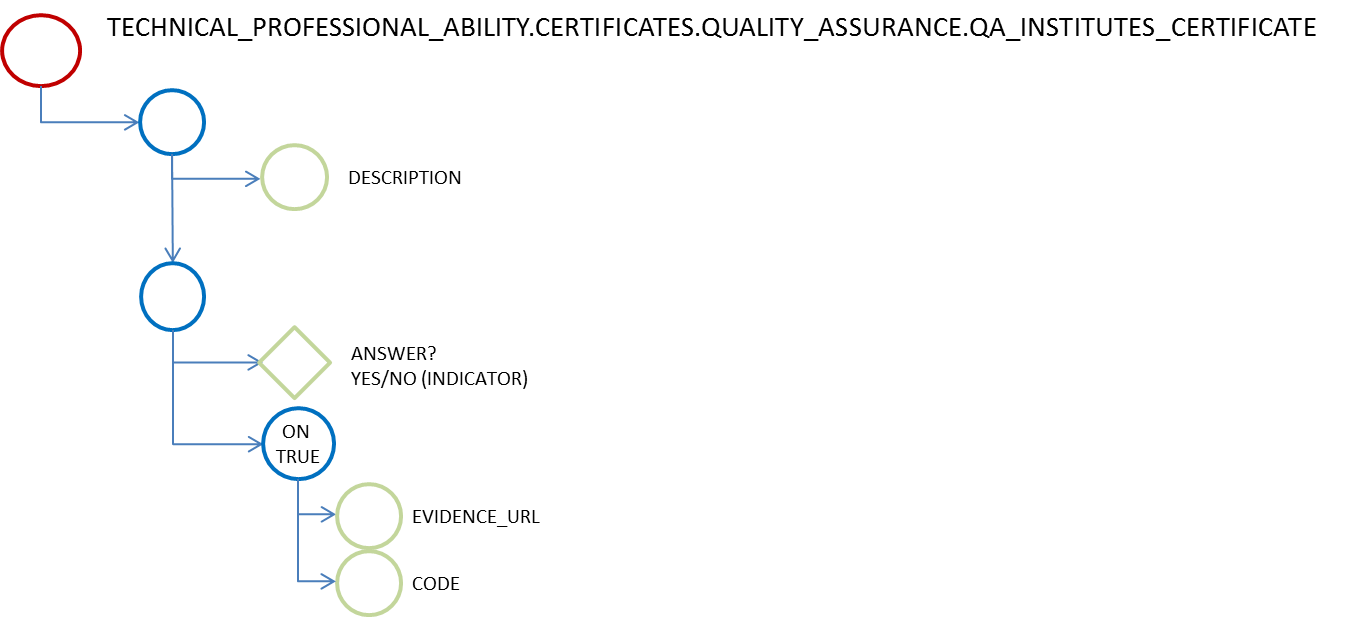
The fragment of XML below shows the implementation of this criterion in the ESPD Service:
<ccv:Criterion>
<cbc:ID schemeID="CriteriaID" schemeAgencyID="EU-COM-GROW" schemeVersionID="1.0">a7669d7d-9297-43e1-9d10-691a1660187c</cbc:ID>
<cbc:TypeCode listID="CriteriaTypeCode" listAgencyID="EU-COM-GROW" listVersionID="1.0.2">CRITERION.SELECTION.TECHNICAL_PROFESSIONAL_ABILITY.CERTIFICATES.QUALITY_ASSURANCE.QA_INSTITUTES_CERTIFICATE</cbc:TypeCode>
<cbc:Name>For supply contracts: certificates by quality control institutes</cbc:Name>
<cbc:Description>Can the economic operator provide the required certificates drawn up by official quality control institutes or agencies of recognised competence attesting the conformity of products clearly identified by references to the technical specifications or standards, which are set out in the relevant notice or the procurement documents?</cbc:Description>
<ccv:LegislationReference>
<ccv-cbc:Title>DIRECTIVE 2014/24/EU OF THE EUROPEAN PARLIAMENT AND OF THE COUNCIL of 26 February 2014 on public procurement and repealing Directive 2004/18/EC</ccv-cbc:Title>
<cbc:Description>On public procurement and repealing Directive 2004/18/EC</cbc:Description>
<ccv-cbc:JurisdictionLevelCode listID="CriterionJurisdictionLevel" listAgencyID="EU-COM-GROW" listVersionID="1.0.2">EU_DIRECTIVE</ccv-cbc:JurisdictionLevelCode>
<ccv-cbc:Article>58(4)</ccv-cbc:Article>
<cbc:URI>http://eur-lex.europa.eu/legal-content/EN/TXT/?uri=celex:32014L0024</cbc:URI>
</ccv:LegislationReference>
<ccv:RequirementGroup>
<cbc:ID schemeAgencyID="EU-COM-GROW" schemeVersionID="1.0">4887c3d7-05fc-4e3e-b066-f338910f0c4c</cbc:ID>
<ccv:Requirement responseDataType="INDICATOR">
<cbc:ID schemeID="CriterionRelatedIDs" schemeAgencyID="EU-COM-GROW" schemeVersionID="1.0">15335c12-ad77-4728-b5ad-3c06a60d65a4</cbc:ID>
<cbc:Description>Your answer?</cbc:Description>
<ccv:Response>
<ccv-cbc:Indicator>true</ccv-cbc:Indicator>(1)
</ccv:Response>
</ccv:Requirement>
<ccv:RequirementGroup pi="GROUP_FULFILLED.ON_FALSE">
<cbc:ID schemeAgencyID="EU-COM-GROW" schemeVersionID="1.0">83f2f79e-0455-4918-89ff-d7829e8bf758</cbc:ID>
<ccv:Requirement responseDataType="DESCRIPTION">
<cbc:ID schemeID="CriterionRelatedIDs" schemeAgencyID="EU-COM-GROW" schemeVersionID="1.0">b9dec4cb-2f6f-47d7-a023-e9099b19b338</cbc:ID>
<cbc:Description>If not, please explain why and state which other means of proof can be provided:</cbc:Description>
<ccv:Response/>
</ccv:Requirement>
</ccv:RequirementGroup>
</ccv:RequirementGroup>
<ccv:RequirementGroup>
<cbc:ID schemeAgencyID="EU-COM-GROW" schemeVersionID="1.0">9026e403-3eb6-4705-a9e9-e21a1efc867d</cbc:ID>
<ccv:Requirement responseDataType="INDICATOR">
<cbc:ID schemeID="CriterionRelatedIDs" schemeAgencyID="EU-COM-GROW" schemeVersionID="1.0">9dae5670-cb75-4c97-901b-96ddac5a633a</cbc:ID>
<cbc:Description>Is this information available electronically?</cbc:Description>
<ccv:Response>
<ccv-cbc:Indicator>true</ccv-cbc:Indicator>(2)
</ccv:Response>
</ccv:Requirement>
<ccv:RequirementGroup pi="GROUP_FULFILLED.ON_TRUE">
<cbc:ID schemeAgencyID="EU-COM-GROW" schemeVersionID="1.0">0a166f0a-0c5f-42b0-81e9-0fc9fa598a48</cbc:ID>
<ccv:Requirement responseDataType="EVIDENCE_URL">
<cbc:ID schemeID="CriterionRelatedIDs" schemeAgencyID="EU-COM-GROW" schemeVersionID="1.0">03bb1954-13ae-47d8-8ef8-b7fe0f22d700</cbc:ID>
<cbc:Description>URL</cbc:Description>
<ccv:Response>
<cev:Evidence>
<cev:EvidenceDocumentReference>
<cbc:ID>9f5c1c17-60c8-4b24-8149-5b5399ee918d</cbc:ID>
<cac:Attachment>
<cac:ExternalReference>
<cbc:URI>http://www.agrismundus.eu/</cbc:URI>
</cac:ExternalReference>
</cac:Attachment>
</cev:EvidenceDocumentReference>
</cev:Evidence>
</ccv:Response>
</ccv:Requirement>
<ccv:Requirement responseDataType="CODE">
<cbc:ID schemeID="CriterionRelatedIDs" schemeAgencyID="EU-COM-GROW" schemeVersionID="1.0">e2d863a0-60cb-4e58-8c14-4c1595af48b7</cbc:ID>
<cbc:Description>Code</cbc:Description>
<ccv:Response>
<ccv-cbc:Code>For supply contracts: certificates by quality control institutes code</ccv-cbc:Code>
</ccv:Response>
</ccv:Requirement>
</ccv:RequirementGroup>
</ccv:RequirementGroup>
</ccv:Criterion>| 1 | The EO states that it will produce certificates about quality assurance standards issued by institutes; |
| 2 | The EO provide a possible source of online evidences for these certificates. |
Quality Assurance Independent
This category refers to a quality control certificate drawn up by independent bodies attesting that the economic operator complies with the required quality assurance standards:

The fragment of XML below shows the implementation of this criterion in the ESPD Service:
<ccv:Criterion>
<cbc:ID schemeID="CriteriaID" schemeAgencyID="EU-COM-GROW" schemeVersionID="1.0">d726bac9-e153-4e75-bfca-c5385587766d</cbc:ID>
<cbc:TypeCode listID="CriteriaTypeCode" listAgencyID="EU-COM-GROW" listVersionID="1.0.2">CRITERION.SELECTION.TECHNICAL_PROFESSIONAL_ABILITY.CERTIFICATES.QUALITY_ASSURANCE.QA_INDEPENDENT_CERTIFICATE</cbc:TypeCode>
<cbc:Name>Certificates by independent bodies about quality assurance standards</cbc:Name>
<cbc:Description>Will the economic operator be able to produce certificates drawn up by independent bodies attesting that the economic operator complies with the required quality assurance standards, including accessibility for disabled persons?</cbc:Description>
<ccv:LegislationReference>
<ccv-cbc:Title>DIRECTIVE 2014/24/EU OF THE EUROPEAN PARLIAMENT AND OF THE COUNCIL of 26 February 2014 on public procurement and repealing Directive 2004/18/EC</ccv-cbc:Title>
<cbc:Description>On public procurement and repealing Directive 2004/18/EC</cbc:Description>
<ccv-cbc:JurisdictionLevelCode listID="CriterionJurisdictionLevel" listAgencyID="EU-COM-GROW" listVersionID="1.0.2">EU_DIRECTIVE</ccv-cbc:JurisdictionLevelCode>
<ccv-cbc:Article>62(2)</ccv-cbc:Article>
<cbc:URI>http://eur-lex.europa.eu/legal-content/EN/TXT/?uri=celex:32014L0024</cbc:URI>
</ccv:LegislationReference>
<ccv:RequirementGroup>
<cbc:ID schemeAgencyID="EU-COM-GROW" schemeVersionID="1.0">0e88f63c-5642-4a17-833b-ae5800e1750a</cbc:ID>
<ccv:Requirement responseDataType="INDICATOR">
<cbc:ID schemeID="CriterionRelatedIDs" schemeAgencyID="EU-COM-GROW" schemeVersionID="1.0">15335c12-ad77-4728-b5ad-3c06a60d65a4</cbc:ID>
<cbc:Description>Your answer?</cbc:Description>
<ccv:Response>
<ccv-cbc:Indicator>true</ccv-cbc:Indicator>(1)
</ccv:Response>
</ccv:Requirement>
<ccv:RequirementGroup pi="GROUP_FULFILLED.ON_FALSE">
<cbc:ID schemeAgencyID="EU-COM-GROW" schemeVersionID="1.0">76c7cf31-be3a-4a7e-8c35-a65ae60cd674</cbc:ID>
<ccv:Requirement responseDataType="DESCRIPTION">
<cbc:ID schemeID="CriterionRelatedIDs" schemeAgencyID="EU-COM-GROW" schemeVersionID="1.0">8c5d1e13-54f7-4895-a65c-b8e09253130c</cbc:ID>
<cbc:Description>If not, please explain why and specify which other means of proof concerning the quality assurance scheme can be provided:</cbc:Description>
<ccv:Response/>
</ccv:Requirement>
</ccv:RequirementGroup>
</ccv:RequirementGroup>
<ccv:RequirementGroup>
<cbc:ID schemeAgencyID="EU-COM-GROW" schemeVersionID="1.0">9026e403-3eb6-4705-a9e9-e21a1efc867d</cbc:ID>
<ccv:Requirement responseDataType="INDICATOR">
<cbc:ID schemeID="CriterionRelatedIDs" schemeAgencyID="EU-COM-GROW" schemeVersionID="1.0">9dae5670-cb75-4c97-901b-96ddac5a633a</cbc:ID>
<cbc:Description>Is this information available electronically?</cbc:Description>
<ccv:Response>
<ccv-cbc:Indicator>true</ccv-cbc:Indicator>(2)
</ccv:Response>
</ccv:Requirement>
<ccv:RequirementGroup pi="GROUP_FULFILLED.ON_TRUE">
<cbc:ID schemeAgencyID="EU-COM-GROW" schemeVersionID="1.0">0a166f0a-0c5f-42b0-81e9-0fc9fa598a48</cbc:ID>
<ccv:Requirement responseDataType="EVIDENCE_URL">
<cbc:ID schemeID="CriterionRelatedIDs" schemeAgencyID="EU-COM-GROW" schemeVersionID="1.0">03bb1954-13ae-47d8-8ef8-b7fe0f22d700</cbc:ID>
<cbc:Description>URL</cbc:Description>
<ccv:Response>
<cev:Evidence>
<cev:EvidenceDocumentReference>
<cbc:ID>f7fb4580-20fa-4374-bb48-3818c68faf18</cbc:ID>
<cac:Attachment>
<cac:ExternalReference>
<cbc:URI>http://www.agrismundus.eu/</cbc:URI>
</cac:ExternalReference>
</cac:Attachment>
</cev:EvidenceDocumentReference>
</cev:Evidence>
</ccv:Response>
</ccv:Requirement>
<ccv:Requirement responseDataType="CODE">
<cbc:ID schemeID="CriterionRelatedIDs" schemeAgencyID="EU-COM-GROW" schemeVersionID="1.0">e2d863a0-60cb-4e58-8c14-4c1595af48b7</cbc:ID>
<cbc:Description>Code</cbc:Description>
<ccv:Response>
<ccv-cbc:Code>Certificates by independent bodies about quality assurance standards code</ccv-cbc:Code>
</ccv:Response>
</ccv:Requirement>
</ccv:RequirementGroup>
</ccv:RequirementGroup>
</ccv:Criterion>| 1 | The EO states that it will produce certificates about quality assurance standards issued by independent bodies; |
| 2 | The EO provide a possible source of online evidences for these certificates. |
Environmental Management
For the time being, this general category refers to only the criterion ''Certificates by independent bodies about environmental management systems or standards''. The data-structure for this criterion in the ESPD Service is the one below (notice that this structure is possibly on of the most frequent in the ESPD Service as it is used in several exclusion and selection criteria).

| The data-structure is identical to the certificate about quality assurance independent above. |
The fragment of XML below shows the implementation of this criterion in the ESPD Service:
<ccv:Criterion>
<cbc:ID schemeID="CriteriaID" schemeAgencyID="EU-COM-GROW" schemeVersionID="1.0">8ed65e48-fd0d-444f-97bd-4f58da632999</cbc:ID>
<cbc:TypeCode listID="CriteriaTypeCode" listAgencyID="EU-COM-GROW" listVersionID="1.0.2">CRITERION.SELECTION.TECHNICAL_PROFESSIONAL_ABILITY.CERTIFICATES.ENVIRONMENTAL_MANAGEMENT.ENV_INDEPENDENT_CERTIFICATE</cbc:TypeCode>
<cbc:Name>Certificates by independent bodies about environmental management systems or standards</cbc:Name>
<cbc:Description>Will the economic operator be able to produce certificates drawn up by independent bodies attesting that the economic operator complies with the required environmental management systems or standards?</cbc:Description>
<ccv:LegislationReference>
<ccv-cbc:Title>DIRECTIVE 2014/24/EU OF THE EUROPEAN PARLIAMENT AND OF THE COUNCIL of 26 February 2014 on public procurement and repealing Directive 2004/18/EC</ccv-cbc:Title>
<cbc:Description>On public procurement and repealing Directive 2004/18/EC</cbc:Description>
<ccv-cbc:JurisdictionLevelCode listID="CriterionJurisdictionLevel" listAgencyID="EU-COM-GROW" listVersionID="1.0.2">EU_DIRECTIVE</ccv-cbc:JurisdictionLevelCode>
<ccv-cbc:Article>62(2)</ccv-cbc:Article>
<cbc:URI>http://eur-lex.europa.eu/legal-content/EN/TXT/?uri=celex:32014L0024</cbc:URI>
</ccv:LegislationReference>
<ccv:RequirementGroup>
<cbc:ID schemeAgencyID="EU-COM-GROW" schemeVersionID="1.0">82a59ce2-9c59-4075-af08-843ad89a45ec</cbc:ID>
<ccv:Requirement responseDataType="INDICATOR">
<cbc:ID schemeID="CriterionRelatedIDs" schemeAgencyID="EU-COM-GROW" schemeVersionID="1.0">15335c12-ad77-4728-b5ad-3c06a60d65a4</cbc:ID>
<cbc:Description>Your answer?</cbc:Description>
<ccv:Response>
<ccv-cbc:Indicator>true</ccv-cbc:Indicator>(1)
</ccv:Response>
</ccv:Requirement>
<ccv:RequirementGroup pi="GROUP_FULFILLED.ON_FALSE">
<cbc:ID schemeAgencyID="EU-COM-GROW" schemeVersionID="1.0">d664788a-df88-49a0-9dfa-2dd217355724</cbc:ID>
<ccv:Requirement responseDataType="DESCRIPTION">
<cbc:ID schemeID="CriterionRelatedIDs" schemeAgencyID="EU-COM-GROW" schemeVersionID="1.0">b0aace10-fd73-46d1-ae78-289ee5cd42ca</cbc:ID>
<cbc:Description>If not, please explain why and specify which other means of proof concerning the environmental management systems or standards can be provided:</cbc:Description>
<ccv:Response/>
</ccv:Requirement>
</ccv:RequirementGroup>
</ccv:RequirementGroup>
<ccv:RequirementGroup>
<cbc:ID schemeAgencyID="EU-COM-GROW" schemeVersionID="1.0">9026e403-3eb6-4705-a9e9-e21a1efc867d</cbc:ID>
<ccv:Requirement responseDataType="INDICATOR">
<cbc:ID schemeID="CriterionRelatedIDs" schemeAgencyID="EU-COM-GROW" schemeVersionID="1.0">9dae5670-cb75-4c97-901b-96ddac5a633a</cbc:ID>
<cbc:Description>Is this information available electronically?</cbc:Description>
<ccv:Response>
<ccv-cbc:Indicator>true</ccv-cbc:Indicator>(2)
</ccv:Response>
</ccv:Requirement>
<ccv:RequirementGroup pi="GROUP_FULFILLED.ON_TRUE">
<cbc:ID schemeAgencyID="EU-COM-GROW" schemeVersionID="1.0">0a166f0a-0c5f-42b0-81e9-0fc9fa598a48</cbc:ID>
<ccv:Requirement responseDataType="EVIDENCE_URL">
<cbc:ID schemeID="CriterionRelatedIDs" schemeAgencyID="EU-COM-GROW" schemeVersionID="1.0">03bb1954-13ae-47d8-8ef8-b7fe0f22d700</cbc:ID>
<cbc:Description>URL</cbc:Description>
<ccv:Response>
<cev:Evidence>
<cev:EvidenceDocumentReference>
<cbc:ID>02a8f07e-a3aa-4b1e-80f5-b8b947027aa5</cbc:ID>
<cac:Attachment>
<cac:ExternalReference>
<cbc:URI>http://www.agrismundus.eu/</cbc:URI>
</cac:ExternalReference>
</cac:Attachment>
</cev:EvidenceDocumentReference>
</cev:Evidence>
</ccv:Response>
</ccv:Requirement>
<ccv:Requirement responseDataType="CODE">
<cbc:ID schemeID="CriterionRelatedIDs" schemeAgencyID="EU-COM-GROW" schemeVersionID="1.0">e2d863a0-60cb-4e58-8c14-4c1595af48b7</cbc:ID>
<cbc:Description>Code</cbc:Description>
<ccv:Response>
<ccv-cbc:Code>Certificates by independent bodies about environmental management systems or standards code</ccv-cbc:Code>
</ccv:Response>
</ccv:Requirement>
</ccv:RequirementGroup>
</ccv:RequirementGroup>
</ccv:Criterion>| 1 | The EO states that it will produce certificates about quality assurance standards issued by independent bodies; |
| 2 | The EO provide a possible source of online evidences for these certificates. |
3. OTHER CRITERIA
For the time being, the ESPD Service use this group to cover the criteria related to the Economic Operator that are used to enhance its selection (and could even be used to make a decision about its awarding).
In the Criteria Taxonomy code list these criteria are classified as ''CRITERION.OTHER.EO_DATA.*''. The complete list of these criteria is accessible in the table ESPD Criteria: Other Criteria (please have a look into this table, it will help you better understand how these criteria work in the ESPD Service):
-
''[..] Is the economic operator a sheltered workshop, a 'social business' or will it provide for the performance of the contract in the context of sheltered employment programmes?'';
-
''[..]is the economic operator registered on an official list of approved economic operators or does it have an equivalent certificate [..]'';
-
'' Is the economic operator participating in the procurement procedure together with others?''
-
''Does the economic operator rely on the capacities of other entities in order to meet the selection criteria set out under Part IV and the criteria and rules (if any) set out under Part V below?''
-
''Does the economic operator intend to subcontract any share of the contract to third parties?''
-
''It meets the objective and non discriminatory criteria or rules to be applied in order to limit the number of candidates in the following way: In case certain certificates or other forms of documentary evidence are required, please indicate for each whether the economic operator has the required documents:'';
For the most part these criteria have no ''data-structures'' and ''decision points'' as all the Exclusion criteria an some selection criteria do have. They are mostly presented as plain lists of data that the EO has to provide in case it particular situation fits to one of those criteria.
The diagram below illustrates the first criterion of the above list (''[..] Is the economic operator a sheltered workshop [..]''):
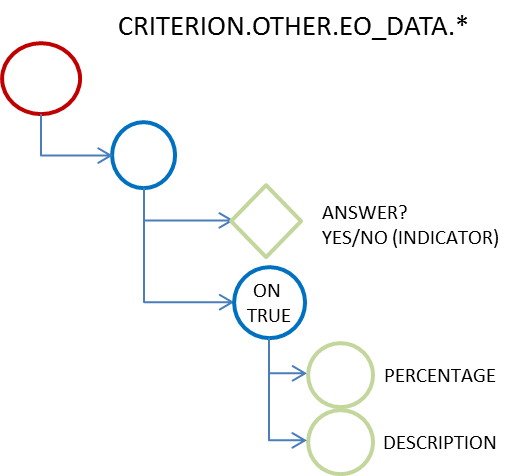
The following example, below, illustrates how this criterion is implemented.
This XML piece, as for all the previous XML examples, was generated by the ESPD Service.
An XML example for the criterion … Is the economic operator a sheltered workshop … from the group CRITERION.OTHER.EO_DATA.* is given below.
<ccv:Criterion>
<cbc:ID schemeID="CriteriaID" schemeAgencyID="EU-COM-GROW" schemeVersionID="1.0">2043338f-a38a-490b-b3ec-2607cb25a017</cbc:ID>
<cbc:TypeCode listID="CriteriaTypeCode" listAgencyID="EU-COM-GROW" listVersionID="1.0.2">CRITERION.OTHER.EO_DATA.SHELTERED_WORKSHOP</cbc:TypeCode>
<cbc:Name>Procurement reserved</cbc:Name>
<cbc:Description>Only in case the procurement is reserved: is the economic operator a sheltered workshop, a 'social business' or will it provide for the performance of the contract in the context of sheltered employment programmes?</cbc:Description>
<ccv:RequirementGroup>
<cbc:ID schemeAgencyID="EU-COM-GROW" schemeVersionID="1.0">6febbe4a-e715-427c-a2b1-19cfabadaef0</cbc:ID>
<ccv:Requirement responseDataType="INDICATOR">
<cbc:ID schemeID="CriterionRelatedIDs" schemeAgencyID="EU-COM-GROW" schemeVersionID="1.0">7f18c64e-ae09-4646-9400-f3666d50af51</cbc:ID>
<ccv:Response>
<ccv-cbc:Indicator>true</ccv-cbc:Indicator>
</ccv:Response>
</ccv:Requirement>
<ccv:RequirementGroup pi="GROUP_FULFILLED.ON_TRUE">
<cbc:ID schemeAgencyID="EU-COM-GROW" schemeVersionID="1.0">a5e33369-e2b5-45f7-9969-ddb1c3ae17c8</cbc:ID>
<ccv:Requirement responseDataType="PERCENTAGE">
<cbc:ID schemeID="CriterionRelatedIDs" schemeAgencyID="EU-COM-GROW" schemeVersionID="1.0">4e552658-d532-4770-943b-b90efcc9788d</cbc:ID>
<cbc:Description>What is the corresponding percentage of disabled or disadvantaged workers?</cbc:Description>
<ccv:Response>
<cbc:Percent>2.0</cbc:Percent>
</ccv:Response>
</ccv:Requirement>
<ccv:Requirement responseDataType="DESCRIPTION">
<cbc:ID schemeID="CriterionRelatedIDs" schemeAgencyID="EU-COM-GROW" schemeVersionID="1.0">e01d0929-c7a9-455a-aaf9-e1f7cd966336</cbc:ID>
<cbc:Description>If required, please provide details on whether the employees concerned belong to a specific category of disabled or disadvantaged workers?</cbc:Description>
<ccv:Response>
<cbc:Description>Physical Disabilities</cbc:Description>
</ccv:Response>
</ccv:Requirement>
</ccv:RequirementGroup>
</ccv:RequirementGroup>
</ccv:Criterion>
|
Release Notes
v1.0.1
The eu.europa.ec.grow.espd.exchange-model Java library was deployed to Maven Central on the 19th of July 2016.
The recommended way to get started using the exchange-model in your Java project is with a dependency management system.
With Maven
<dependency>
<groupId>eu.europa.ec.grow.espd</groupId>
<artifactId>exchange-model</artifactId>
<version>1.0.1</version>
</dependency>With Gradle
dependencies {
compile("eu.europa.ec.grow.espd:exchange-model:1.0.1")
}